Strategic Management (MBSA 1213)
VerifiedAdded on 2021/06/07
|45
|11376
|224
AI Summary
Contribute Materials
Your contribution can guide someone’s learning journey. Share your
documents today.
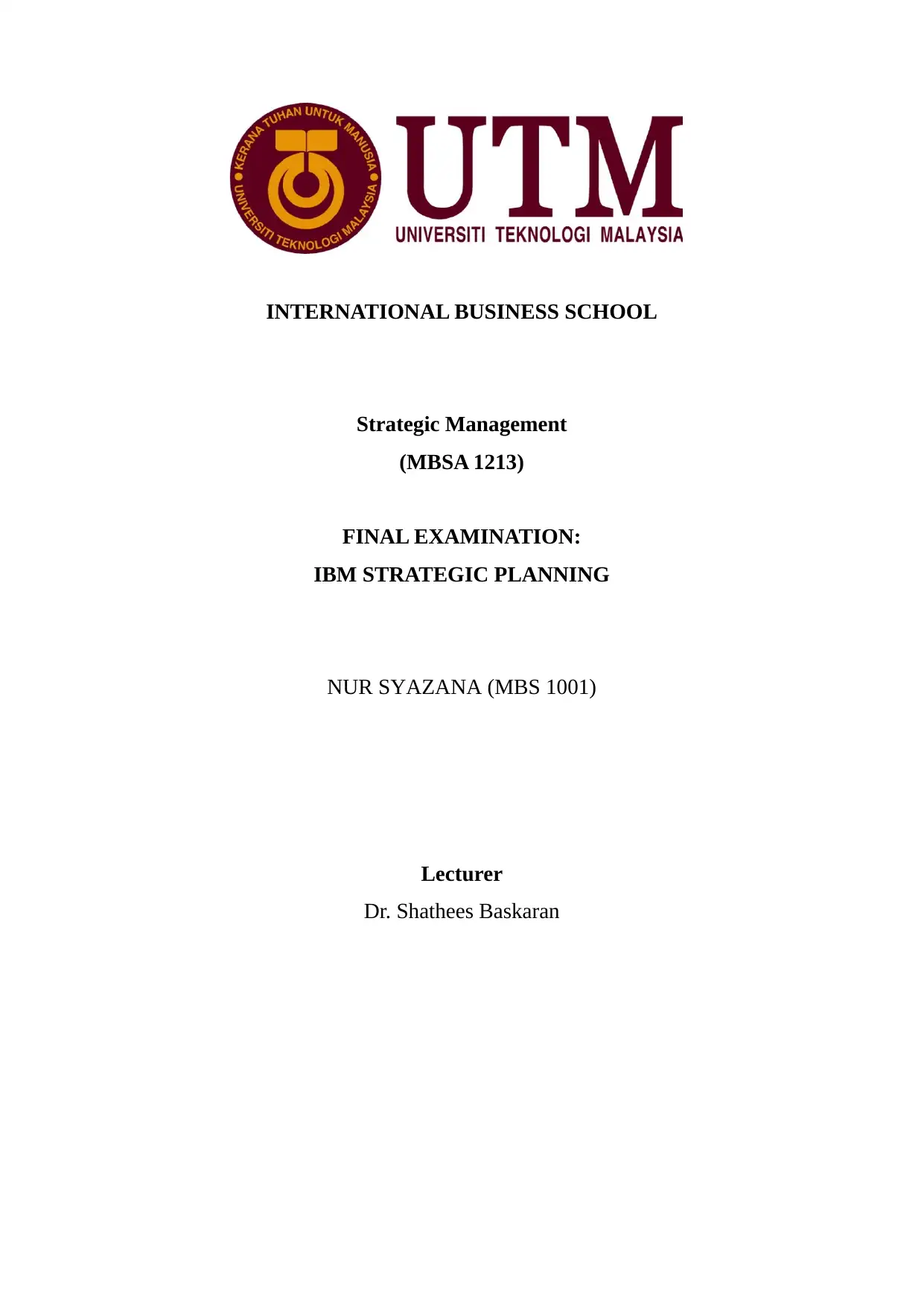
INTERNATIONAL BUSINESS SCHOOL
Strategic Management
(MBSA 1213)
FINAL EXAMINATION:
IBM STRATEGIC PLANNING
NUR SYAZANA (MBS 1001)
Lecturer
Dr. Shathees Baskaran
Strategic Management
(MBSA 1213)
FINAL EXAMINATION:
IBM STRATEGIC PLANNING
NUR SYAZANA (MBS 1001)
Lecturer
Dr. Shathees Baskaran
Secure Best Marks with AI Grader
Need help grading? Try our AI Grader for instant feedback on your assignments.
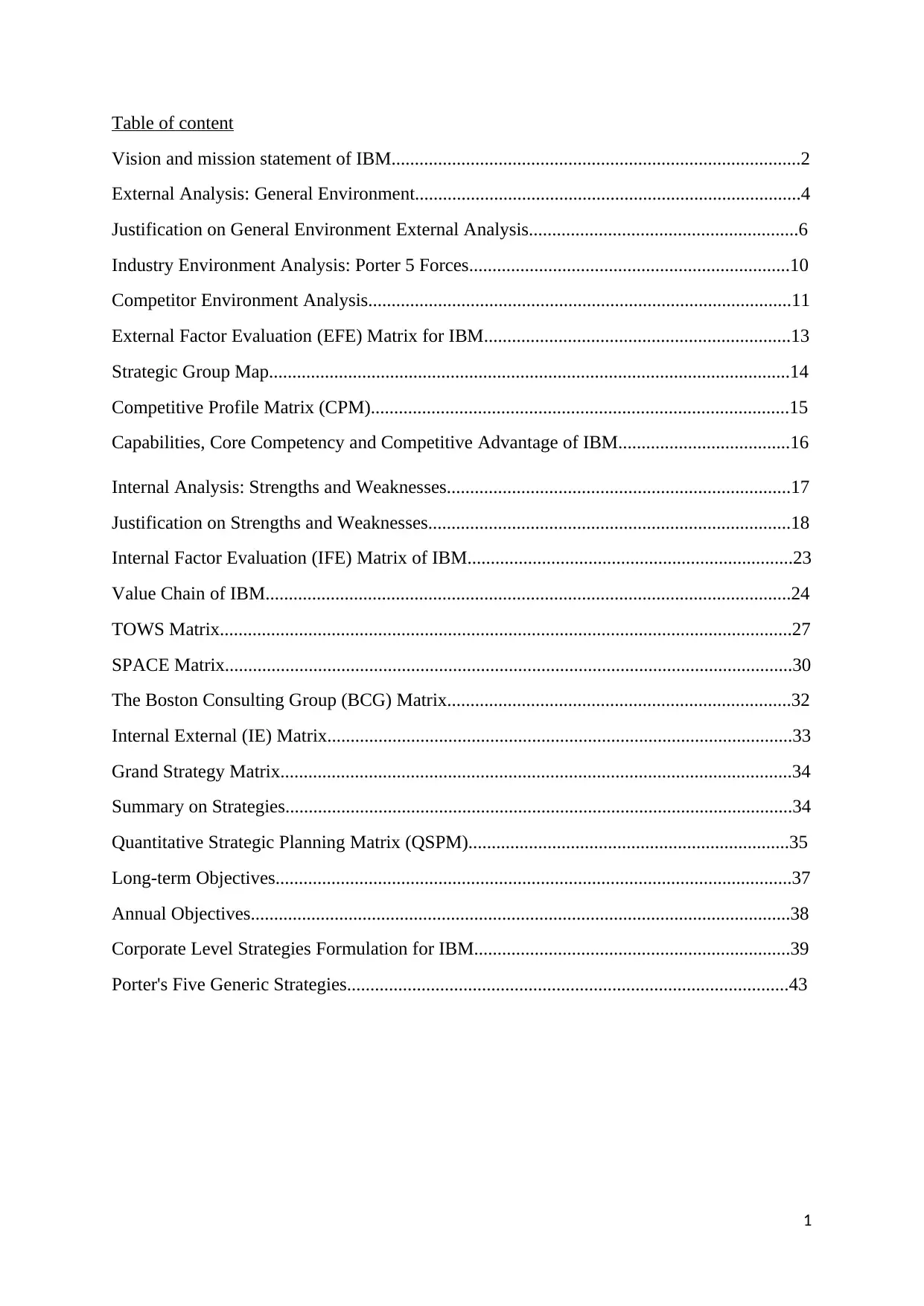
Table of content
Vision and mission statement of IBM........................................................................................2
External Analysis: General Environment...................................................................................4
Justification on General Environment External Analysis..........................................................6
Industry Environment Analysis: Porter 5 Forces.....................................................................10
Competitor Environment Analysis...........................................................................................11
External Factor Evaluation (EFE) Matrix for IBM..................................................................13
Strategic Group Map................................................................................................................14
Competitive Profile Matrix (CPM)..........................................................................................15
Capabilities, Core Competency and Competitive Advantage of IBM.....................................16
Internal Analysis: Strengths and Weaknesses..........................................................................17
Justification on Strengths and Weaknesses..............................................................................18
Internal Factor Evaluation (IFE) Matrix of IBM......................................................................23
Value Chain of IBM.................................................................................................................24
TOWS Matrix...........................................................................................................................27
SPACE Matrix..........................................................................................................................30
The Boston Consulting Group (BCG) Matrix..........................................................................32
Internal External (IE) Matrix....................................................................................................33
Grand Strategy Matrix..............................................................................................................34
Summary on Strategies.............................................................................................................34
Quantitative Strategic Planning Matrix (QSPM).....................................................................35
Long-term Objectives...............................................................................................................37
Annual Objectives....................................................................................................................38
Corporate Level Strategies Formulation for IBM....................................................................39
Porter's Five Generic Strategies...............................................................................................43
1
Vision and mission statement of IBM........................................................................................2
External Analysis: General Environment...................................................................................4
Justification on General Environment External Analysis..........................................................6
Industry Environment Analysis: Porter 5 Forces.....................................................................10
Competitor Environment Analysis...........................................................................................11
External Factor Evaluation (EFE) Matrix for IBM..................................................................13
Strategic Group Map................................................................................................................14
Competitive Profile Matrix (CPM)..........................................................................................15
Capabilities, Core Competency and Competitive Advantage of IBM.....................................16
Internal Analysis: Strengths and Weaknesses..........................................................................17
Justification on Strengths and Weaknesses..............................................................................18
Internal Factor Evaluation (IFE) Matrix of IBM......................................................................23
Value Chain of IBM.................................................................................................................24
TOWS Matrix...........................................................................................................................27
SPACE Matrix..........................................................................................................................30
The Boston Consulting Group (BCG) Matrix..........................................................................32
Internal External (IE) Matrix....................................................................................................33
Grand Strategy Matrix..............................................................................................................34
Summary on Strategies.............................................................................................................34
Quantitative Strategic Planning Matrix (QSPM).....................................................................35
Long-term Objectives...............................................................................................................37
Annual Objectives....................................................................................................................38
Corporate Level Strategies Formulation for IBM....................................................................39
Porter's Five Generic Strategies...............................................................................................43
1
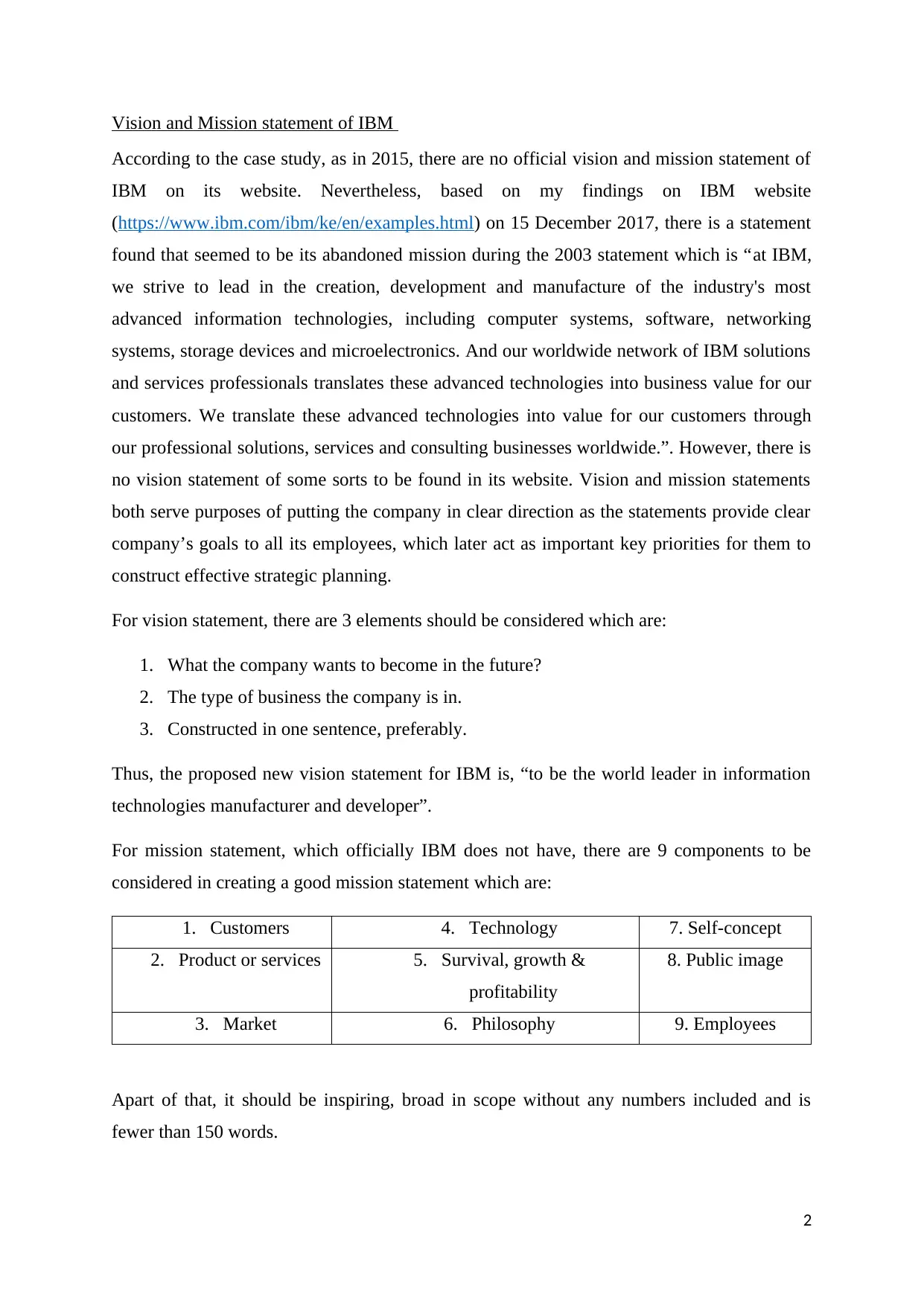
Vision and Mission statement of IBM
According to the case study, as in 2015, there are no official vision and mission statement of
IBM on its website. Nevertheless, based on my findings on IBM website
(https://www.ibm.com/ibm/ke/en/examples.html) on 15 December 2017, there is a statement
found that seemed to be its abandoned mission during the 2003 statement which is “at IBM,
we strive to lead in the creation, development and manufacture of the industry's most
advanced information technologies, including computer systems, software, networking
systems, storage devices and microelectronics. And our worldwide network of IBM solutions
and services professionals translates these advanced technologies into business value for our
customers. We translate these advanced technologies into value for our customers through
our professional solutions, services and consulting businesses worldwide.”. However, there is
no vision statement of some sorts to be found in its website. Vision and mission statements
both serve purposes of putting the company in clear direction as the statements provide clear
company’s goals to all its employees, which later act as important key priorities for them to
construct effective strategic planning.
For vision statement, there are 3 elements should be considered which are:
1. What the company wants to become in the future?
2. The type of business the company is in.
3. Constructed in one sentence, preferably.
Thus, the proposed new vision statement for IBM is, “to be the world leader in information
technologies manufacturer and developer”.
For mission statement, which officially IBM does not have, there are 9 components to be
considered in creating a good mission statement which are:
1. Customers 4. Technology 7. Self-concept
2. Product or services 5. Survival, growth &
profitability
8. Public image
3. Market 6. Philosophy 9. Employees
Apart of that, it should be inspiring, broad in scope without any numbers included and is
fewer than 150 words.
2
According to the case study, as in 2015, there are no official vision and mission statement of
IBM on its website. Nevertheless, based on my findings on IBM website
(https://www.ibm.com/ibm/ke/en/examples.html) on 15 December 2017, there is a statement
found that seemed to be its abandoned mission during the 2003 statement which is “at IBM,
we strive to lead in the creation, development and manufacture of the industry's most
advanced information technologies, including computer systems, software, networking
systems, storage devices and microelectronics. And our worldwide network of IBM solutions
and services professionals translates these advanced technologies into business value for our
customers. We translate these advanced technologies into value for our customers through
our professional solutions, services and consulting businesses worldwide.”. However, there is
no vision statement of some sorts to be found in its website. Vision and mission statements
both serve purposes of putting the company in clear direction as the statements provide clear
company’s goals to all its employees, which later act as important key priorities for them to
construct effective strategic planning.
For vision statement, there are 3 elements should be considered which are:
1. What the company wants to become in the future?
2. The type of business the company is in.
3. Constructed in one sentence, preferably.
Thus, the proposed new vision statement for IBM is, “to be the world leader in information
technologies manufacturer and developer”.
For mission statement, which officially IBM does not have, there are 9 components to be
considered in creating a good mission statement which are:
1. Customers 4. Technology 7. Self-concept
2. Product or services 5. Survival, growth &
profitability
8. Public image
3. Market 6. Philosophy 9. Employees
Apart of that, it should be inspiring, broad in scope without any numbers included and is
fewer than 150 words.
2
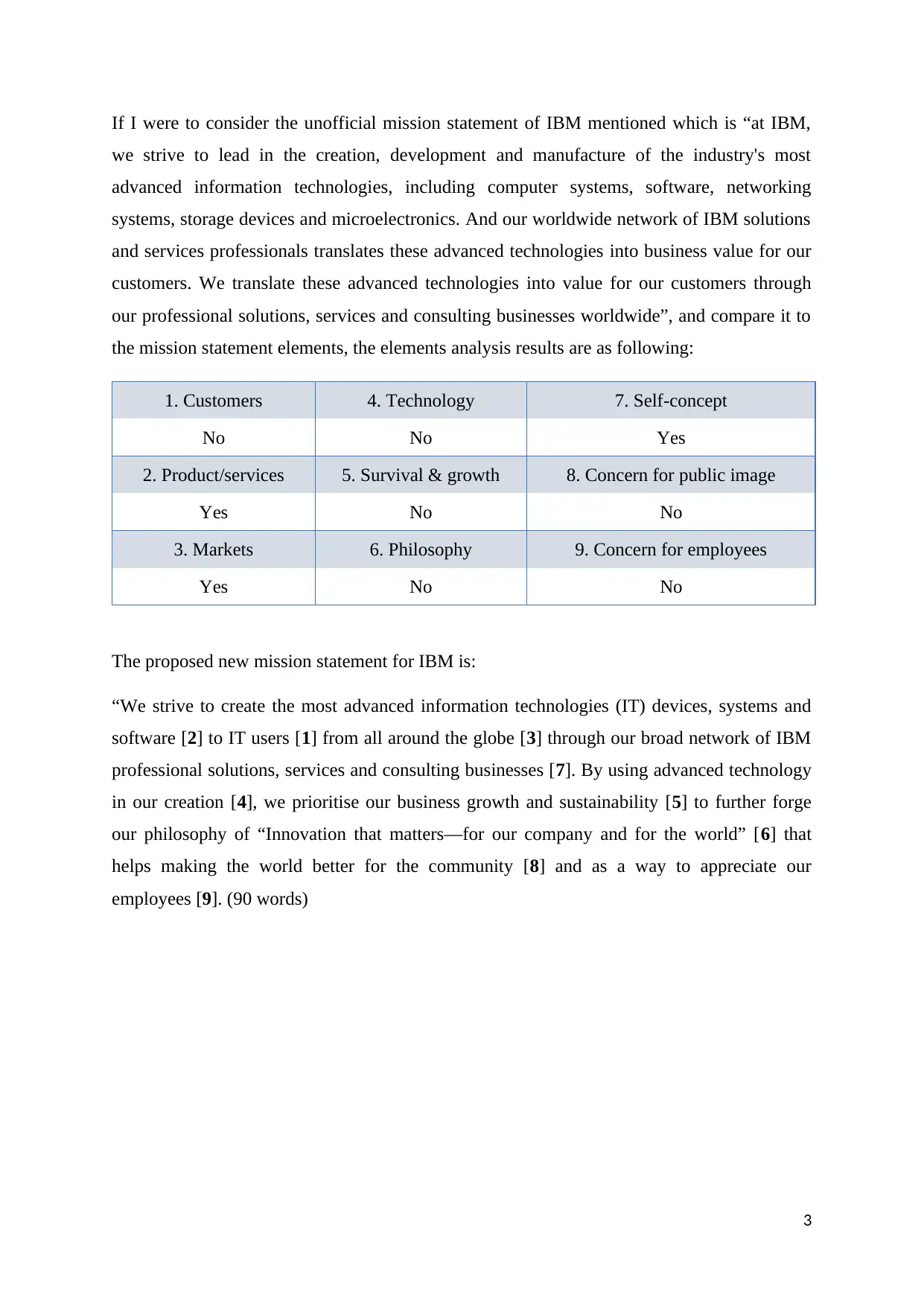
If I were to consider the unofficial mission statement of IBM mentioned which is “at IBM,
we strive to lead in the creation, development and manufacture of the industry's most
advanced information technologies, including computer systems, software, networking
systems, storage devices and microelectronics. And our worldwide network of IBM solutions
and services professionals translates these advanced technologies into business value for our
customers. We translate these advanced technologies into value for our customers through
our professional solutions, services and consulting businesses worldwide”, and compare it to
the mission statement elements, the elements analysis results are as following:
1. Customers 4. Technology 7. Self-concept
No No Yes
2. Product/services 5. Survival & growth 8. Concern for public image
Yes No No
3. Markets 6. Philosophy 9. Concern for employees
Yes No No
The proposed new mission statement for IBM is:
“We strive to create the most advanced information technologies (IT) devices, systems and
software [2] to IT users [1] from all around the globe [3] through our broad network of IBM
professional solutions, services and consulting businesses [7]. By using advanced technology
in our creation [4], we prioritise our business growth and sustainability [5] to further forge
our philosophy of “Innovation that matters—for our company and for the world” [6] that
helps making the world better for the community [8] and as a way to appreciate our
employees [9]. (90 words)
3
we strive to lead in the creation, development and manufacture of the industry's most
advanced information technologies, including computer systems, software, networking
systems, storage devices and microelectronics. And our worldwide network of IBM solutions
and services professionals translates these advanced technologies into business value for our
customers. We translate these advanced technologies into value for our customers through
our professional solutions, services and consulting businesses worldwide”, and compare it to
the mission statement elements, the elements analysis results are as following:
1. Customers 4. Technology 7. Self-concept
No No Yes
2. Product/services 5. Survival & growth 8. Concern for public image
Yes No No
3. Markets 6. Philosophy 9. Concern for employees
Yes No No
The proposed new mission statement for IBM is:
“We strive to create the most advanced information technologies (IT) devices, systems and
software [2] to IT users [1] from all around the globe [3] through our broad network of IBM
professional solutions, services and consulting businesses [7]. By using advanced technology
in our creation [4], we prioritise our business growth and sustainability [5] to further forge
our philosophy of “Innovation that matters—for our company and for the world” [6] that
helps making the world better for the community [8] and as a way to appreciate our
employees [9]. (90 words)
3
Secure Best Marks with AI Grader
Need help grading? Try our AI Grader for instant feedback on your assignments.
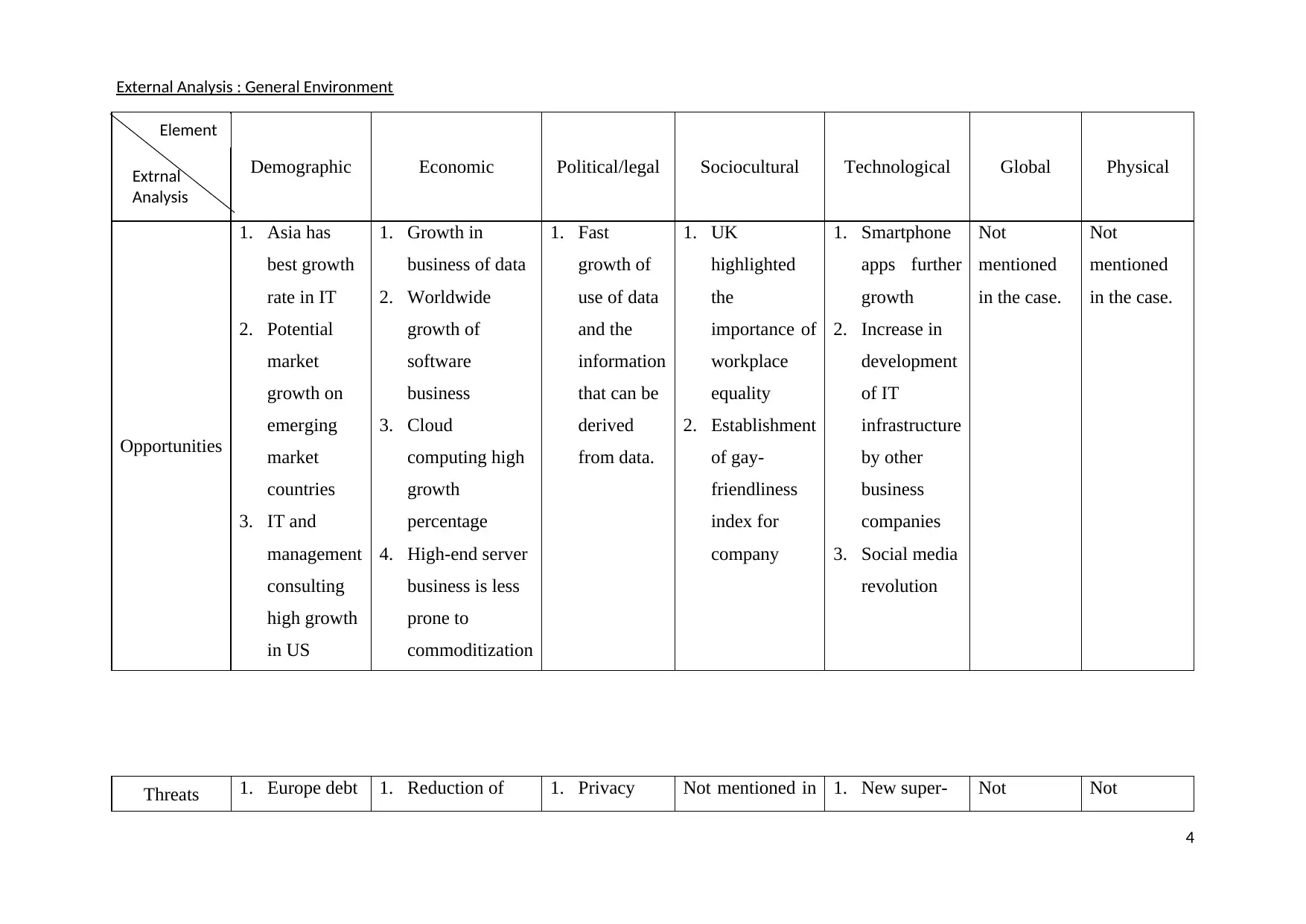
Demographic Economic Political/legal Sociocultural Technological Global Physical
Opportunities
1. Asia has
best growth
rate in IT
2. Potential
market
growth on
emerging
market
countries
3. IT and
management
consulting
high growth
in US
1. Growth in
business of data
2. Worldwide
growth of
software
business
3. Cloud
computing high
growth
percentage
4. High-end server
business is less
prone to
commoditization
1. Fast
growth of
use of data
and the
information
that can be
derived
from data.
1. UK
highlighted
the
importance of
workplace
equality
2. Establishment
of gay-
friendliness
index for
company
1. Smartphone
apps further
growth
2. Increase in
development
of IT
infrastructure
by other
business
companies
3. Social media
revolution
Not
mentioned
in the case.
Not
mentioned
in the case.
Threats 1. Europe debt 1. Reduction of 1. Privacy Not mentioned in 1. New super- Not Not
4
Element
Extrnal
Analysis
External Analysis : General Environment
Opportunities
1. Asia has
best growth
rate in IT
2. Potential
market
growth on
emerging
market
countries
3. IT and
management
consulting
high growth
in US
1. Growth in
business of data
2. Worldwide
growth of
software
business
3. Cloud
computing high
growth
percentage
4. High-end server
business is less
prone to
commoditization
1. Fast
growth of
use of data
and the
information
that can be
derived
from data.
1. UK
highlighted
the
importance of
workplace
equality
2. Establishment
of gay-
friendliness
index for
company
1. Smartphone
apps further
growth
2. Increase in
development
of IT
infrastructure
by other
business
companies
3. Social media
revolution
Not
mentioned
in the case.
Not
mentioned
in the case.
Threats 1. Europe debt 1. Reduction of 1. Privacy Not mentioned in 1. New super- Not Not
4
Element
Extrnal
Analysis
External Analysis : General Environment
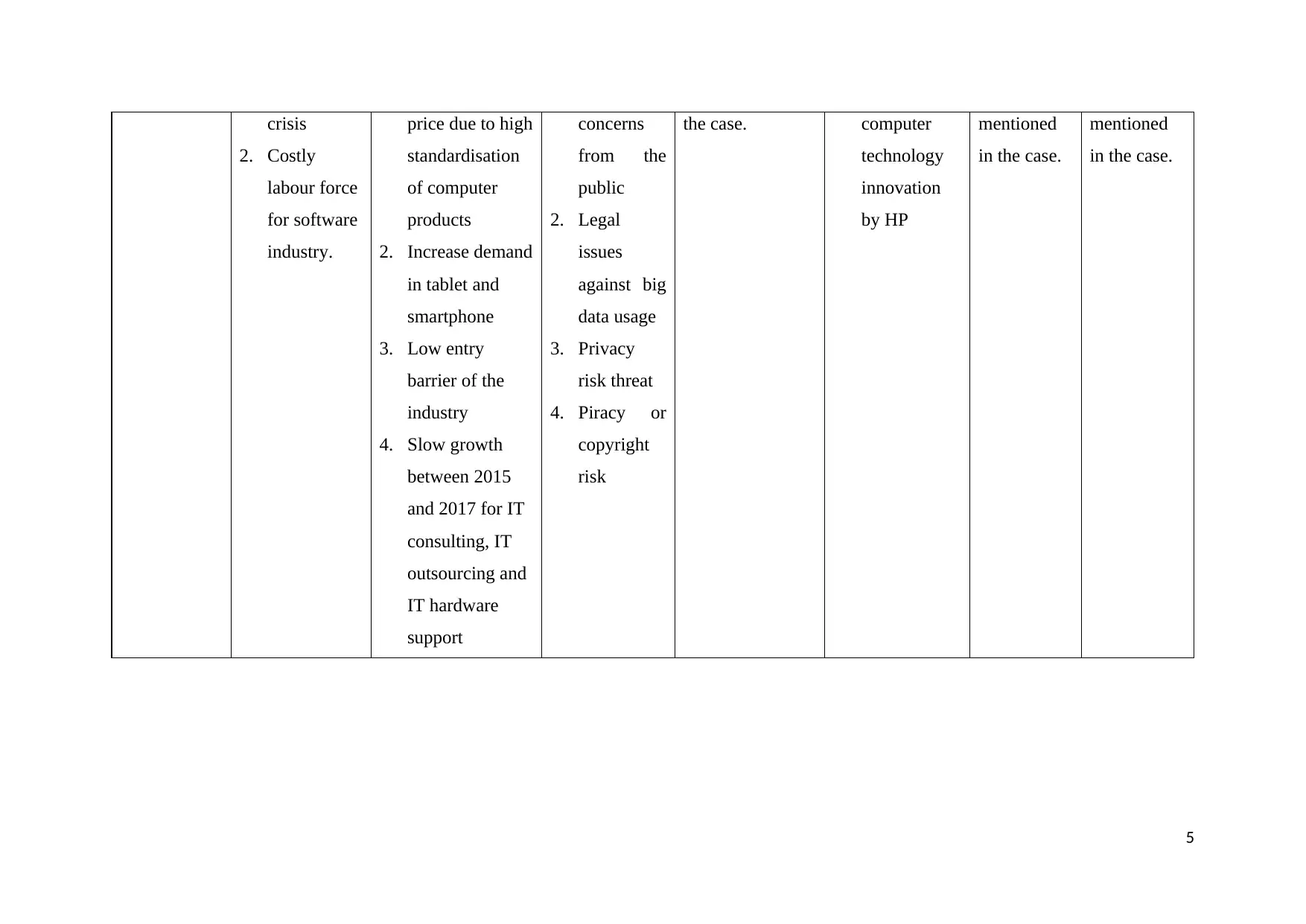
crisis
2. Costly
labour force
for software
industry.
price due to high
standardisation
of computer
products
2. Increase demand
in tablet and
smartphone
3. Low entry
barrier of the
industry
4. Slow growth
between 2015
and 2017 for IT
consulting, IT
outsourcing and
IT hardware
support
concerns
from the
public
2. Legal
issues
against big
data usage
3. Privacy
risk threat
4. Piracy or
copyright
risk
the case. computer
technology
innovation
by HP
mentioned
in the case.
mentioned
in the case.
5
2. Costly
labour force
for software
industry.
price due to high
standardisation
of computer
products
2. Increase demand
in tablet and
smartphone
3. Low entry
barrier of the
industry
4. Slow growth
between 2015
and 2017 for IT
consulting, IT
outsourcing and
IT hardware
support
concerns
from the
public
2. Legal
issues
against big
data usage
3. Privacy
risk threat
4. Piracy or
copyright
risk
the case. computer
technology
innovation
by HP
mentioned
in the case.
mentioned
in the case.
5
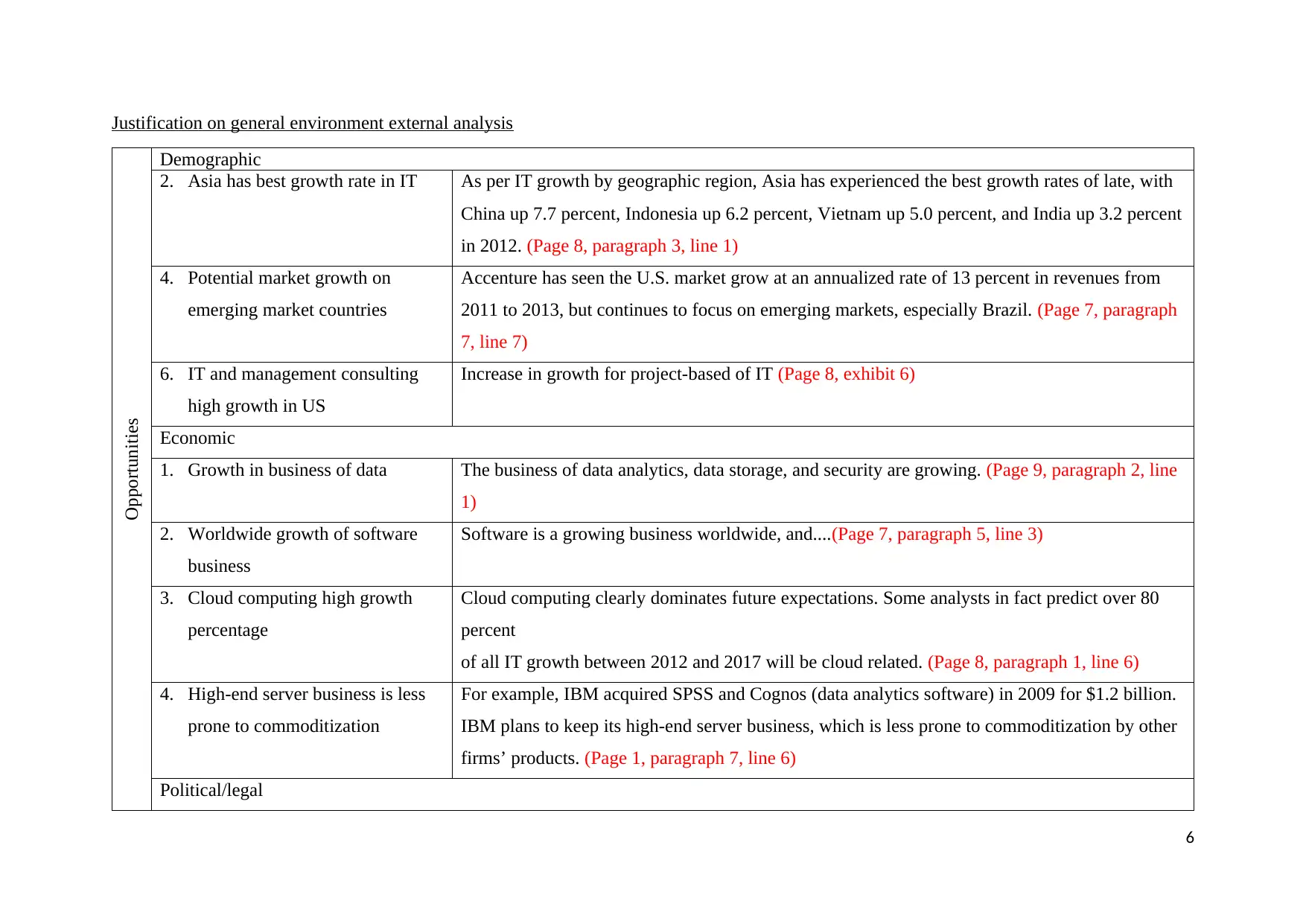
Justification on general environment external analysis
Opportunities
Demographic
2. Asia has best growth rate in IT As per IT growth by geographic region, Asia has experienced the best growth rates of late, with
China up 7.7 percent, Indonesia up 6.2 percent, Vietnam up 5.0 percent, and India up 3.2 percent
in 2012. (Page 8, paragraph 3, line 1)
4. Potential market growth on
emerging market countries
Accenture has seen the U.S. market grow at an annualized rate of 13 percent in revenues from
2011 to 2013, but continues to focus on emerging markets, especially Brazil. (Page 7, paragraph
7, line 7)
6. IT and management consulting
high growth in US
Increase in growth for project-based of IT (Page 8, exhibit 6)
Economic
1. Growth in business of data The business of data analytics, data storage, and security are growing. (Page 9, paragraph 2, line
1)
2. Worldwide growth of software
business
Software is a growing business worldwide, and....(Page 7, paragraph 5, line 3)
3. Cloud computing high growth
percentage
Cloud computing clearly dominates future expectations. Some analysts in fact predict over 80
percent
of all IT growth between 2012 and 2017 will be cloud related. (Page 8, paragraph 1, line 6)
4. High-end server business is less
prone to commoditization
For example, IBM acquired SPSS and Cognos (data analytics software) in 2009 for $1.2 billion.
IBM plans to keep its high-end server business, which is less prone to commoditization by other
firms’ products. (Page 1, paragraph 7, line 6)
Political/legal
6
Opportunities
Demographic
2. Asia has best growth rate in IT As per IT growth by geographic region, Asia has experienced the best growth rates of late, with
China up 7.7 percent, Indonesia up 6.2 percent, Vietnam up 5.0 percent, and India up 3.2 percent
in 2012. (Page 8, paragraph 3, line 1)
4. Potential market growth on
emerging market countries
Accenture has seen the U.S. market grow at an annualized rate of 13 percent in revenues from
2011 to 2013, but continues to focus on emerging markets, especially Brazil. (Page 7, paragraph
7, line 7)
6. IT and management consulting
high growth in US
Increase in growth for project-based of IT (Page 8, exhibit 6)
Economic
1. Growth in business of data The business of data analytics, data storage, and security are growing. (Page 9, paragraph 2, line
1)
2. Worldwide growth of software
business
Software is a growing business worldwide, and....(Page 7, paragraph 5, line 3)
3. Cloud computing high growth
percentage
Cloud computing clearly dominates future expectations. Some analysts in fact predict over 80
percent
of all IT growth between 2012 and 2017 will be cloud related. (Page 8, paragraph 1, line 6)
4. High-end server business is less
prone to commoditization
For example, IBM acquired SPSS and Cognos (data analytics software) in 2009 for $1.2 billion.
IBM plans to keep its high-end server business, which is less prone to commoditization by other
firms’ products. (Page 1, paragraph 7, line 6)
Political/legal
6
Paraphrase This Document
Need a fresh take? Get an instant paraphrase of this document with our AI Paraphraser
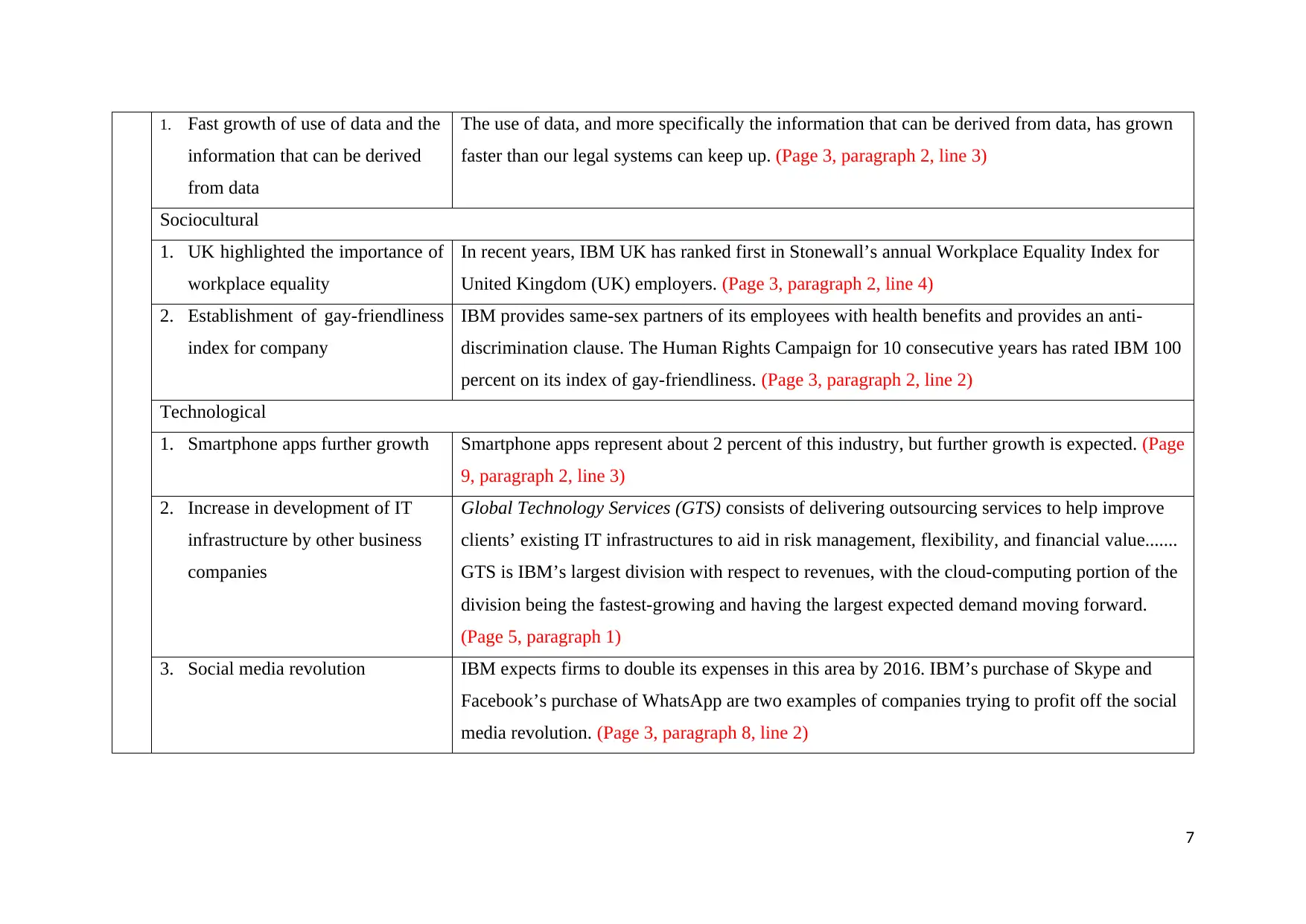
1. Fast growth of use of data and the
information that can be derived
from data
The use of data, and more specifically the information that can be derived from data, has grown
faster than our legal systems can keep up. (Page 3, paragraph 2, line 3)
Sociocultural
1. UK highlighted the importance of
workplace equality
In recent years, IBM UK has ranked first in Stonewall’s annual Workplace Equality Index for
United Kingdom (UK) employers. (Page 3, paragraph 2, line 4)
2. Establishment of gay-friendliness
index for company
IBM provides same-sex partners of its employees with health benefits and provides an anti-
discrimination clause. The Human Rights Campaign for 10 consecutive years has rated IBM 100
percent on its index of gay-friendliness. (Page 3, paragraph 2, line 2)
Technological
1. Smartphone apps further growth Smartphone apps represent about 2 percent of this industry, but further growth is expected. (Page
9, paragraph 2, line 3)
2. Increase in development of IT
infrastructure by other business
companies
Global Technology Services (GTS) consists of delivering outsourcing services to help improve
clients’ existing IT infrastructures to aid in risk management, flexibility, and financial value.......
GTS is IBM’s largest division with respect to revenues, with the cloud-computing portion of the
division being the fastest-growing and having the largest expected demand moving forward.
(Page 5, paragraph 1)
3. Social media revolution IBM expects firms to double its expenses in this area by 2016. IBM’s purchase of Skype and
Facebook’s purchase of WhatsApp are two examples of companies trying to profit off the social
media revolution. (Page 3, paragraph 8, line 2)
7
information that can be derived
from data
The use of data, and more specifically the information that can be derived from data, has grown
faster than our legal systems can keep up. (Page 3, paragraph 2, line 3)
Sociocultural
1. UK highlighted the importance of
workplace equality
In recent years, IBM UK has ranked first in Stonewall’s annual Workplace Equality Index for
United Kingdom (UK) employers. (Page 3, paragraph 2, line 4)
2. Establishment of gay-friendliness
index for company
IBM provides same-sex partners of its employees with health benefits and provides an anti-
discrimination clause. The Human Rights Campaign for 10 consecutive years has rated IBM 100
percent on its index of gay-friendliness. (Page 3, paragraph 2, line 2)
Technological
1. Smartphone apps further growth Smartphone apps represent about 2 percent of this industry, but further growth is expected. (Page
9, paragraph 2, line 3)
2. Increase in development of IT
infrastructure by other business
companies
Global Technology Services (GTS) consists of delivering outsourcing services to help improve
clients’ existing IT infrastructures to aid in risk management, flexibility, and financial value.......
GTS is IBM’s largest division with respect to revenues, with the cloud-computing portion of the
division being the fastest-growing and having the largest expected demand moving forward.
(Page 5, paragraph 1)
3. Social media revolution IBM expects firms to double its expenses in this area by 2016. IBM’s purchase of Skype and
Facebook’s purchase of WhatsApp are two examples of companies trying to profit off the social
media revolution. (Page 3, paragraph 8, line 2)
7
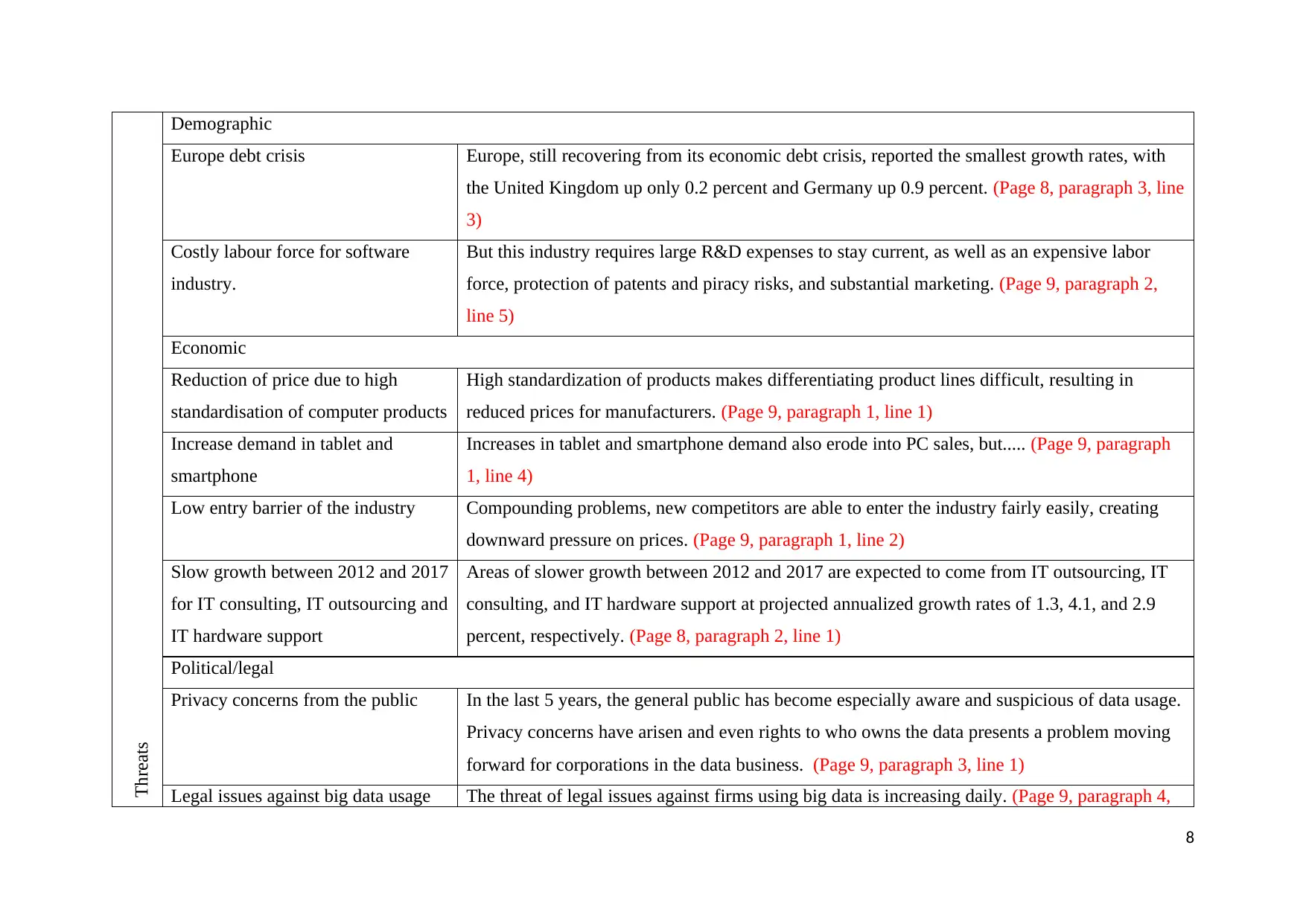
Threats
Demographic
Europe debt crisis Europe, still recovering from its economic debt crisis, reported the smallest growth rates, with
the United Kingdom up only 0.2 percent and Germany up 0.9 percent. (Page 8, paragraph 3, line
3)
Costly labour force for software
industry.
But this industry requires large R&D expenses to stay current, as well as an expensive labor
force, protection of patents and piracy risks, and substantial marketing. (Page 9, paragraph 2,
line 5)
Economic
Reduction of price due to high
standardisation of computer products
High standardization of products makes differentiating product lines difficult, resulting in
reduced prices for manufacturers. (Page 9, paragraph 1, line 1)
Increase demand in tablet and
smartphone
Increases in tablet and smartphone demand also erode into PC sales, but..... (Page 9, paragraph
1, line 4)
Low entry barrier of the industry Compounding problems, new competitors are able to enter the industry fairly easily, creating
downward pressure on prices. (Page 9, paragraph 1, line 2)
Slow growth between 2012 and 2017
for IT consulting, IT outsourcing and
IT hardware support
Areas of slower growth between 2012 and 2017 are expected to come from IT outsourcing, IT
consulting, and IT hardware support at projected annualized growth rates of 1.3, 4.1, and 2.9
percent, respectively. (Page 8, paragraph 2, line 1)
Political/legal
Privacy concerns from the public In the last 5 years, the general public has become especially aware and suspicious of data usage.
Privacy concerns have arisen and even rights to who owns the data presents a problem moving
forward for corporations in the data business. (Page 9, paragraph 3, line 1)
Legal issues against big data usage The threat of legal issues against firms using big data is increasing daily. (Page 9, paragraph 4,
8
Demographic
Europe debt crisis Europe, still recovering from its economic debt crisis, reported the smallest growth rates, with
the United Kingdom up only 0.2 percent and Germany up 0.9 percent. (Page 8, paragraph 3, line
3)
Costly labour force for software
industry.
But this industry requires large R&D expenses to stay current, as well as an expensive labor
force, protection of patents and piracy risks, and substantial marketing. (Page 9, paragraph 2,
line 5)
Economic
Reduction of price due to high
standardisation of computer products
High standardization of products makes differentiating product lines difficult, resulting in
reduced prices for manufacturers. (Page 9, paragraph 1, line 1)
Increase demand in tablet and
smartphone
Increases in tablet and smartphone demand also erode into PC sales, but..... (Page 9, paragraph
1, line 4)
Low entry barrier of the industry Compounding problems, new competitors are able to enter the industry fairly easily, creating
downward pressure on prices. (Page 9, paragraph 1, line 2)
Slow growth between 2012 and 2017
for IT consulting, IT outsourcing and
IT hardware support
Areas of slower growth between 2012 and 2017 are expected to come from IT outsourcing, IT
consulting, and IT hardware support at projected annualized growth rates of 1.3, 4.1, and 2.9
percent, respectively. (Page 8, paragraph 2, line 1)
Political/legal
Privacy concerns from the public In the last 5 years, the general public has become especially aware and suspicious of data usage.
Privacy concerns have arisen and even rights to who owns the data presents a problem moving
forward for corporations in the data business. (Page 9, paragraph 3, line 1)
Legal issues against big data usage The threat of legal issues against firms using big data is increasing daily. (Page 9, paragraph 4,
8
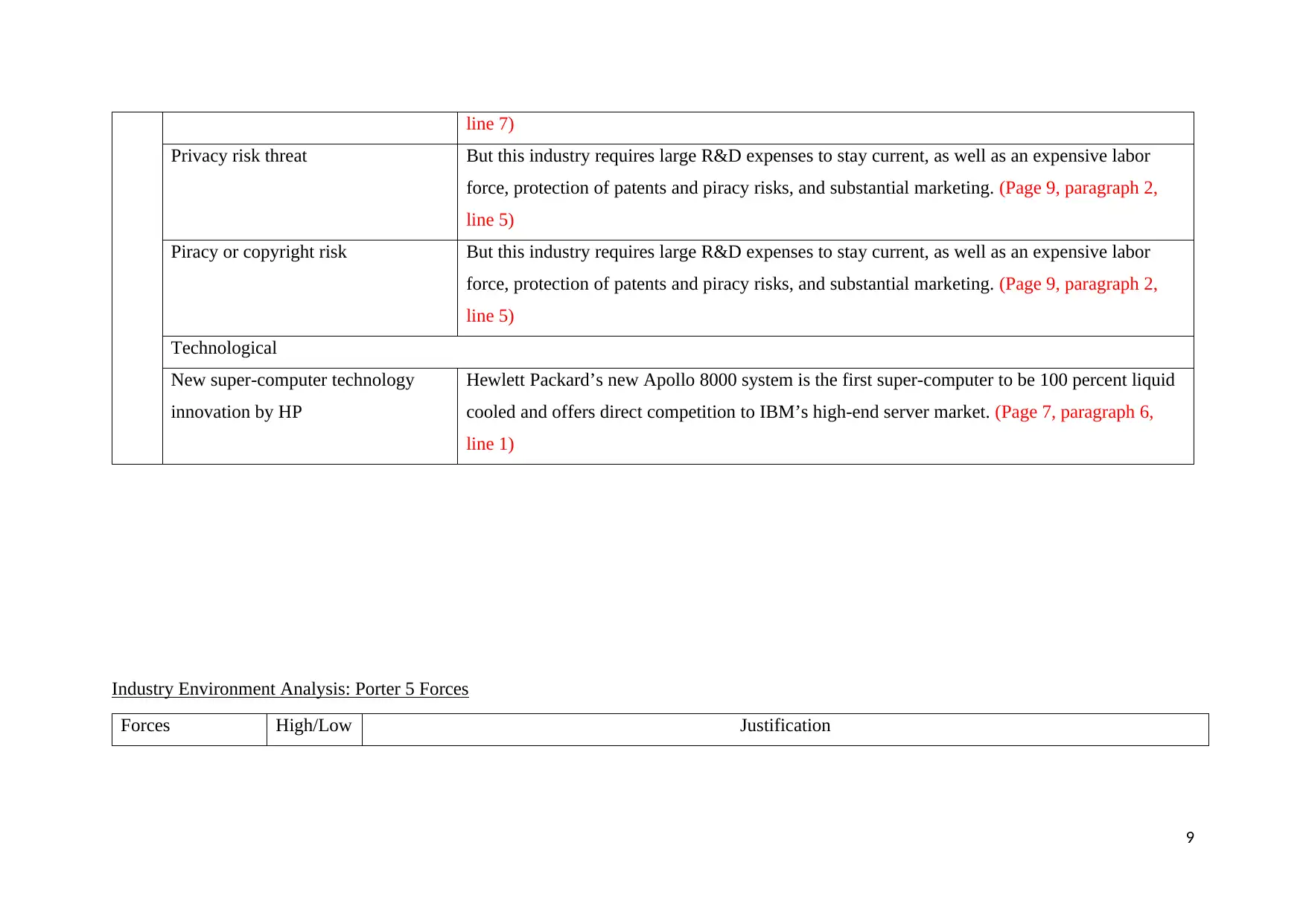
line 7)
Privacy risk threat But this industry requires large R&D expenses to stay current, as well as an expensive labor
force, protection of patents and piracy risks, and substantial marketing. (Page 9, paragraph 2,
line 5)
Piracy or copyright risk But this industry requires large R&D expenses to stay current, as well as an expensive labor
force, protection of patents and piracy risks, and substantial marketing. (Page 9, paragraph 2,
line 5)
Technological
New super-computer technology
innovation by HP
Hewlett Packard’s new Apollo 8000 system is the first super-computer to be 100 percent liquid
cooled and offers direct competition to IBM’s high-end server market. (Page 7, paragraph 6,
line 1)
Industry Environment Analysis: Porter 5 Forces
Forces High/Low Justification
9
Privacy risk threat But this industry requires large R&D expenses to stay current, as well as an expensive labor
force, protection of patents and piracy risks, and substantial marketing. (Page 9, paragraph 2,
line 5)
Piracy or copyright risk But this industry requires large R&D expenses to stay current, as well as an expensive labor
force, protection of patents and piracy risks, and substantial marketing. (Page 9, paragraph 2,
line 5)
Technological
New super-computer technology
innovation by HP
Hewlett Packard’s new Apollo 8000 system is the first super-computer to be 100 percent liquid
cooled and offers direct competition to IBM’s high-end server market. (Page 7, paragraph 6,
line 1)
Industry Environment Analysis: Porter 5 Forces
Forces High/Low Justification
9
Secure Best Marks with AI Grader
Need help grading? Try our AI Grader for instant feedback on your assignments.
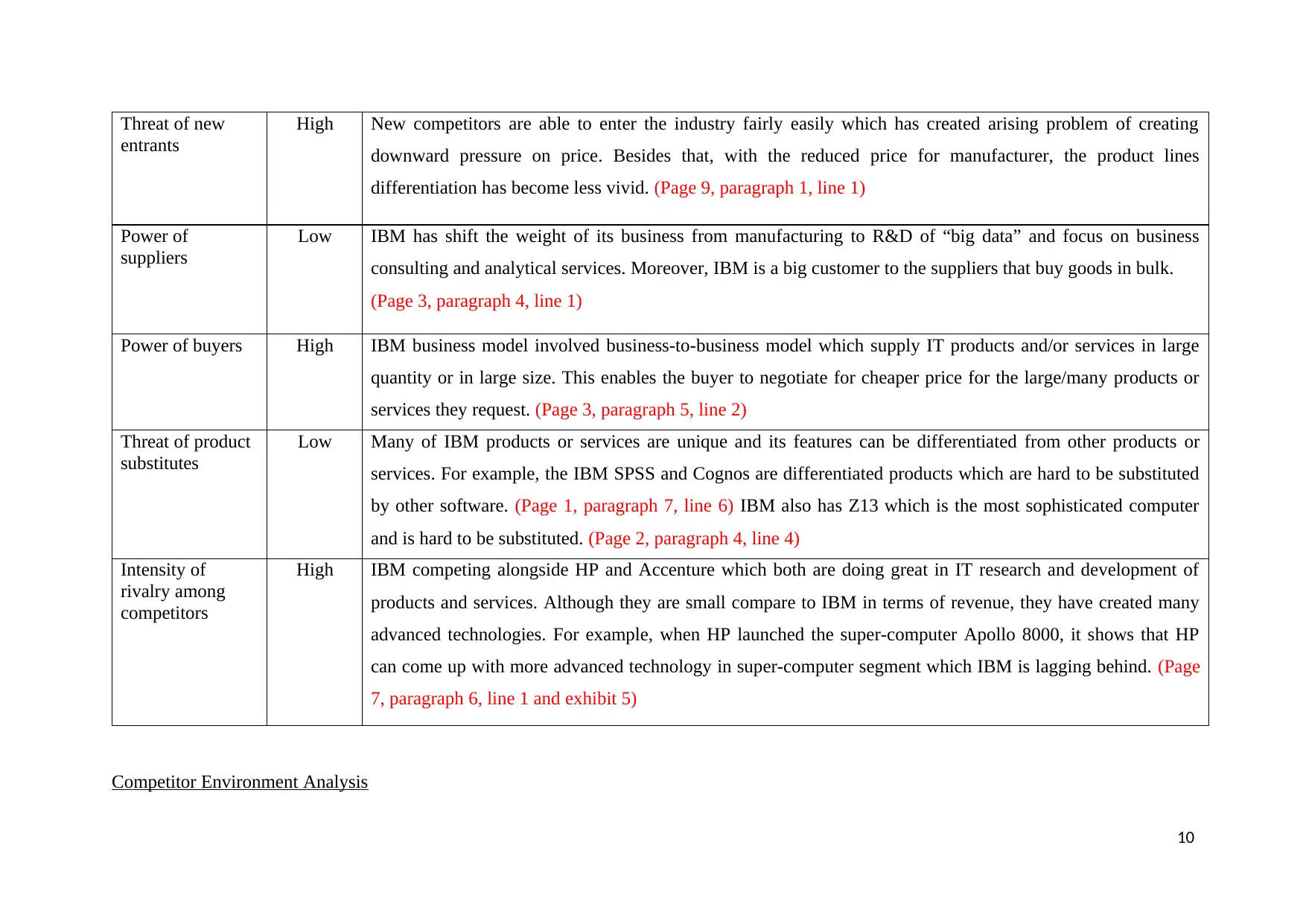
Threat of new
entrants
High New competitors are able to enter the industry fairly easily which has created arising problem of creating
downward pressure on price. Besides that, with the reduced price for manufacturer, the product lines
differentiation has become less vivid. (Page 9, paragraph 1, line 1)
Power of
suppliers
Low IBM has shift the weight of its business from manufacturing to R&D of “big data” and focus on business
consulting and analytical services. Moreover, IBM is a big customer to the suppliers that buy goods in bulk.
(Page 3, paragraph 4, line 1)
Power of buyers High IBM business model involved business-to-business model which supply IT products and/or services in large
quantity or in large size. This enables the buyer to negotiate for cheaper price for the large/many products or
services they request. (Page 3, paragraph 5, line 2)
Threat of product
substitutes
Low Many of IBM products or services are unique and its features can be differentiated from other products or
services. For example, the IBM SPSS and Cognos are differentiated products which are hard to be substituted
by other software. (Page 1, paragraph 7, line 6) IBM also has Z13 which is the most sophisticated computer
and is hard to be substituted. (Page 2, paragraph 4, line 4)
Intensity of
rivalry among
competitors
High IBM competing alongside HP and Accenture which both are doing great in IT research and development of
products and services. Although they are small compare to IBM in terms of revenue, they have created many
advanced technologies. For example, when HP launched the super-computer Apollo 8000, it shows that HP
can come up with more advanced technology in super-computer segment which IBM is lagging behind. (Page
7, paragraph 6, line 1 and exhibit 5)
Competitor Environment Analysis
10
entrants
High New competitors are able to enter the industry fairly easily which has created arising problem of creating
downward pressure on price. Besides that, with the reduced price for manufacturer, the product lines
differentiation has become less vivid. (Page 9, paragraph 1, line 1)
Power of
suppliers
Low IBM has shift the weight of its business from manufacturing to R&D of “big data” and focus on business
consulting and analytical services. Moreover, IBM is a big customer to the suppliers that buy goods in bulk.
(Page 3, paragraph 4, line 1)
Power of buyers High IBM business model involved business-to-business model which supply IT products and/or services in large
quantity or in large size. This enables the buyer to negotiate for cheaper price for the large/many products or
services they request. (Page 3, paragraph 5, line 2)
Threat of product
substitutes
Low Many of IBM products or services are unique and its features can be differentiated from other products or
services. For example, the IBM SPSS and Cognos are differentiated products which are hard to be substituted
by other software. (Page 1, paragraph 7, line 6) IBM also has Z13 which is the most sophisticated computer
and is hard to be substituted. (Page 2, paragraph 4, line 4)
Intensity of
rivalry among
competitors
High IBM competing alongside HP and Accenture which both are doing great in IT research and development of
products and services. Although they are small compare to IBM in terms of revenue, they have created many
advanced technologies. For example, when HP launched the super-computer Apollo 8000, it shows that HP
can come up with more advanced technology in super-computer segment which IBM is lagging behind. (Page
7, paragraph 6, line 1 and exhibit 5)
Competitor Environment Analysis
10
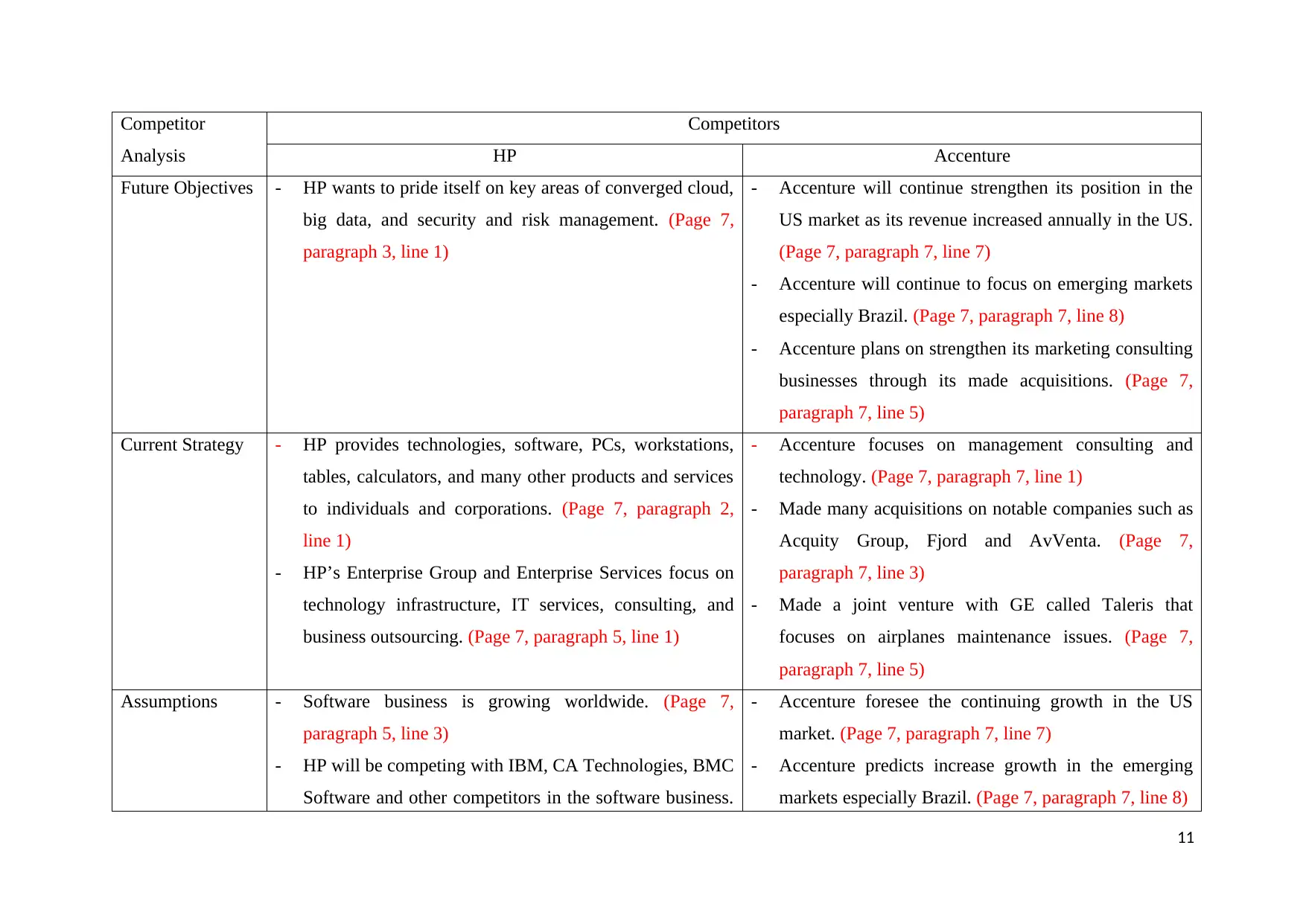
Competitor
Analysis
Competitors
HP Accenture
Future Objectives - HP wants to pride itself on key areas of converged cloud,
big data, and security and risk management. (Page 7,
paragraph 3, line 1)
- Accenture will continue strengthen its position in the
US market as its revenue increased annually in the US.
(Page 7, paragraph 7, line 7)
- Accenture will continue to focus on emerging markets
especially Brazil. (Page 7, paragraph 7, line 8)
- Accenture plans on strengthen its marketing consulting
businesses through its made acquisitions. (Page 7,
paragraph 7, line 5)
Current Strategy - HP provides technologies, software, PCs, workstations,
tables, calculators, and many other products and services
to individuals and corporations. (Page 7, paragraph 2,
line 1)
- HP’s Enterprise Group and Enterprise Services focus on
technology infrastructure, IT services, consulting, and
business outsourcing. (Page 7, paragraph 5, line 1)
- Accenture focuses on management consulting and
technology. (Page 7, paragraph 7, line 1)
- Made many acquisitions on notable companies such as
Acquity Group, Fjord and AvVenta. (Page 7,
paragraph 7, line 3)
- Made a joint venture with GE called Taleris that
focuses on airplanes maintenance issues. (Page 7,
paragraph 7, line 5)
Assumptions - Software business is growing worldwide. (Page 7,
paragraph 5, line 3)
- HP will be competing with IBM, CA Technologies, BMC
Software and other competitors in the software business.
- Accenture foresee the continuing growth in the US
market. (Page 7, paragraph 7, line 7)
- Accenture predicts increase growth in the emerging
markets especially Brazil. (Page 7, paragraph 7, line 8)
11
Analysis
Competitors
HP Accenture
Future Objectives - HP wants to pride itself on key areas of converged cloud,
big data, and security and risk management. (Page 7,
paragraph 3, line 1)
- Accenture will continue strengthen its position in the
US market as its revenue increased annually in the US.
(Page 7, paragraph 7, line 7)
- Accenture will continue to focus on emerging markets
especially Brazil. (Page 7, paragraph 7, line 8)
- Accenture plans on strengthen its marketing consulting
businesses through its made acquisitions. (Page 7,
paragraph 7, line 5)
Current Strategy - HP provides technologies, software, PCs, workstations,
tables, calculators, and many other products and services
to individuals and corporations. (Page 7, paragraph 2,
line 1)
- HP’s Enterprise Group and Enterprise Services focus on
technology infrastructure, IT services, consulting, and
business outsourcing. (Page 7, paragraph 5, line 1)
- Accenture focuses on management consulting and
technology. (Page 7, paragraph 7, line 1)
- Made many acquisitions on notable companies such as
Acquity Group, Fjord and AvVenta. (Page 7,
paragraph 7, line 3)
- Made a joint venture with GE called Taleris that
focuses on airplanes maintenance issues. (Page 7,
paragraph 7, line 5)
Assumptions - Software business is growing worldwide. (Page 7,
paragraph 5, line 3)
- HP will be competing with IBM, CA Technologies, BMC
Software and other competitors in the software business.
- Accenture foresee the continuing growth in the US
market. (Page 7, paragraph 7, line 7)
- Accenture predicts increase growth in the emerging
markets especially Brazil. (Page 7, paragraph 7, line 8)
11
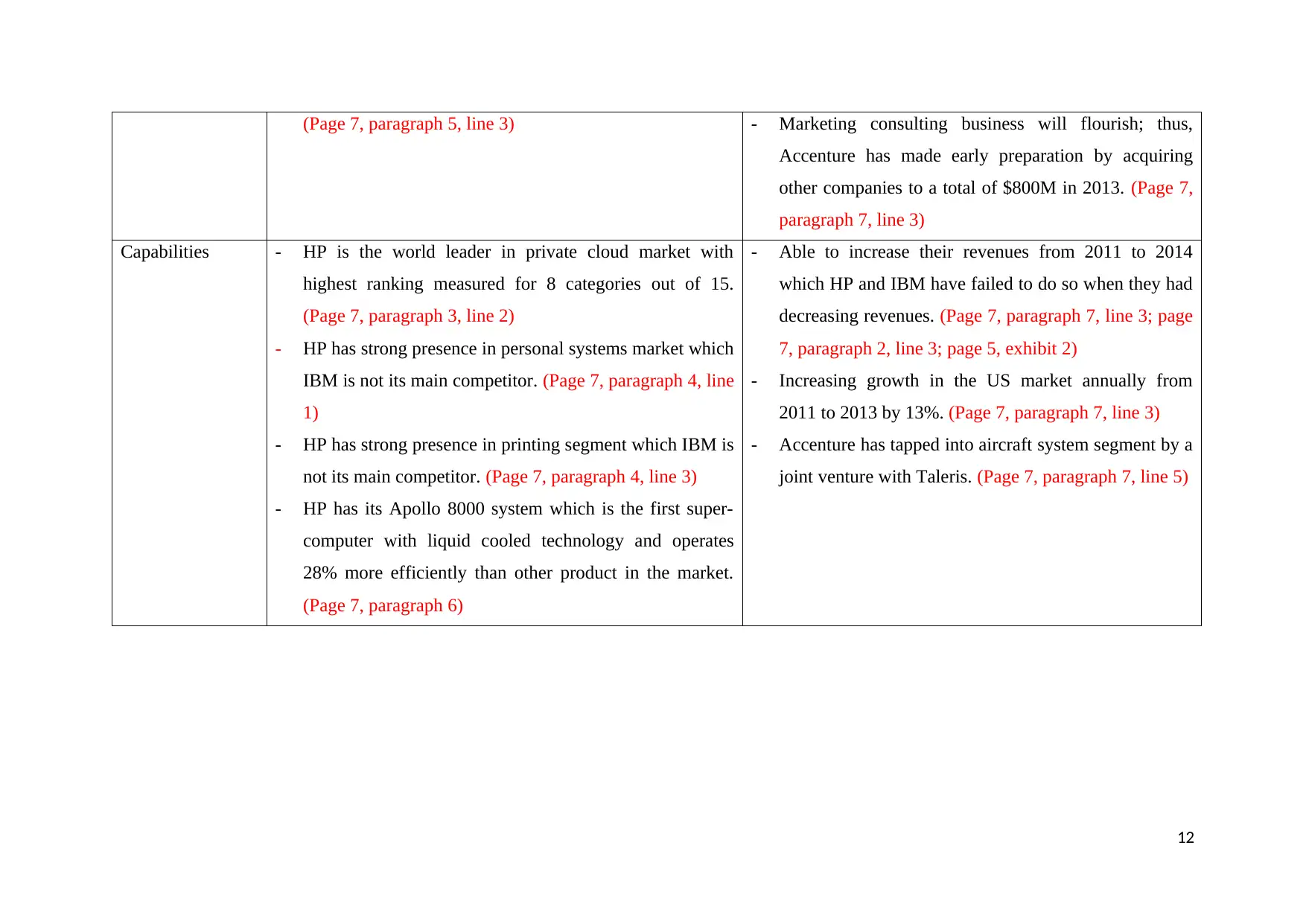
(Page 7, paragraph 5, line 3) - Marketing consulting business will flourish; thus,
Accenture has made early preparation by acquiring
other companies to a total of $800M in 2013. (Page 7,
paragraph 7, line 3)
Capabilities - HP is the world leader in private cloud market with
highest ranking measured for 8 categories out of 15.
(Page 7, paragraph 3, line 2)
- HP has strong presence in personal systems market which
IBM is not its main competitor. (Page 7, paragraph 4, line
1)
- HP has strong presence in printing segment which IBM is
not its main competitor. (Page 7, paragraph 4, line 3)
- HP has its Apollo 8000 system which is the first super-
computer with liquid cooled technology and operates
28% more efficiently than other product in the market.
(Page 7, paragraph 6)
- Able to increase their revenues from 2011 to 2014
which HP and IBM have failed to do so when they had
decreasing revenues. (Page 7, paragraph 7, line 3; page
7, paragraph 2, line 3; page 5, exhibit 2)
- Increasing growth in the US market annually from
2011 to 2013 by 13%. (Page 7, paragraph 7, line 3)
- Accenture has tapped into aircraft system segment by a
joint venture with Taleris. (Page 7, paragraph 7, line 5)
12
Accenture has made early preparation by acquiring
other companies to a total of $800M in 2013. (Page 7,
paragraph 7, line 3)
Capabilities - HP is the world leader in private cloud market with
highest ranking measured for 8 categories out of 15.
(Page 7, paragraph 3, line 2)
- HP has strong presence in personal systems market which
IBM is not its main competitor. (Page 7, paragraph 4, line
1)
- HP has strong presence in printing segment which IBM is
not its main competitor. (Page 7, paragraph 4, line 3)
- HP has its Apollo 8000 system which is the first super-
computer with liquid cooled technology and operates
28% more efficiently than other product in the market.
(Page 7, paragraph 6)
- Able to increase their revenues from 2011 to 2014
which HP and IBM have failed to do so when they had
decreasing revenues. (Page 7, paragraph 7, line 3; page
7, paragraph 2, line 3; page 5, exhibit 2)
- Increasing growth in the US market annually from
2011 to 2013 by 13%. (Page 7, paragraph 7, line 3)
- Accenture has tapped into aircraft system segment by a
joint venture with Taleris. (Page 7, paragraph 7, line 5)
12
Paraphrase This Document
Need a fresh take? Get an instant paraphrase of this document with our AI Paraphraser
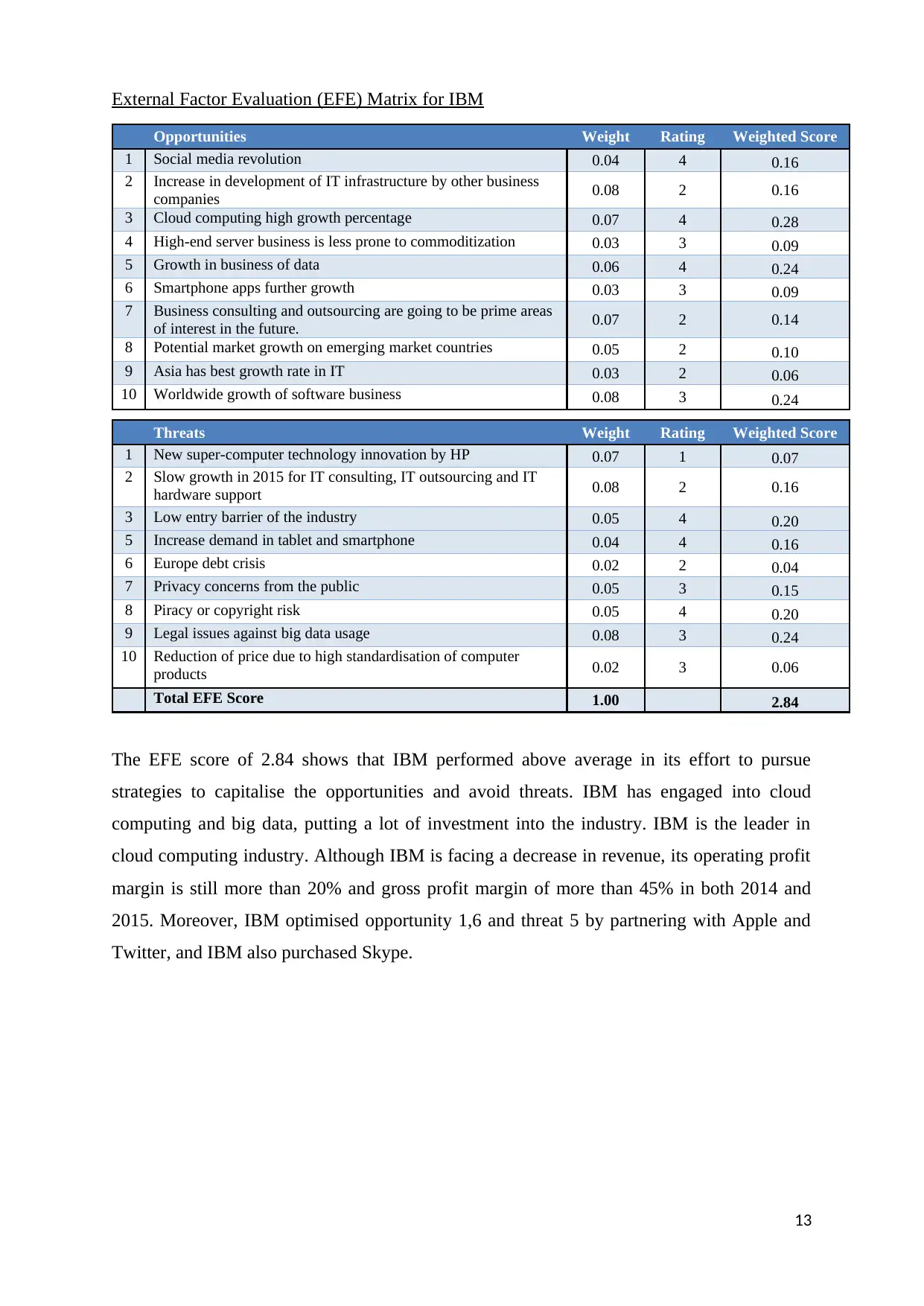
External Factor Evaluation (EFE) Matrix for IBM
Opportunities Weight Rating Weighted Score
1 Social media revolution 0.04 4 0.16
2 Increase in development of IT infrastructure by other business
companies 0.08 2 0.16
3 Cloud computing high growth percentage 0.07 4 0.28
4 High-end server business is less prone to commoditization 0.03 3 0.09
5 Growth in business of data 0.06 4 0.24
6 Smartphone apps further growth 0.03 3 0.09
7 Business consulting and outsourcing are going to be prime areas
of interest in the future. 0.07 2 0.14
8 Potential market growth on emerging market countries 0.05 2 0.10
9 Asia has best growth rate in IT 0.03 2 0.06
10 Worldwide growth of software business 0.08 3 0.24
Threats Weight Rating Weighted Score
1 New super-computer technology innovation by HP 0.07 1 0.07
2 Slow growth in 2015 for IT consulting, IT outsourcing and IT
hardware support 0.08 2 0.16
3 Low entry barrier of the industry 0.05 4 0.20
5 Increase demand in tablet and smartphone 0.04 4 0.16
6 Europe debt crisis 0.02 2 0.04
7 Privacy concerns from the public 0.05 3 0.15
8 Piracy or copyright risk 0.05 4 0.20
9 Legal issues against big data usage 0.08 3 0.24
10 Reduction of price due to high standardisation of computer
products 0.02 3 0.06
Total EFE Score 1.00 2.84
The EFE score of 2.84 shows that IBM performed above average in its effort to pursue
strategies to capitalise the opportunities and avoid threats. IBM has engaged into cloud
computing and big data, putting a lot of investment into the industry. IBM is the leader in
cloud computing industry. Although IBM is facing a decrease in revenue, its operating profit
margin is still more than 20% and gross profit margin of more than 45% in both 2014 and
2015. Moreover, IBM optimised opportunity 1,6 and threat 5 by partnering with Apple and
Twitter, and IBM also purchased Skype.
13
Opportunities Weight Rating Weighted Score
1 Social media revolution 0.04 4 0.16
2 Increase in development of IT infrastructure by other business
companies 0.08 2 0.16
3 Cloud computing high growth percentage 0.07 4 0.28
4 High-end server business is less prone to commoditization 0.03 3 0.09
5 Growth in business of data 0.06 4 0.24
6 Smartphone apps further growth 0.03 3 0.09
7 Business consulting and outsourcing are going to be prime areas
of interest in the future. 0.07 2 0.14
8 Potential market growth on emerging market countries 0.05 2 0.10
9 Asia has best growth rate in IT 0.03 2 0.06
10 Worldwide growth of software business 0.08 3 0.24
Threats Weight Rating Weighted Score
1 New super-computer technology innovation by HP 0.07 1 0.07
2 Slow growth in 2015 for IT consulting, IT outsourcing and IT
hardware support 0.08 2 0.16
3 Low entry barrier of the industry 0.05 4 0.20
5 Increase demand in tablet and smartphone 0.04 4 0.16
6 Europe debt crisis 0.02 2 0.04
7 Privacy concerns from the public 0.05 3 0.15
8 Piracy or copyright risk 0.05 4 0.20
9 Legal issues against big data usage 0.08 3 0.24
10 Reduction of price due to high standardisation of computer
products 0.02 3 0.06
Total EFE Score 1.00 2.84
The EFE score of 2.84 shows that IBM performed above average in its effort to pursue
strategies to capitalise the opportunities and avoid threats. IBM has engaged into cloud
computing and big data, putting a lot of investment into the industry. IBM is the leader in
cloud computing industry. Although IBM is facing a decrease in revenue, its operating profit
margin is still more than 20% and gross profit margin of more than 45% in both 2014 and
2015. Moreover, IBM optimised opportunity 1,6 and threat 5 by partnering with Apple and
Twitter, and IBM also purchased Skype.
13
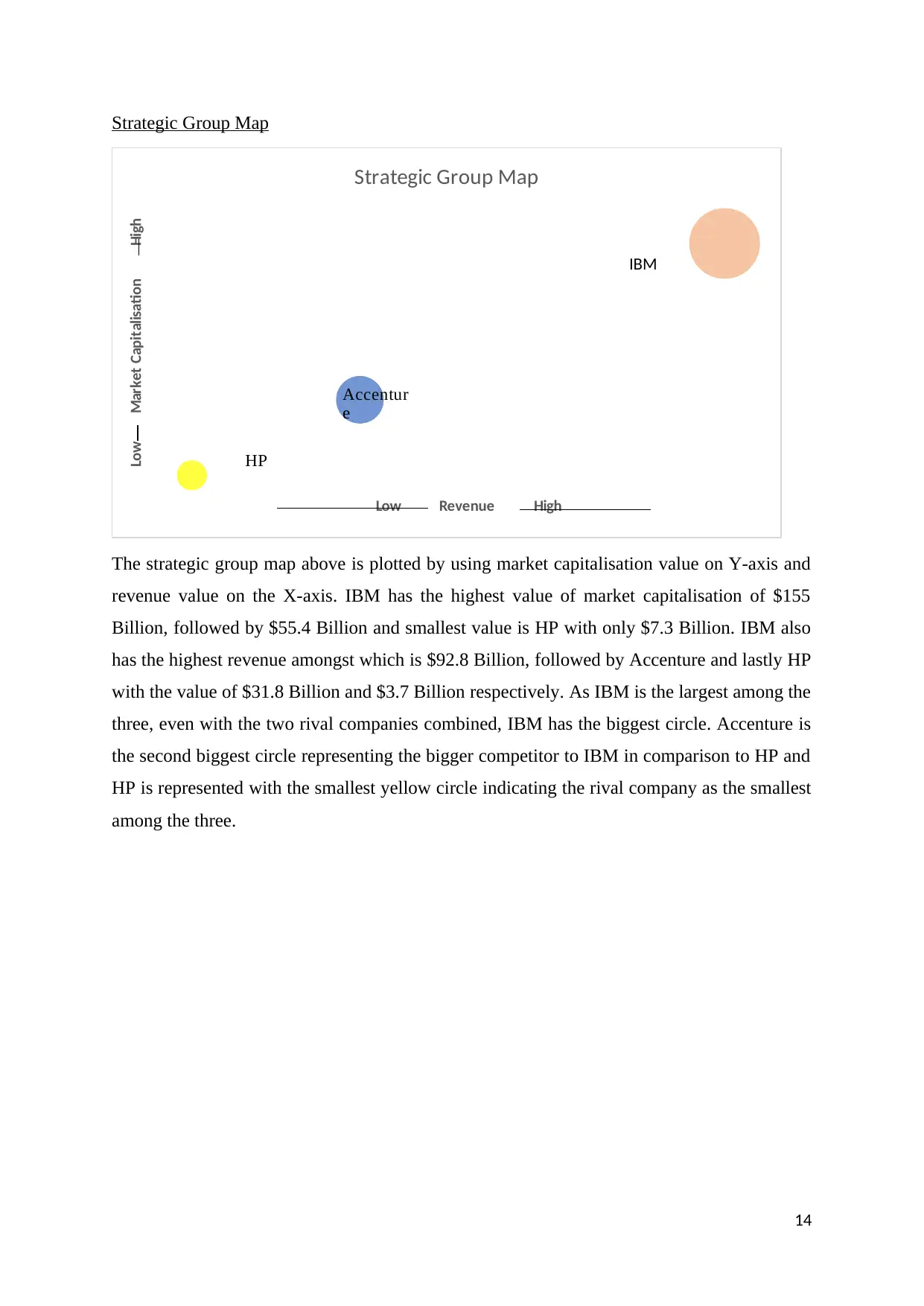
Strategic Group Map
Strategic Group Map
Low Revenue High
Low Market Capitalisation High
HP
Accentur
e
The strategic group map above is plotted by using market capitalisation value on Y-axis and
revenue value on the X-axis. IBM has the highest value of market capitalisation of $155
Billion, followed by $55.4 Billion and smallest value is HP with only $7.3 Billion. IBM also
has the highest revenue amongst which is $92.8 Billion, followed by Accenture and lastly HP
with the value of $31.8 Billion and $3.7 Billion respectively. As IBM is the largest among the
three, even with the two rival companies combined, IBM has the biggest circle. Accenture is
the second biggest circle representing the bigger competitor to IBM in comparison to HP and
HP is represented with the smallest yellow circle indicating the rival company as the smallest
among the three.
14
IBM
Strategic Group Map
Low Revenue High
Low Market Capitalisation High
HP
Accentur
e
The strategic group map above is plotted by using market capitalisation value on Y-axis and
revenue value on the X-axis. IBM has the highest value of market capitalisation of $155
Billion, followed by $55.4 Billion and smallest value is HP with only $7.3 Billion. IBM also
has the highest revenue amongst which is $92.8 Billion, followed by Accenture and lastly HP
with the value of $31.8 Billion and $3.7 Billion respectively. As IBM is the largest among the
three, even with the two rival companies combined, IBM has the biggest circle. Accenture is
the second biggest circle representing the bigger competitor to IBM in comparison to HP and
HP is represented with the smallest yellow circle indicating the rival company as the smallest
among the three.
14
IBM
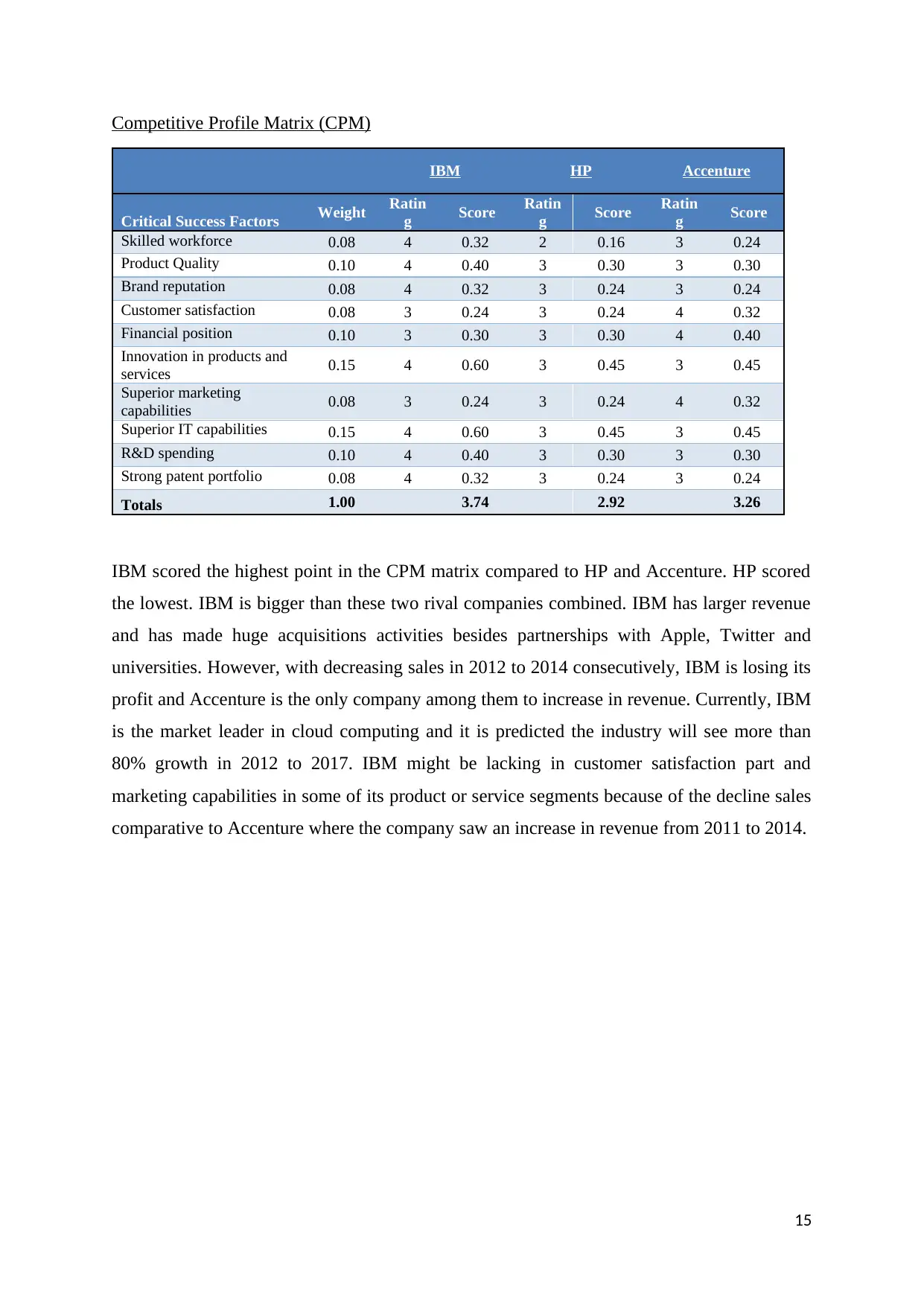
Competitive Profile Matrix (CPM)
IBM HP Accenture
Critical Success Factors Weight Ratin
g Score Ratin
g Score Ratin
g Score
Skilled workforce 0.08 4 0.32 2 0.16 3 0.24
Product Quality 0.10 4 0.40 3 0.30 3 0.30
Brand reputation 0.08 4 0.32 3 0.24 3 0.24
Customer satisfaction 0.08 3 0.24 3 0.24 4 0.32
Financial position 0.10 3 0.30 3 0.30 4 0.40
Innovation in products and
services 0.15 4 0.60 3 0.45 3 0.45
Superior marketing
capabilities 0.08 3 0.24 3 0.24 4 0.32
Superior IT capabilities 0.15 4 0.60 3 0.45 3 0.45
R&D spending 0.10 4 0.40 3 0.30 3 0.30
Strong patent portfolio 0.08 4 0.32 3 0.24 3 0.24
Totals 1.00 3.74 2.92 3.26
IBM scored the highest point in the CPM matrix compared to HP and Accenture. HP scored
the lowest. IBM is bigger than these two rival companies combined. IBM has larger revenue
and has made huge acquisitions activities besides partnerships with Apple, Twitter and
universities. However, with decreasing sales in 2012 to 2014 consecutively, IBM is losing its
profit and Accenture is the only company among them to increase in revenue. Currently, IBM
is the market leader in cloud computing and it is predicted the industry will see more than
80% growth in 2012 to 2017. IBM might be lacking in customer satisfaction part and
marketing capabilities in some of its product or service segments because of the decline sales
comparative to Accenture where the company saw an increase in revenue from 2011 to 2014.
15
IBM HP Accenture
Critical Success Factors Weight Ratin
g Score Ratin
g Score Ratin
g Score
Skilled workforce 0.08 4 0.32 2 0.16 3 0.24
Product Quality 0.10 4 0.40 3 0.30 3 0.30
Brand reputation 0.08 4 0.32 3 0.24 3 0.24
Customer satisfaction 0.08 3 0.24 3 0.24 4 0.32
Financial position 0.10 3 0.30 3 0.30 4 0.40
Innovation in products and
services 0.15 4 0.60 3 0.45 3 0.45
Superior marketing
capabilities 0.08 3 0.24 3 0.24 4 0.32
Superior IT capabilities 0.15 4 0.60 3 0.45 3 0.45
R&D spending 0.10 4 0.40 3 0.30 3 0.30
Strong patent portfolio 0.08 4 0.32 3 0.24 3 0.24
Totals 1.00 3.74 2.92 3.26
IBM scored the highest point in the CPM matrix compared to HP and Accenture. HP scored
the lowest. IBM is bigger than these two rival companies combined. IBM has larger revenue
and has made huge acquisitions activities besides partnerships with Apple, Twitter and
universities. However, with decreasing sales in 2012 to 2014 consecutively, IBM is losing its
profit and Accenture is the only company among them to increase in revenue. Currently, IBM
is the market leader in cloud computing and it is predicted the industry will see more than
80% growth in 2012 to 2017. IBM might be lacking in customer satisfaction part and
marketing capabilities in some of its product or service segments because of the decline sales
comparative to Accenture where the company saw an increase in revenue from 2011 to 2014.
15
Secure Best Marks with AI Grader
Need help grading? Try our AI Grader for instant feedback on your assignments.
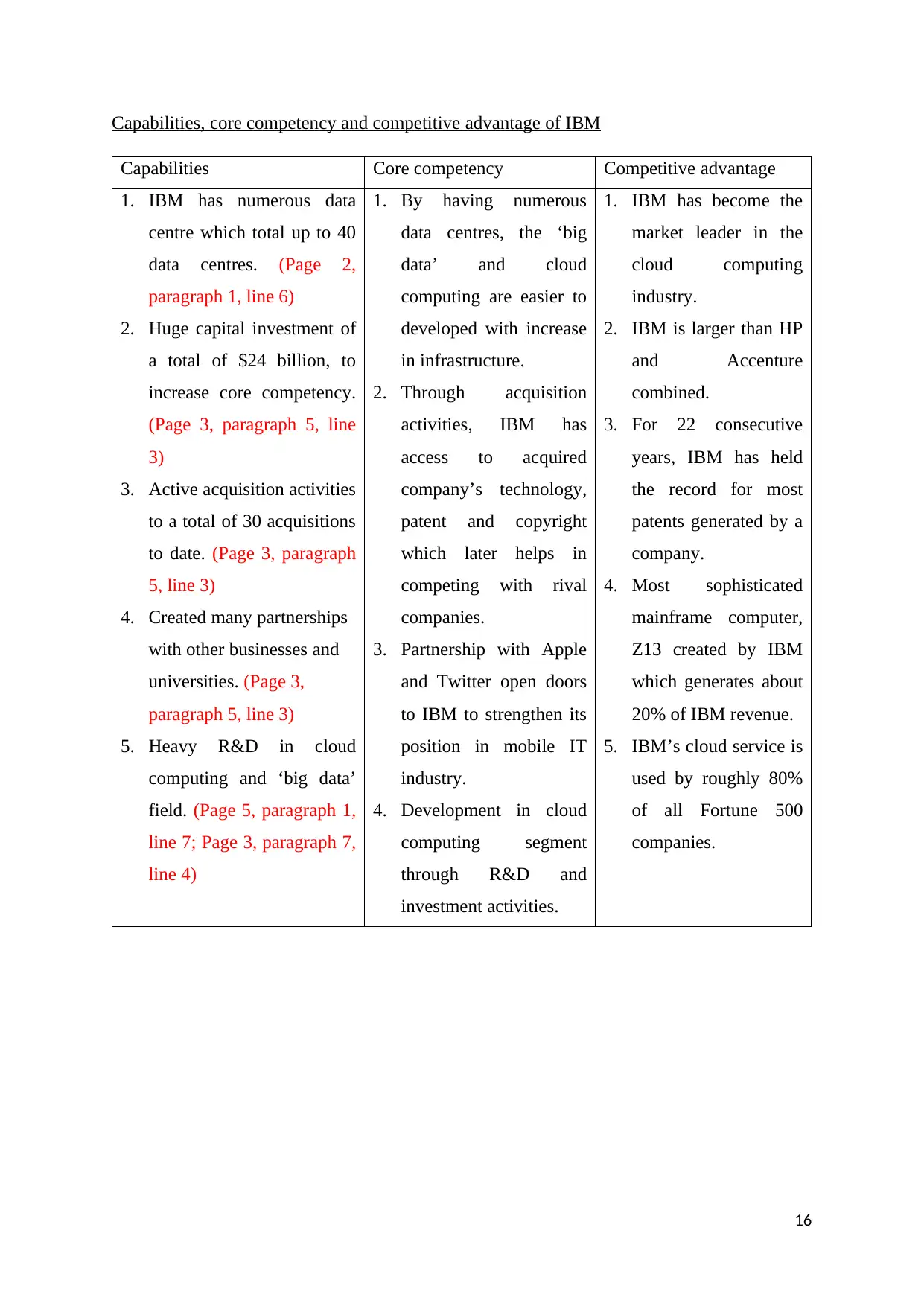
Capabilities, core competency and competitive advantage of IBM
Capabilities Core competency Competitive advantage
1. IBM has numerous data
centre which total up to 40
data centres. (Page 2,
paragraph 1, line 6)
2. Huge capital investment of
a total of $24 billion, to
increase core competency.
(Page 3, paragraph 5, line
3)
3. Active acquisition activities
to a total of 30 acquisitions
to date. (Page 3, paragraph
5, line 3)
4. Created many partnerships
with other businesses and
universities. (Page 3,
paragraph 5, line 3)
5. Heavy R&D in cloud
computing and ‘big data’
field. (Page 5, paragraph 1,
line 7; Page 3, paragraph 7,
line 4)
1. By having numerous
data centres, the ‘big
data’ and cloud
computing are easier to
developed with increase
in infrastructure.
2. Through acquisition
activities, IBM has
access to acquired
company’s technology,
patent and copyright
which later helps in
competing with rival
companies.
3. Partnership with Apple
and Twitter open doors
to IBM to strengthen its
position in mobile IT
industry.
4. Development in cloud
computing segment
through R&D and
investment activities.
1. IBM has become the
market leader in the
cloud computing
industry.
2. IBM is larger than HP
and Accenture
combined.
3. For 22 consecutive
years, IBM has held
the record for most
patents generated by a
company.
4. Most sophisticated
mainframe computer,
Z13 created by IBM
which generates about
20% of IBM revenue.
5. IBM’s cloud service is
used by roughly 80%
of all Fortune 500
companies.
16
Capabilities Core competency Competitive advantage
1. IBM has numerous data
centre which total up to 40
data centres. (Page 2,
paragraph 1, line 6)
2. Huge capital investment of
a total of $24 billion, to
increase core competency.
(Page 3, paragraph 5, line
3)
3. Active acquisition activities
to a total of 30 acquisitions
to date. (Page 3, paragraph
5, line 3)
4. Created many partnerships
with other businesses and
universities. (Page 3,
paragraph 5, line 3)
5. Heavy R&D in cloud
computing and ‘big data’
field. (Page 5, paragraph 1,
line 7; Page 3, paragraph 7,
line 4)
1. By having numerous
data centres, the ‘big
data’ and cloud
computing are easier to
developed with increase
in infrastructure.
2. Through acquisition
activities, IBM has
access to acquired
company’s technology,
patent and copyright
which later helps in
competing with rival
companies.
3. Partnership with Apple
and Twitter open doors
to IBM to strengthen its
position in mobile IT
industry.
4. Development in cloud
computing segment
through R&D and
investment activities.
1. IBM has become the
market leader in the
cloud computing
industry.
2. IBM is larger than HP
and Accenture
combined.
3. For 22 consecutive
years, IBM has held
the record for most
patents generated by a
company.
4. Most sophisticated
mainframe computer,
Z13 created by IBM
which generates about
20% of IBM revenue.
5. IBM’s cloud service is
used by roughly 80%
of all Fortune 500
companies.
16
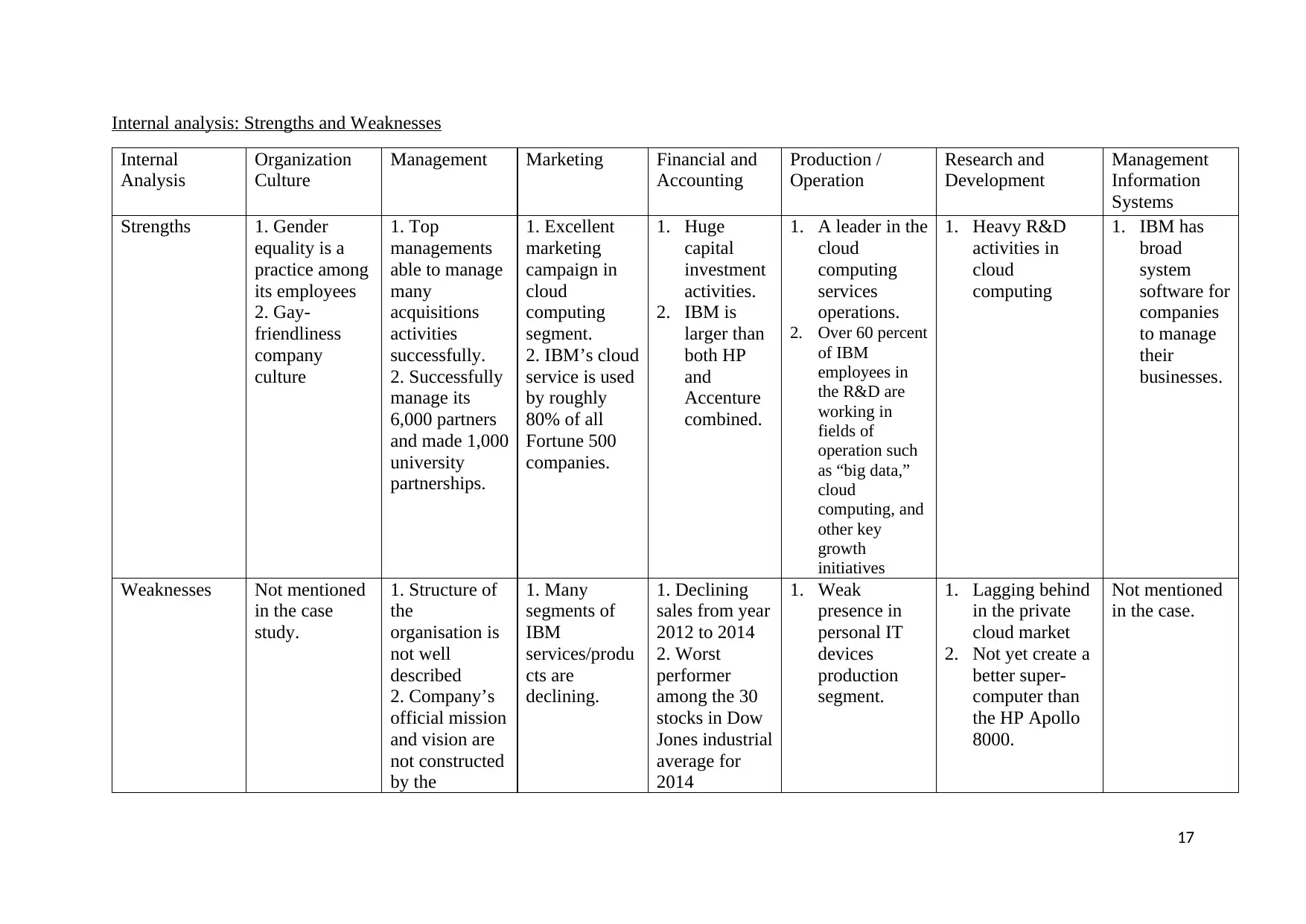
Internal analysis: Strengths and Weaknesses
Internal
Analysis
Organization
Culture
Management Marketing Financial and
Accounting
Production /
Operation
Research and
Development
Management
Information
Systems
Strengths 1. Gender
equality is a
practice among
its employees
2. Gay-
friendliness
company
culture
1. Top
managements
able to manage
many
acquisitions
activities
successfully.
2. Successfully
manage its
6,000 partners
and made 1,000
university
partnerships.
1. Excellent
marketing
campaign in
cloud
computing
segment.
2. IBM’s cloud
service is used
by roughly
80% of all
Fortune 500
companies.
1. Huge
capital
investment
activities.
2. IBM is
larger than
both HP
and
Accenture
combined.
1. A leader in the
cloud
computing
services
operations.
2. Over 60 percent
of IBM
employees in
the R&D are
working in
fields of
operation such
as “big data,”
cloud
computing, and
other key
growth
initiatives
1. Heavy R&D
activities in
cloud
computing
1. IBM has
broad
system
software for
companies
to manage
their
businesses.
Weaknesses Not mentioned
in the case
study.
1. Structure of
the
organisation is
not well
described
2. Company’s
official mission
and vision are
not constructed
by the
1. Many
segments of
IBM
services/produ
cts are
declining.
1. Declining
sales from year
2012 to 2014
2. Worst
performer
among the 30
stocks in Dow
Jones industrial
average for
2014
1. Weak
presence in
personal IT
devices
production
segment.
1. Lagging behind
in the private
cloud market
2. Not yet create a
better super-
computer than
the HP Apollo
8000.
Not mentioned
in the case.
17
Internal
Analysis
Organization
Culture
Management Marketing Financial and
Accounting
Production /
Operation
Research and
Development
Management
Information
Systems
Strengths 1. Gender
equality is a
practice among
its employees
2. Gay-
friendliness
company
culture
1. Top
managements
able to manage
many
acquisitions
activities
successfully.
2. Successfully
manage its
6,000 partners
and made 1,000
university
partnerships.
1. Excellent
marketing
campaign in
cloud
computing
segment.
2. IBM’s cloud
service is used
by roughly
80% of all
Fortune 500
companies.
1. Huge
capital
investment
activities.
2. IBM is
larger than
both HP
and
Accenture
combined.
1. A leader in the
cloud
computing
services
operations.
2. Over 60 percent
of IBM
employees in
the R&D are
working in
fields of
operation such
as “big data,”
cloud
computing, and
other key
growth
initiatives
1. Heavy R&D
activities in
cloud
computing
1. IBM has
broad
system
software for
companies
to manage
their
businesses.
Weaknesses Not mentioned
in the case
study.
1. Structure of
the
organisation is
not well
described
2. Company’s
official mission
and vision are
not constructed
by the
1. Many
segments of
IBM
services/produ
cts are
declining.
1. Declining
sales from year
2012 to 2014
2. Worst
performer
among the 30
stocks in Dow
Jones industrial
average for
2014
1. Weak
presence in
personal IT
devices
production
segment.
1. Lagging behind
in the private
cloud market
2. Not yet create a
better super-
computer than
the HP Apollo
8000.
Not mentioned
in the case.
17
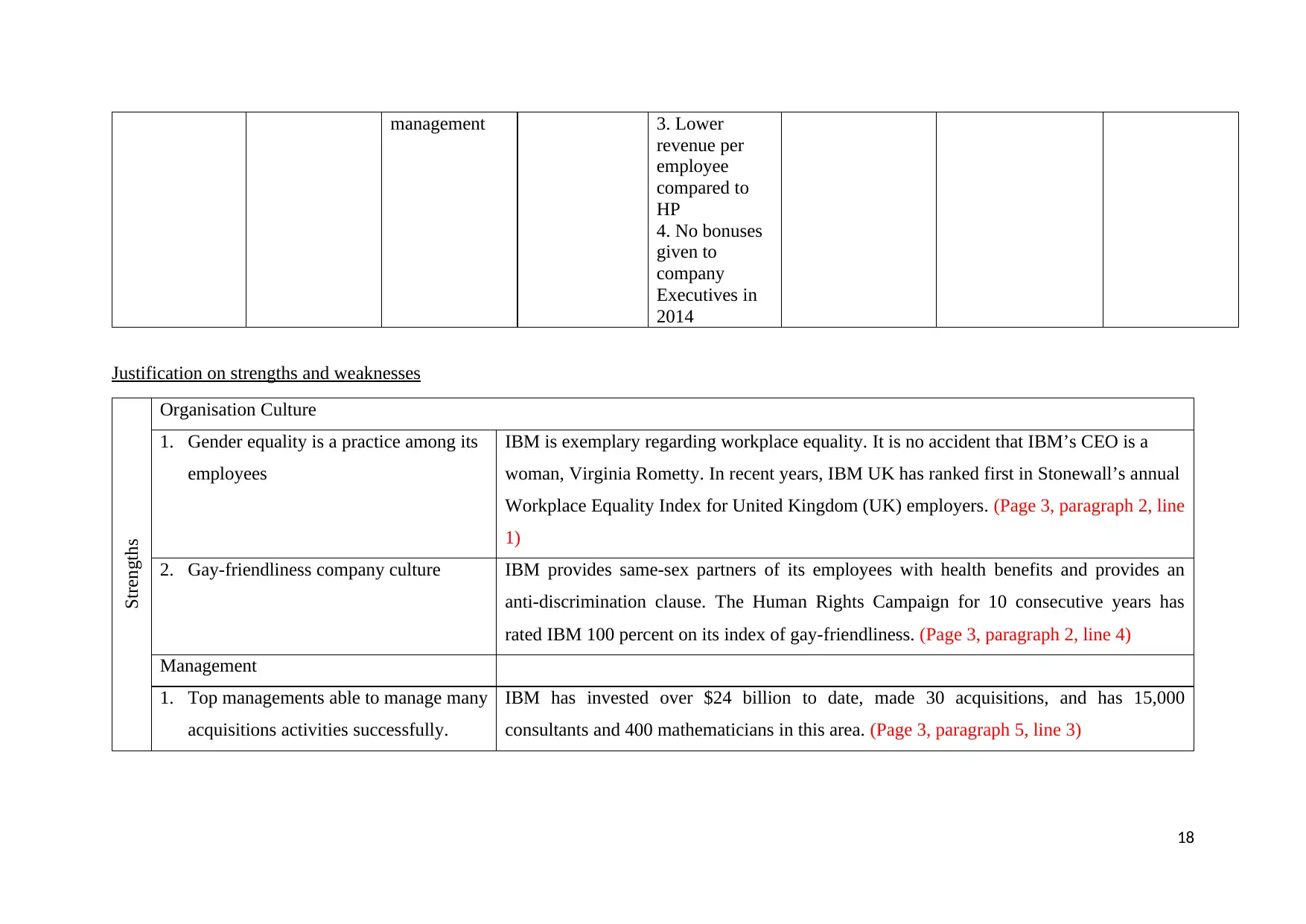
management 3. Lower
revenue per
employee
compared to
HP
4. No bonuses
given to
company
Executives in
2014
Justification on strengths and weaknesses
Strengths
Organisation Culture
1. Gender equality is a practice among its
employees
IBM is exemplary regarding workplace equality. It is no accident that IBM’s CEO is a
woman, Virginia Rometty. In recent years, IBM UK has ranked first in Stonewall’s annual
Workplace Equality Index for United Kingdom (UK) employers. (Page 3, paragraph 2, line
1)
2. Gay-friendliness company culture IBM provides same-sex partners of its employees with health benefits and provides an
anti-discrimination clause. The Human Rights Campaign for 10 consecutive years has
rated IBM 100 percent on its index of gay-friendliness. (Page 3, paragraph 2, line 4)
Management
1. Top managements able to manage many
acquisitions activities successfully.
IBM has invested over $24 billion to date, made 30 acquisitions, and has 15,000
consultants and 400 mathematicians in this area. (Page 3, paragraph 5, line 3)
18
revenue per
employee
compared to
HP
4. No bonuses
given to
company
Executives in
2014
Justification on strengths and weaknesses
Strengths
Organisation Culture
1. Gender equality is a practice among its
employees
IBM is exemplary regarding workplace equality. It is no accident that IBM’s CEO is a
woman, Virginia Rometty. In recent years, IBM UK has ranked first in Stonewall’s annual
Workplace Equality Index for United Kingdom (UK) employers. (Page 3, paragraph 2, line
1)
2. Gay-friendliness company culture IBM provides same-sex partners of its employees with health benefits and provides an
anti-discrimination clause. The Human Rights Campaign for 10 consecutive years has
rated IBM 100 percent on its index of gay-friendliness. (Page 3, paragraph 2, line 4)
Management
1. Top managements able to manage many
acquisitions activities successfully.
IBM has invested over $24 billion to date, made 30 acquisitions, and has 15,000
consultants and 400 mathematicians in this area. (Page 3, paragraph 5, line 3)
18
Paraphrase This Document
Need a fresh take? Get an instant paraphrase of this document with our AI Paraphraser
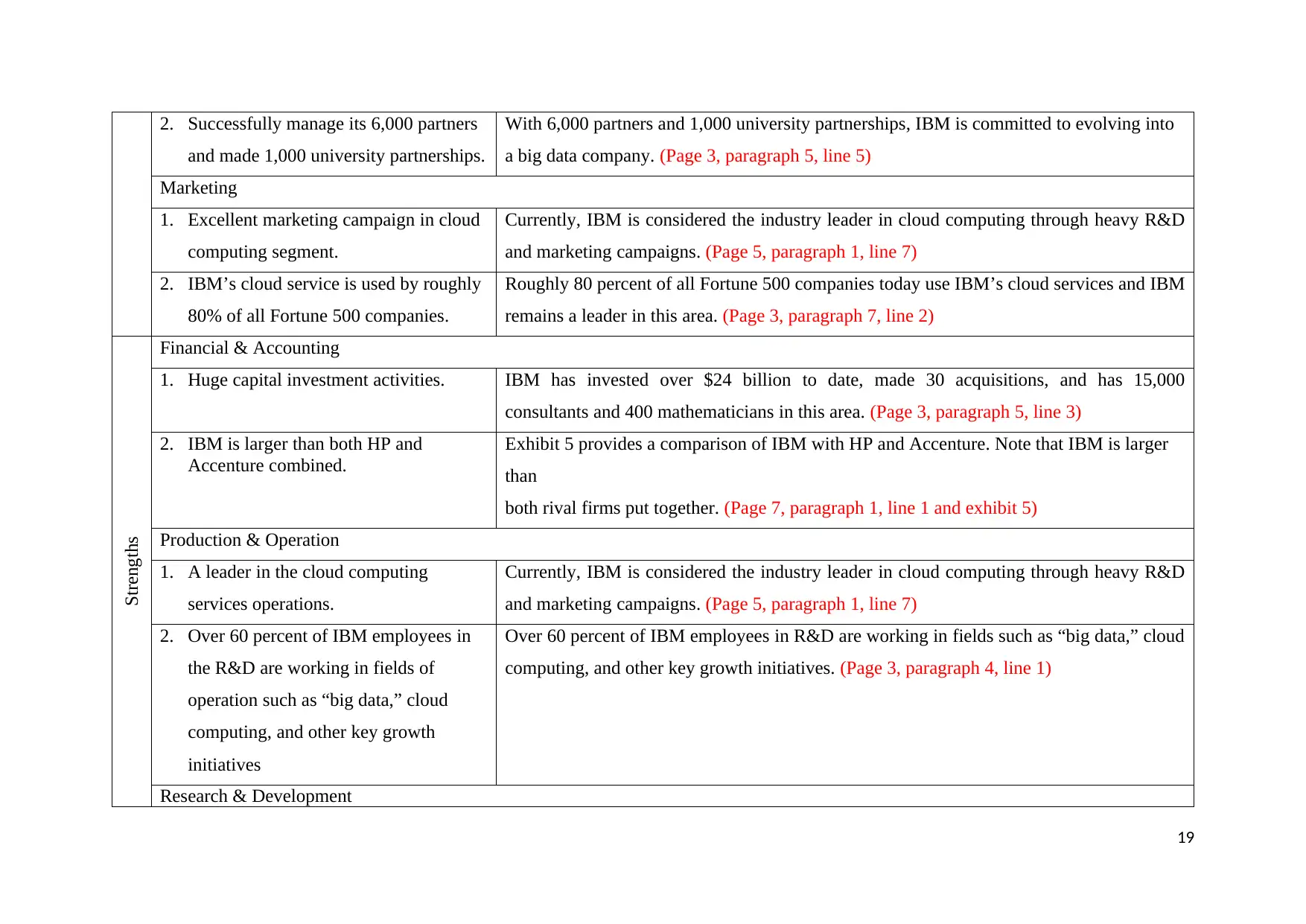
2. Successfully manage its 6,000 partners
and made 1,000 university partnerships.
With 6,000 partners and 1,000 university partnerships, IBM is committed to evolving into
a big data company. (Page 3, paragraph 5, line 5)
Marketing
1. Excellent marketing campaign in cloud
computing segment.
Currently, IBM is considered the industry leader in cloud computing through heavy R&D
and marketing campaigns. (Page 5, paragraph 1, line 7)
2. IBM’s cloud service is used by roughly
80% of all Fortune 500 companies.
Roughly 80 percent of all Fortune 500 companies today use IBM’s cloud services and IBM
remains a leader in this area. (Page 3, paragraph 7, line 2)
Strengths
Financial & Accounting
1. Huge capital investment activities. IBM has invested over $24 billion to date, made 30 acquisitions, and has 15,000
consultants and 400 mathematicians in this area. (Page 3, paragraph 5, line 3)
2. IBM is larger than both HP and
Accenture combined.
Exhibit 5 provides a comparison of IBM with HP and Accenture. Note that IBM is larger
than
both rival firms put together. (Page 7, paragraph 1, line 1 and exhibit 5)
Production & Operation
1. A leader in the cloud computing
services operations.
Currently, IBM is considered the industry leader in cloud computing through heavy R&D
and marketing campaigns. (Page 5, paragraph 1, line 7)
2. Over 60 percent of IBM employees in
the R&D are working in fields of
operation such as “big data,” cloud
computing, and other key growth
initiatives
Over 60 percent of IBM employees in R&D are working in fields such as “big data,” cloud
computing, and other key growth initiatives. (Page 3, paragraph 4, line 1)
Research & Development
19
and made 1,000 university partnerships.
With 6,000 partners and 1,000 university partnerships, IBM is committed to evolving into
a big data company. (Page 3, paragraph 5, line 5)
Marketing
1. Excellent marketing campaign in cloud
computing segment.
Currently, IBM is considered the industry leader in cloud computing through heavy R&D
and marketing campaigns. (Page 5, paragraph 1, line 7)
2. IBM’s cloud service is used by roughly
80% of all Fortune 500 companies.
Roughly 80 percent of all Fortune 500 companies today use IBM’s cloud services and IBM
remains a leader in this area. (Page 3, paragraph 7, line 2)
Strengths
Financial & Accounting
1. Huge capital investment activities. IBM has invested over $24 billion to date, made 30 acquisitions, and has 15,000
consultants and 400 mathematicians in this area. (Page 3, paragraph 5, line 3)
2. IBM is larger than both HP and
Accenture combined.
Exhibit 5 provides a comparison of IBM with HP and Accenture. Note that IBM is larger
than
both rival firms put together. (Page 7, paragraph 1, line 1 and exhibit 5)
Production & Operation
1. A leader in the cloud computing
services operations.
Currently, IBM is considered the industry leader in cloud computing through heavy R&D
and marketing campaigns. (Page 5, paragraph 1, line 7)
2. Over 60 percent of IBM employees in
the R&D are working in fields of
operation such as “big data,” cloud
computing, and other key growth
initiatives
Over 60 percent of IBM employees in R&D are working in fields such as “big data,” cloud
computing, and other key growth initiatives. (Page 3, paragraph 4, line 1)
Research & Development
19
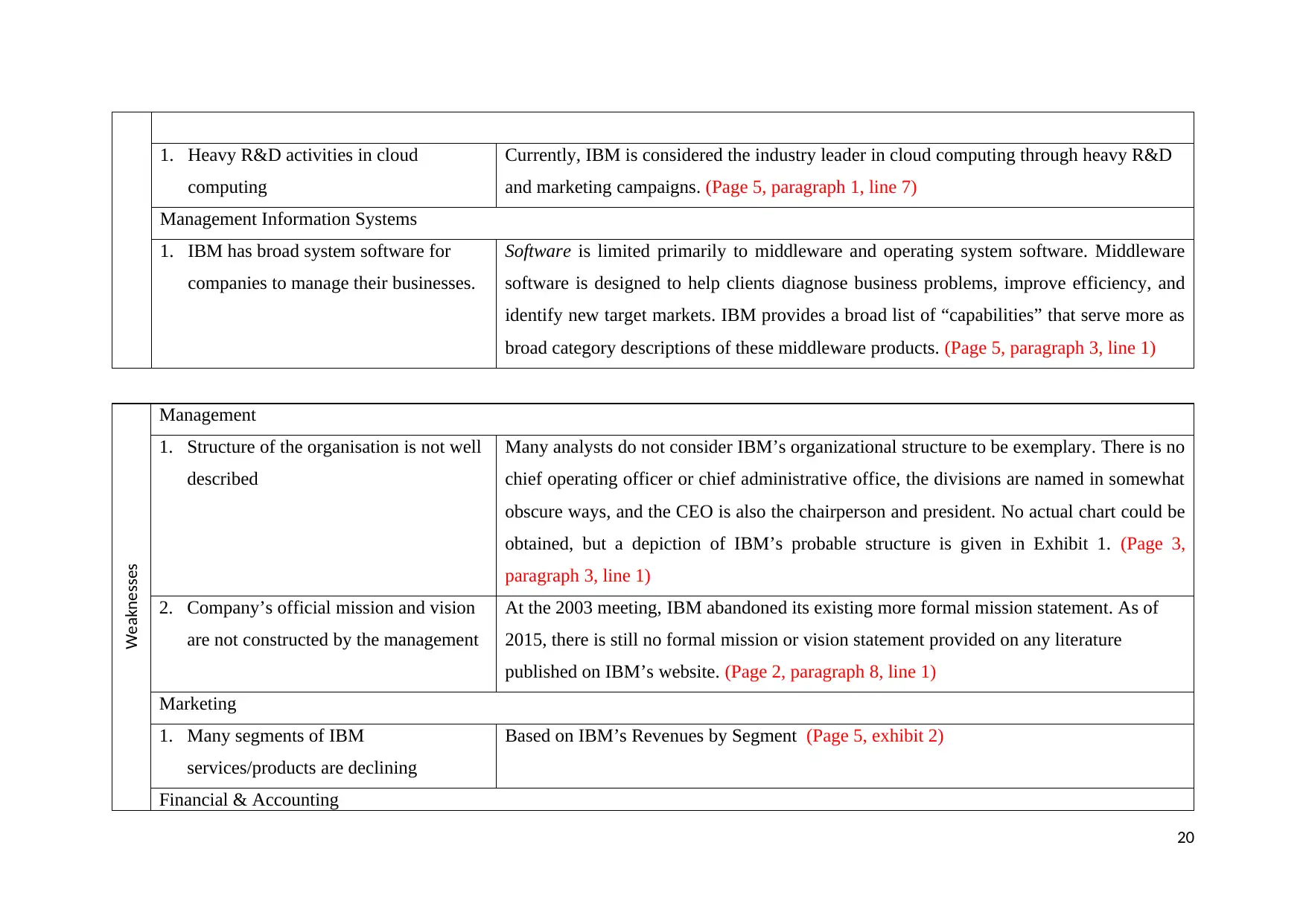
1. Heavy R&D activities in cloud
computing
Currently, IBM is considered the industry leader in cloud computing through heavy R&D
and marketing campaigns. (Page 5, paragraph 1, line 7)
Management Information Systems
1. IBM has broad system software for
companies to manage their businesses.
Software is limited primarily to middleware and operating system software. Middleware
software is designed to help clients diagnose business problems, improve efficiency, and
identify new target markets. IBM provides a broad list of “capabilities” that serve more as
broad category descriptions of these middleware products. (Page 5, paragraph 3, line 1)
Weaknesses
Management
1. Structure of the organisation is not well
described
Many analysts do not consider IBM’s organizational structure to be exemplary. There is no
chief operating officer or chief administrative office, the divisions are named in somewhat
obscure ways, and the CEO is also the chairperson and president. No actual chart could be
obtained, but a depiction of IBM’s probable structure is given in Exhibit 1. (Page 3,
paragraph 3, line 1)
2. Company’s official mission and vision
are not constructed by the management
At the 2003 meeting, IBM abandoned its existing more formal mission statement. As of
2015, there is still no formal mission or vision statement provided on any literature
published on IBM’s website. (Page 2, paragraph 8, line 1)
Marketing
1. Many segments of IBM
services/products are declining
Based on IBM’s Revenues by Segment (Page 5, exhibit 2)
Financial & Accounting
20
computing
Currently, IBM is considered the industry leader in cloud computing through heavy R&D
and marketing campaigns. (Page 5, paragraph 1, line 7)
Management Information Systems
1. IBM has broad system software for
companies to manage their businesses.
Software is limited primarily to middleware and operating system software. Middleware
software is designed to help clients diagnose business problems, improve efficiency, and
identify new target markets. IBM provides a broad list of “capabilities” that serve more as
broad category descriptions of these middleware products. (Page 5, paragraph 3, line 1)
Weaknesses
Management
1. Structure of the organisation is not well
described
Many analysts do not consider IBM’s organizational structure to be exemplary. There is no
chief operating officer or chief administrative office, the divisions are named in somewhat
obscure ways, and the CEO is also the chairperson and president. No actual chart could be
obtained, but a depiction of IBM’s probable structure is given in Exhibit 1. (Page 3,
paragraph 3, line 1)
2. Company’s official mission and vision
are not constructed by the management
At the 2003 meeting, IBM abandoned its existing more formal mission statement. As of
2015, there is still no formal mission or vision statement provided on any literature
published on IBM’s website. (Page 2, paragraph 8, line 1)
Marketing
1. Many segments of IBM
services/products are declining
Based on IBM’s Revenues by Segment (Page 5, exhibit 2)
Financial & Accounting
20
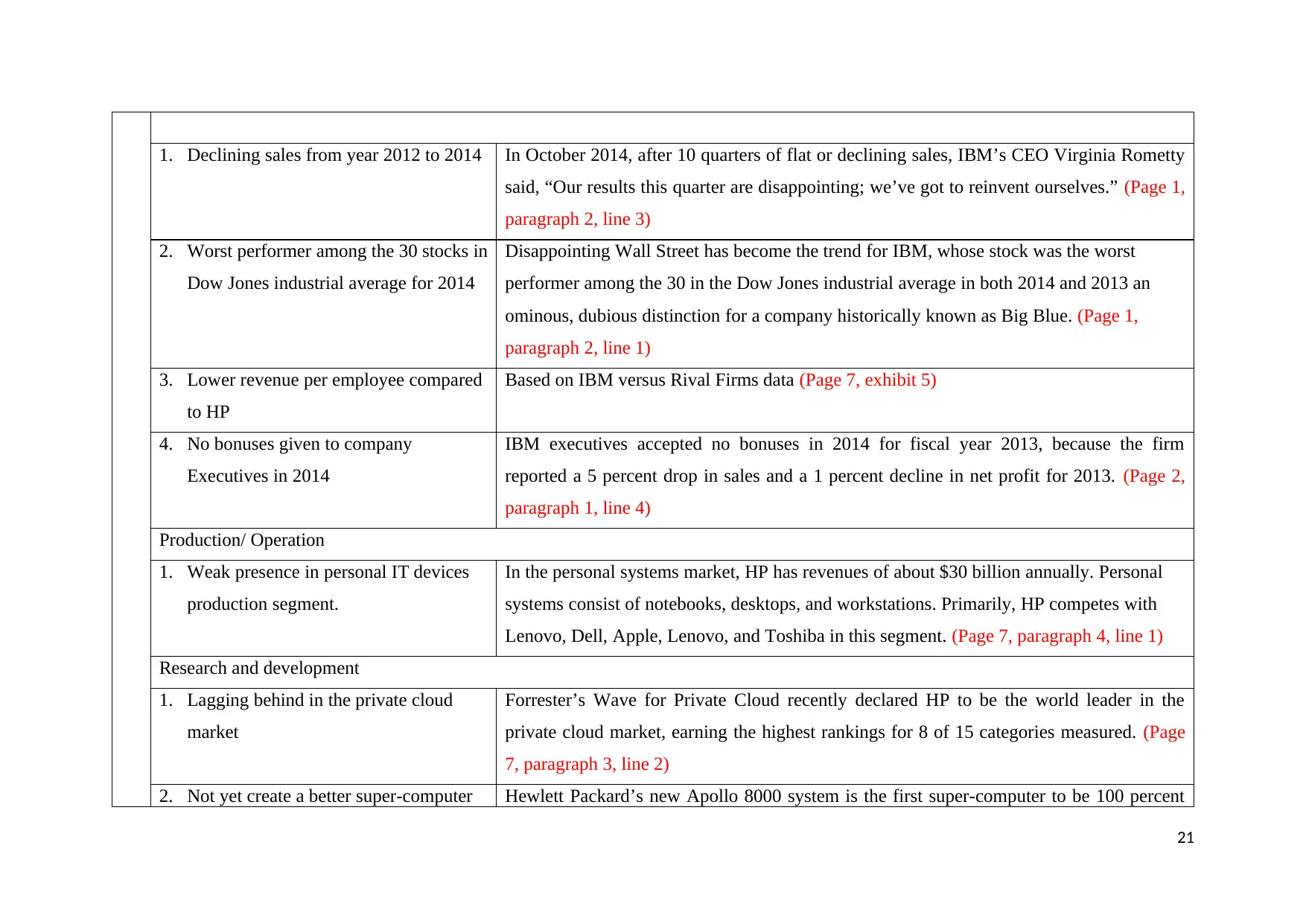
1. Declining sales from year 2012 to 2014 In October 2014, after 10 quarters of flat or declining sales, IBM’s CEO Virginia Rometty
said, “Our results this quarter are disappointing; we’ve got to reinvent ourselves.” (Page 1,
paragraph 2, line 3)
2. Worst performer among the 30 stocks in
Dow Jones industrial average for 2014
Disappointing Wall Street has become the trend for IBM, whose stock was the worst
performer among the 30 in the Dow Jones industrial average in both 2014 and 2013 an
ominous, dubious distinction for a company historically known as Big Blue. (Page 1,
paragraph 2, line 1)
3. Lower revenue per employee compared
to HP
Based on IBM versus Rival Firms data (Page 7, exhibit 5)
4. No bonuses given to company
Executives in 2014
IBM executives accepted no bonuses in 2014 for fiscal year 2013, because the firm
reported a 5 percent drop in sales and a 1 percent decline in net profit for 2013. (Page 2,
paragraph 1, line 4)
Production/ Operation
1. Weak presence in personal IT devices
production segment.
In the personal systems market, HP has revenues of about $30 billion annually. Personal
systems consist of notebooks, desktops, and workstations. Primarily, HP competes with
Lenovo, Dell, Apple, Lenovo, and Toshiba in this segment. (Page 7, paragraph 4, line 1)
Research and development
1. Lagging behind in the private cloud
market
Forrester’s Wave for Private Cloud recently declared HP to be the world leader in the
private cloud market, earning the highest rankings for 8 of 15 categories measured. (Page
7, paragraph 3, line 2)
2. Not yet create a better super-computer Hewlett Packard’s new Apollo 8000 system is the first super-computer to be 100 percent
21
said, “Our results this quarter are disappointing; we’ve got to reinvent ourselves.” (Page 1,
paragraph 2, line 3)
2. Worst performer among the 30 stocks in
Dow Jones industrial average for 2014
Disappointing Wall Street has become the trend for IBM, whose stock was the worst
performer among the 30 in the Dow Jones industrial average in both 2014 and 2013 an
ominous, dubious distinction for a company historically known as Big Blue. (Page 1,
paragraph 2, line 1)
3. Lower revenue per employee compared
to HP
Based on IBM versus Rival Firms data (Page 7, exhibit 5)
4. No bonuses given to company
Executives in 2014
IBM executives accepted no bonuses in 2014 for fiscal year 2013, because the firm
reported a 5 percent drop in sales and a 1 percent decline in net profit for 2013. (Page 2,
paragraph 1, line 4)
Production/ Operation
1. Weak presence in personal IT devices
production segment.
In the personal systems market, HP has revenues of about $30 billion annually. Personal
systems consist of notebooks, desktops, and workstations. Primarily, HP competes with
Lenovo, Dell, Apple, Lenovo, and Toshiba in this segment. (Page 7, paragraph 4, line 1)
Research and development
1. Lagging behind in the private cloud
market
Forrester’s Wave for Private Cloud recently declared HP to be the world leader in the
private cloud market, earning the highest rankings for 8 of 15 categories measured. (Page
7, paragraph 3, line 2)
2. Not yet create a better super-computer Hewlett Packard’s new Apollo 8000 system is the first super-computer to be 100 percent
21
Secure Best Marks with AI Grader
Need help grading? Try our AI Grader for instant feedback on your assignments.
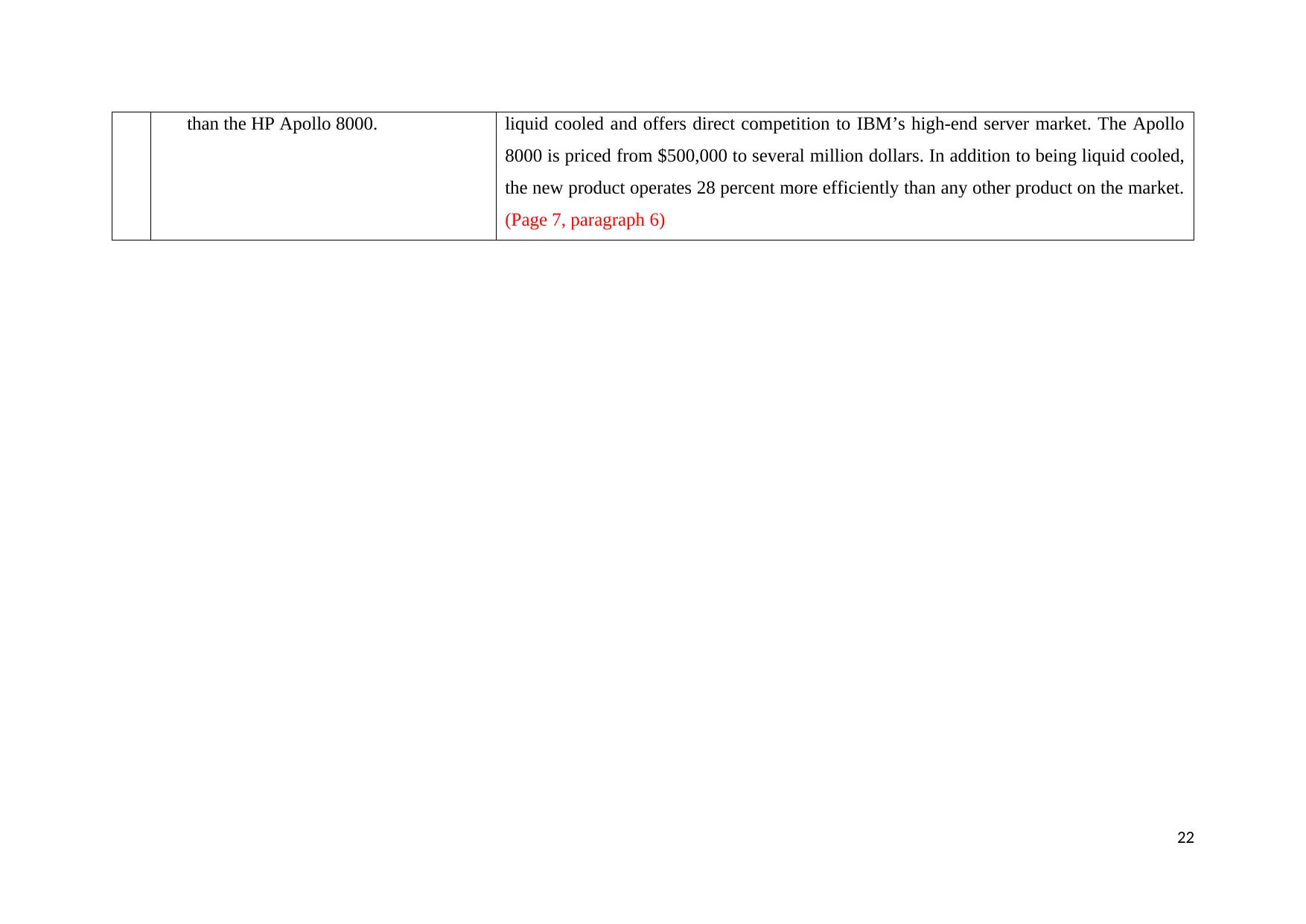
than the HP Apollo 8000. liquid cooled and offers direct competition to IBM’s high-end server market. The Apollo
8000 is priced from $500,000 to several million dollars. In addition to being liquid cooled,
the new product operates 28 percent more efficiently than any other product on the market.
(Page 7, paragraph 6)
22
8000 is priced from $500,000 to several million dollars. In addition to being liquid cooled,
the new product operates 28 percent more efficiently than any other product on the market.
(Page 7, paragraph 6)
22
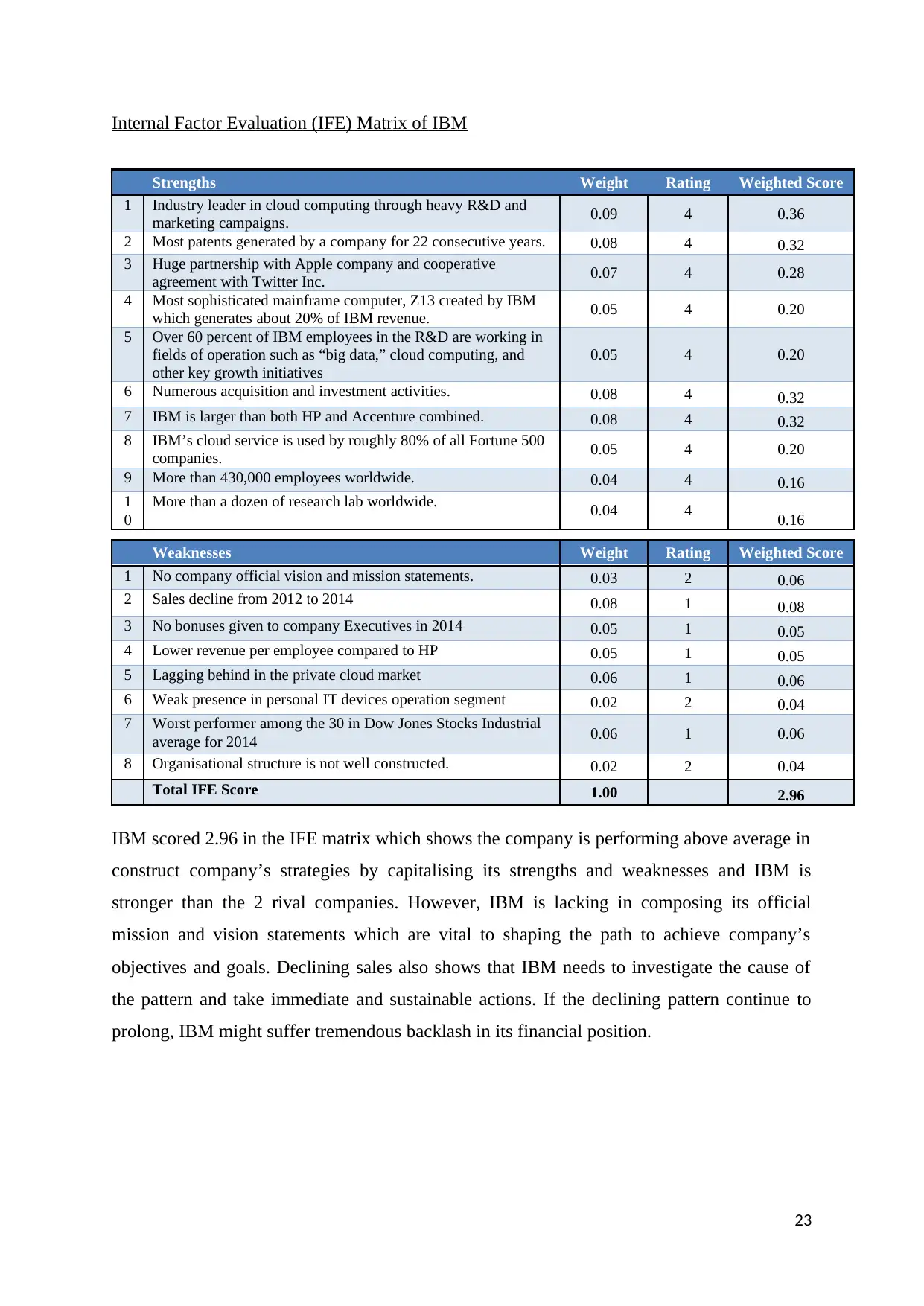
Internal Factor Evaluation (IFE) Matrix of IBM
Strengths Weight Rating Weighted Score
1 Industry leader in cloud computing through heavy R&D and
marketing campaigns. 0.09 4 0.36
2 Most patents generated by a company for 22 consecutive years. 0.08 4 0.32
3 Huge partnership with Apple company and cooperative
agreement with Twitter Inc. 0.07 4 0.28
4 Most sophisticated mainframe computer, Z13 created by IBM
which generates about 20% of IBM revenue. 0.05 4 0.20
5 Over 60 percent of IBM employees in the R&D are working in
fields of operation such as “big data,” cloud computing, and
other key growth initiatives
0.05 4 0.20
6 Numerous acquisition and investment activities. 0.08 4 0.32
7 IBM is larger than both HP and Accenture combined. 0.08 4 0.32
8 IBM’s cloud service is used by roughly 80% of all Fortune 500
companies. 0.05 4 0.20
9 More than 430,000 employees worldwide. 0.04 4 0.16
1
0
More than a dozen of research lab worldwide. 0.04 4 0.16
Weaknesses Weight Rating Weighted Score
1 No company official vision and mission statements. 0.03 2 0.06
2 Sales decline from 2012 to 2014 0.08 1 0.08
3 No bonuses given to company Executives in 2014 0.05 1 0.05
4 Lower revenue per employee compared to HP 0.05 1 0.05
5 Lagging behind in the private cloud market 0.06 1 0.06
6 Weak presence in personal IT devices operation segment 0.02 2 0.04
7 Worst performer among the 30 in Dow Jones Stocks Industrial
average for 2014 0.06 1 0.06
8 Organisational structure is not well constructed. 0.02 2 0.04
Total IFE Score 1.00 2.96
IBM scored 2.96 in the IFE matrix which shows the company is performing above average in
construct company’s strategies by capitalising its strengths and weaknesses and IBM is
stronger than the 2 rival companies. However, IBM is lacking in composing its official
mission and vision statements which are vital to shaping the path to achieve company’s
objectives and goals. Declining sales also shows that IBM needs to investigate the cause of
the pattern and take immediate and sustainable actions. If the declining pattern continue to
prolong, IBM might suffer tremendous backlash in its financial position.
23
Strengths Weight Rating Weighted Score
1 Industry leader in cloud computing through heavy R&D and
marketing campaigns. 0.09 4 0.36
2 Most patents generated by a company for 22 consecutive years. 0.08 4 0.32
3 Huge partnership with Apple company and cooperative
agreement with Twitter Inc. 0.07 4 0.28
4 Most sophisticated mainframe computer, Z13 created by IBM
which generates about 20% of IBM revenue. 0.05 4 0.20
5 Over 60 percent of IBM employees in the R&D are working in
fields of operation such as “big data,” cloud computing, and
other key growth initiatives
0.05 4 0.20
6 Numerous acquisition and investment activities. 0.08 4 0.32
7 IBM is larger than both HP and Accenture combined. 0.08 4 0.32
8 IBM’s cloud service is used by roughly 80% of all Fortune 500
companies. 0.05 4 0.20
9 More than 430,000 employees worldwide. 0.04 4 0.16
1
0
More than a dozen of research lab worldwide. 0.04 4 0.16
Weaknesses Weight Rating Weighted Score
1 No company official vision and mission statements. 0.03 2 0.06
2 Sales decline from 2012 to 2014 0.08 1 0.08
3 No bonuses given to company Executives in 2014 0.05 1 0.05
4 Lower revenue per employee compared to HP 0.05 1 0.05
5 Lagging behind in the private cloud market 0.06 1 0.06
6 Weak presence in personal IT devices operation segment 0.02 2 0.04
7 Worst performer among the 30 in Dow Jones Stocks Industrial
average for 2014 0.06 1 0.06
8 Organisational structure is not well constructed. 0.02 2 0.04
Total IFE Score 1.00 2.96
IBM scored 2.96 in the IFE matrix which shows the company is performing above average in
construct company’s strategies by capitalising its strengths and weaknesses and IBM is
stronger than the 2 rival companies. However, IBM is lacking in composing its official
mission and vision statements which are vital to shaping the path to achieve company’s
objectives and goals. Declining sales also shows that IBM needs to investigate the cause of
the pattern and take immediate and sustainable actions. If the declining pattern continue to
prolong, IBM might suffer tremendous backlash in its financial position.
23
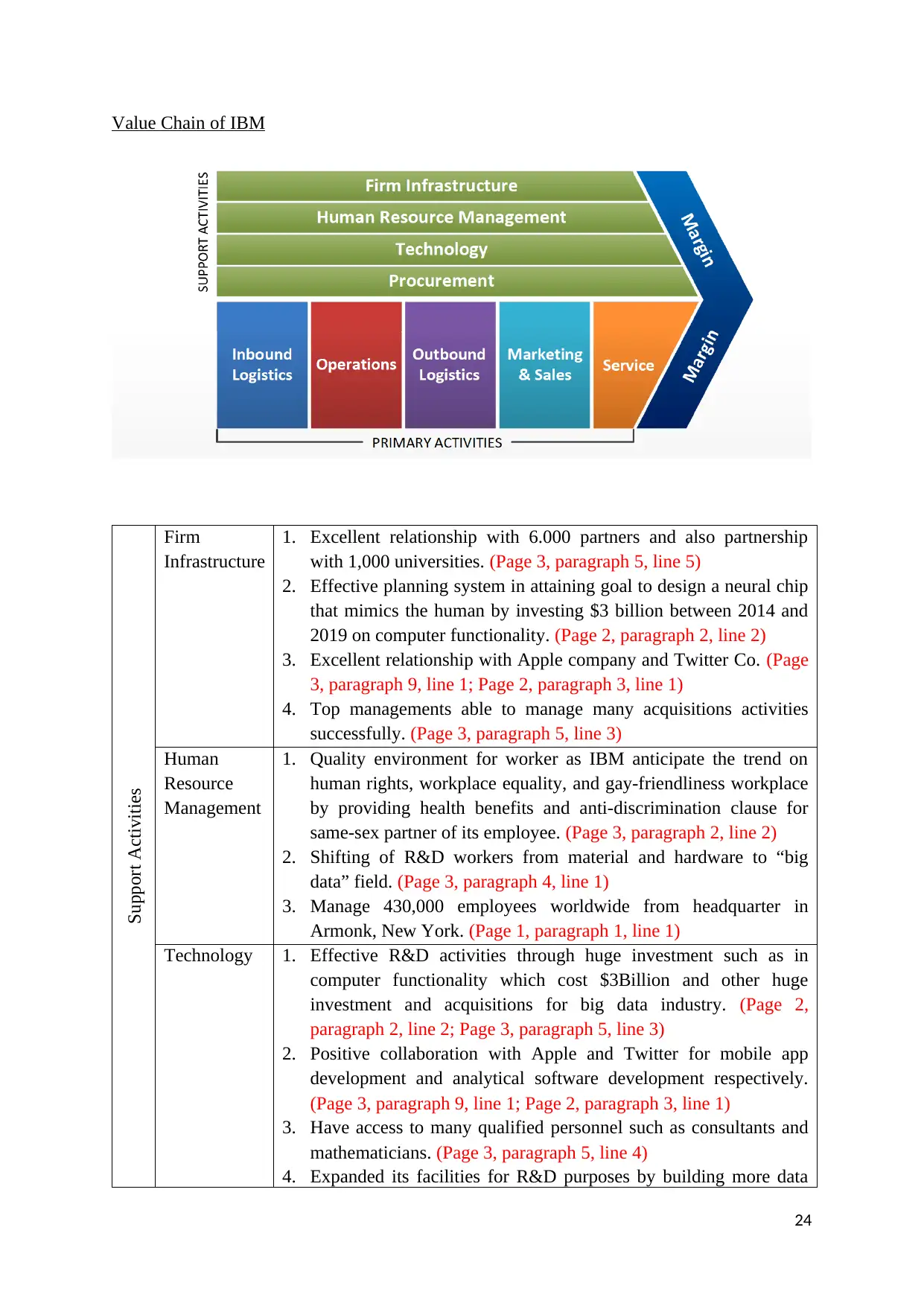
Value Chain of IBM
Support Activities
Firm
Infrastructure
1. Excellent relationship with 6.000 partners and also partnership
with 1,000 universities. (Page 3, paragraph 5, line 5)
2. Effective planning system in attaining goal to design a neural chip
that mimics the human by investing $3 billion between 2014 and
2019 on computer functionality. (Page 2, paragraph 2, line 2)
3. Excellent relationship with Apple company and Twitter Co. (Page
3, paragraph 9, line 1; Page 2, paragraph 3, line 1)
4. Top managements able to manage many acquisitions activities
successfully. (Page 3, paragraph 5, line 3)
Human
Resource
Management
1. Quality environment for worker as IBM anticipate the trend on
human rights, workplace equality, and gay-friendliness workplace
by providing health benefits and anti-discrimination clause for
same-sex partner of its employee. (Page 3, paragraph 2, line 2)
2. Shifting of R&D workers from material and hardware to “big
data” field. (Page 3, paragraph 4, line 1)
3. Manage 430,000 employees worldwide from headquarter in
Armonk, New York. (Page 1, paragraph 1, line 1)
Technology 1. Effective R&D activities through huge investment such as in
computer functionality which cost $3Billion and other huge
investment and acquisitions for big data industry. (Page 2,
paragraph 2, line 2; Page 3, paragraph 5, line 3)
2. Positive collaboration with Apple and Twitter for mobile app
development and analytical software development respectively.
(Page 3, paragraph 9, line 1; Page 2, paragraph 3, line 1)
3. Have access to many qualified personnel such as consultants and
mathematicians. (Page 3, paragraph 5, line 4)
4. Expanded its facilities for R&D purposes by building more data
24
Support Activities
Firm
Infrastructure
1. Excellent relationship with 6.000 partners and also partnership
with 1,000 universities. (Page 3, paragraph 5, line 5)
2. Effective planning system in attaining goal to design a neural chip
that mimics the human by investing $3 billion between 2014 and
2019 on computer functionality. (Page 2, paragraph 2, line 2)
3. Excellent relationship with Apple company and Twitter Co. (Page
3, paragraph 9, line 1; Page 2, paragraph 3, line 1)
4. Top managements able to manage many acquisitions activities
successfully. (Page 3, paragraph 5, line 3)
Human
Resource
Management
1. Quality environment for worker as IBM anticipate the trend on
human rights, workplace equality, and gay-friendliness workplace
by providing health benefits and anti-discrimination clause for
same-sex partner of its employee. (Page 3, paragraph 2, line 2)
2. Shifting of R&D workers from material and hardware to “big
data” field. (Page 3, paragraph 4, line 1)
3. Manage 430,000 employees worldwide from headquarter in
Armonk, New York. (Page 1, paragraph 1, line 1)
Technology 1. Effective R&D activities through huge investment such as in
computer functionality which cost $3Billion and other huge
investment and acquisitions for big data industry. (Page 2,
paragraph 2, line 2; Page 3, paragraph 5, line 3)
2. Positive collaboration with Apple and Twitter for mobile app
development and analytical software development respectively.
(Page 3, paragraph 9, line 1; Page 2, paragraph 3, line 1)
3. Have access to many qualified personnel such as consultants and
mathematicians. (Page 3, paragraph 5, line 4)
4. Expanded its facilities for R&D purposes by building more data
24
Paraphrase This Document
Need a fresh take? Get an instant paraphrase of this document with our AI Paraphraser
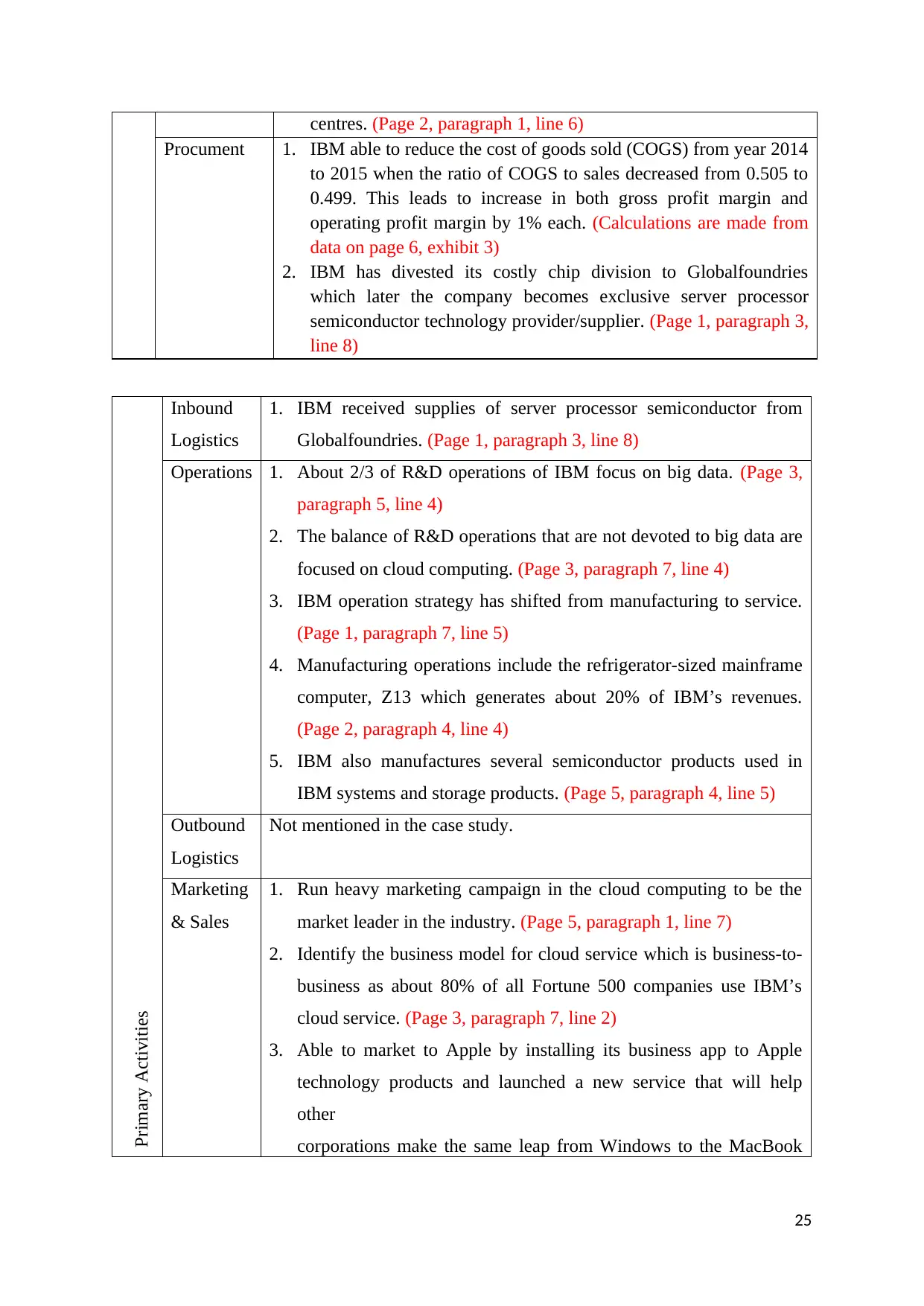
centres. (Page 2, paragraph 1, line 6)
Procument 1. IBM able to reduce the cost of goods sold (COGS) from year 2014
to 2015 when the ratio of COGS to sales decreased from 0.505 to
0.499. This leads to increase in both gross profit margin and
operating profit margin by 1% each. (Calculations are made from
data on page 6, exhibit 3)
2. IBM has divested its costly chip division to Globalfoundries
which later the company becomes exclusive server processor
semiconductor technology provider/supplier. (Page 1, paragraph 3,
line 8)
Primary Activities
Inbound
Logistics
1. IBM received supplies of server processor semiconductor from
Globalfoundries. (Page 1, paragraph 3, line 8)
Operations 1. About 2/3 of R&D operations of IBM focus on big data. (Page 3,
paragraph 5, line 4)
2. The balance of R&D operations that are not devoted to big data are
focused on cloud computing. (Page 3, paragraph 7, line 4)
3. IBM operation strategy has shifted from manufacturing to service.
(Page 1, paragraph 7, line 5)
4. Manufacturing operations include the refrigerator-sized mainframe
computer, Z13 which generates about 20% of IBM’s revenues.
(Page 2, paragraph 4, line 4)
5. IBM also manufactures several semiconductor products used in
IBM systems and storage products. (Page 5, paragraph 4, line 5)
Outbound
Logistics
Not mentioned in the case study.
Marketing
& Sales
1. Run heavy marketing campaign in the cloud computing to be the
market leader in the industry. (Page 5, paragraph 1, line 7)
2. Identify the business model for cloud service which is business-to-
business as about 80% of all Fortune 500 companies use IBM’s
cloud service. (Page 3, paragraph 7, line 2)
3. Able to market to Apple by installing its business app to Apple
technology products and launched a new service that will help
other
corporations make the same leap from Windows to the MacBook
25
Procument 1. IBM able to reduce the cost of goods sold (COGS) from year 2014
to 2015 when the ratio of COGS to sales decreased from 0.505 to
0.499. This leads to increase in both gross profit margin and
operating profit margin by 1% each. (Calculations are made from
data on page 6, exhibit 3)
2. IBM has divested its costly chip division to Globalfoundries
which later the company becomes exclusive server processor
semiconductor technology provider/supplier. (Page 1, paragraph 3,
line 8)
Primary Activities
Inbound
Logistics
1. IBM received supplies of server processor semiconductor from
Globalfoundries. (Page 1, paragraph 3, line 8)
Operations 1. About 2/3 of R&D operations of IBM focus on big data. (Page 3,
paragraph 5, line 4)
2. The balance of R&D operations that are not devoted to big data are
focused on cloud computing. (Page 3, paragraph 7, line 4)
3. IBM operation strategy has shifted from manufacturing to service.
(Page 1, paragraph 7, line 5)
4. Manufacturing operations include the refrigerator-sized mainframe
computer, Z13 which generates about 20% of IBM’s revenues.
(Page 2, paragraph 4, line 4)
5. IBM also manufactures several semiconductor products used in
IBM systems and storage products. (Page 5, paragraph 4, line 5)
Outbound
Logistics
Not mentioned in the case study.
Marketing
& Sales
1. Run heavy marketing campaign in the cloud computing to be the
market leader in the industry. (Page 5, paragraph 1, line 7)
2. Identify the business model for cloud service which is business-to-
business as about 80% of all Fortune 500 companies use IBM’s
cloud service. (Page 3, paragraph 7, line 2)
3. Able to market to Apple by installing its business app to Apple
technology products and launched a new service that will help
other
corporations make the same leap from Windows to the MacBook
25
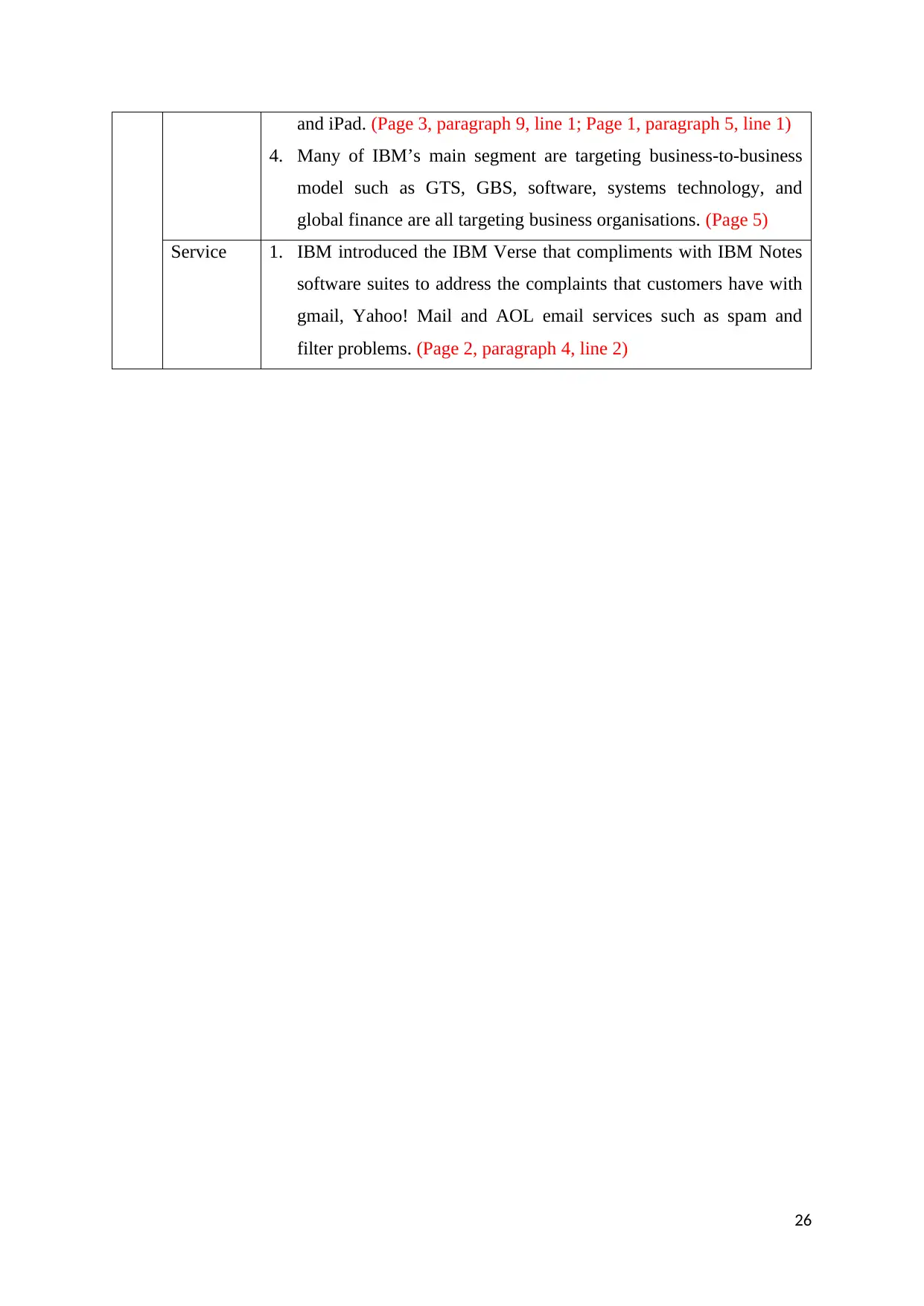
and iPad. (Page 3, paragraph 9, line 1; Page 1, paragraph 5, line 1)
4. Many of IBM’s main segment are targeting business-to-business
model such as GTS, GBS, software, systems technology, and
global finance are all targeting business organisations. (Page 5)
Service 1. IBM introduced the IBM Verse that compliments with IBM Notes
software suites to address the complaints that customers have with
gmail, Yahoo! Mail and AOL email services such as spam and
filter problems. (Page 2, paragraph 4, line 2)
26
4. Many of IBM’s main segment are targeting business-to-business
model such as GTS, GBS, software, systems technology, and
global finance are all targeting business organisations. (Page 5)
Service 1. IBM introduced the IBM Verse that compliments with IBM Notes
software suites to address the complaints that customers have with
gmail, Yahoo! Mail and AOL email services such as spam and
filter problems. (Page 2, paragraph 4, line 2)
26
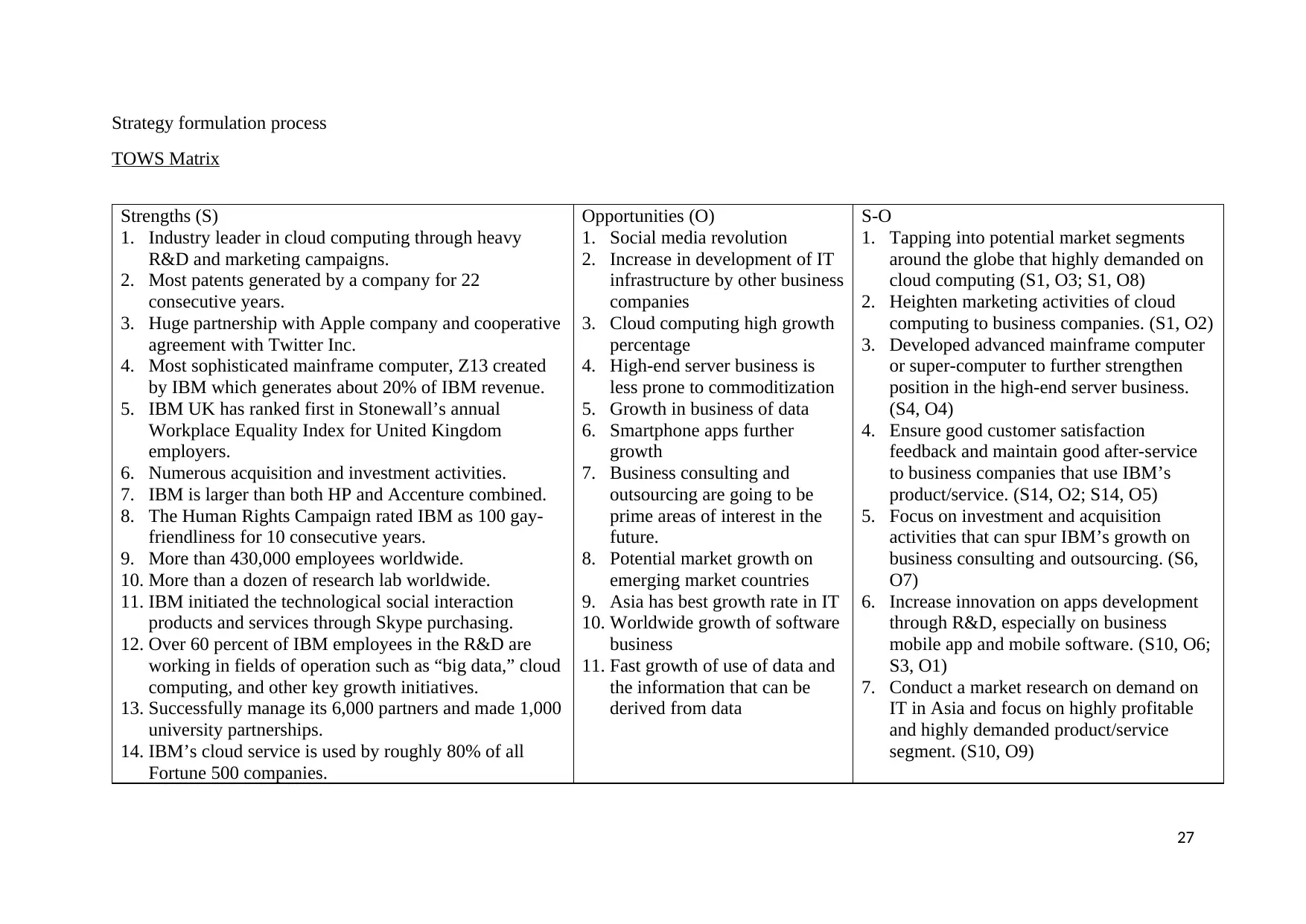
Strategy formulation process
TOWS Matrix
Strengths (S)
1. Industry leader in cloud computing through heavy
R&D and marketing campaigns.
2. Most patents generated by a company for 22
consecutive years.
3. Huge partnership with Apple company and cooperative
agreement with Twitter Inc.
4. Most sophisticated mainframe computer, Z13 created
by IBM which generates about 20% of IBM revenue.
5. IBM UK has ranked first in Stonewall’s annual
Workplace Equality Index for United Kingdom
employers.
6. Numerous acquisition and investment activities.
7. IBM is larger than both HP and Accenture combined.
8. The Human Rights Campaign rated IBM as 100 gay-
friendliness for 10 consecutive years.
9. More than 430,000 employees worldwide.
10. More than a dozen of research lab worldwide.
11. IBM initiated the technological social interaction
products and services through Skype purchasing.
12. Over 60 percent of IBM employees in the R&D are
working in fields of operation such as “big data,” cloud
computing, and other key growth initiatives.
13. Successfully manage its 6,000 partners and made 1,000
university partnerships.
14. IBM’s cloud service is used by roughly 80% of all
Fortune 500 companies.
Opportunities (O)
1. Social media revolution
2. Increase in development of IT
infrastructure by other business
companies
3. Cloud computing high growth
percentage
4. High-end server business is
less prone to commoditization
5. Growth in business of data
6. Smartphone apps further
growth
7. Business consulting and
outsourcing are going to be
prime areas of interest in the
future.
8. Potential market growth on
emerging market countries
9. Asia has best growth rate in IT
10. Worldwide growth of software
business
11. Fast growth of use of data and
the information that can be
derived from data
S-O
1. Tapping into potential market segments
around the globe that highly demanded on
cloud computing (S1, O3; S1, O8)
2. Heighten marketing activities of cloud
computing to business companies. (S1, O2)
3. Developed advanced mainframe computer
or super-computer to further strengthen
position in the high-end server business.
(S4, O4)
4. Ensure good customer satisfaction
feedback and maintain good after-service
to business companies that use IBM’s
product/service. (S14, O2; S14, O5)
5. Focus on investment and acquisition
activities that can spur IBM’s growth on
business consulting and outsourcing. (S6,
O7)
6. Increase innovation on apps development
through R&D, especially on business
mobile app and mobile software. (S10, O6;
S3, O1)
7. Conduct a market research on demand on
IT in Asia and focus on highly profitable
and highly demanded product/service
segment. (S10, O9)
27
TOWS Matrix
Strengths (S)
1. Industry leader in cloud computing through heavy
R&D and marketing campaigns.
2. Most patents generated by a company for 22
consecutive years.
3. Huge partnership with Apple company and cooperative
agreement with Twitter Inc.
4. Most sophisticated mainframe computer, Z13 created
by IBM which generates about 20% of IBM revenue.
5. IBM UK has ranked first in Stonewall’s annual
Workplace Equality Index for United Kingdom
employers.
6. Numerous acquisition and investment activities.
7. IBM is larger than both HP and Accenture combined.
8. The Human Rights Campaign rated IBM as 100 gay-
friendliness for 10 consecutive years.
9. More than 430,000 employees worldwide.
10. More than a dozen of research lab worldwide.
11. IBM initiated the technological social interaction
products and services through Skype purchasing.
12. Over 60 percent of IBM employees in the R&D are
working in fields of operation such as “big data,” cloud
computing, and other key growth initiatives.
13. Successfully manage its 6,000 partners and made 1,000
university partnerships.
14. IBM’s cloud service is used by roughly 80% of all
Fortune 500 companies.
Opportunities (O)
1. Social media revolution
2. Increase in development of IT
infrastructure by other business
companies
3. Cloud computing high growth
percentage
4. High-end server business is
less prone to commoditization
5. Growth in business of data
6. Smartphone apps further
growth
7. Business consulting and
outsourcing are going to be
prime areas of interest in the
future.
8. Potential market growth on
emerging market countries
9. Asia has best growth rate in IT
10. Worldwide growth of software
business
11. Fast growth of use of data and
the information that can be
derived from data
S-O
1. Tapping into potential market segments
around the globe that highly demanded on
cloud computing (S1, O3; S1, O8)
2. Heighten marketing activities of cloud
computing to business companies. (S1, O2)
3. Developed advanced mainframe computer
or super-computer to further strengthen
position in the high-end server business.
(S4, O4)
4. Ensure good customer satisfaction
feedback and maintain good after-service
to business companies that use IBM’s
product/service. (S14, O2; S14, O5)
5. Focus on investment and acquisition
activities that can spur IBM’s growth on
business consulting and outsourcing. (S6,
O7)
6. Increase innovation on apps development
through R&D, especially on business
mobile app and mobile software. (S10, O6;
S3, O1)
7. Conduct a market research on demand on
IT in Asia and focus on highly profitable
and highly demanded product/service
segment. (S10, O9)
27
Secure Best Marks with AI Grader
Need help grading? Try our AI Grader for instant feedback on your assignments.
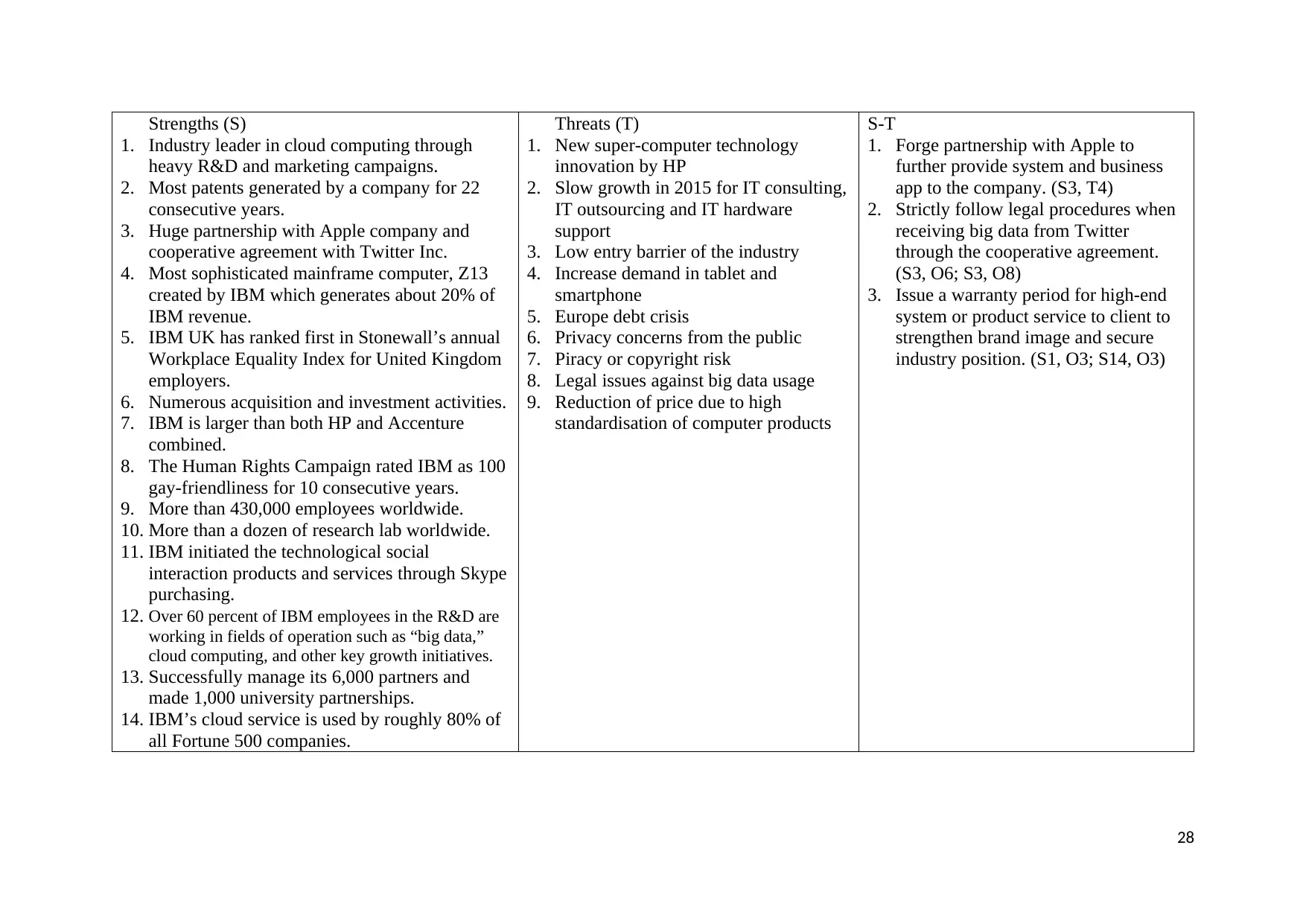
Strengths (S)
1. Industry leader in cloud computing through
heavy R&D and marketing campaigns.
2. Most patents generated by a company for 22
consecutive years.
3. Huge partnership with Apple company and
cooperative agreement with Twitter Inc.
4. Most sophisticated mainframe computer, Z13
created by IBM which generates about 20% of
IBM revenue.
5. IBM UK has ranked first in Stonewall’s annual
Workplace Equality Index for United Kingdom
employers.
6. Numerous acquisition and investment activities.
7. IBM is larger than both HP and Accenture
combined.
8. The Human Rights Campaign rated IBM as 100
gay-friendliness for 10 consecutive years.
9. More than 430,000 employees worldwide.
10. More than a dozen of research lab worldwide.
11. IBM initiated the technological social
interaction products and services through Skype
purchasing.
12. Over 60 percent of IBM employees in the R&D are
working in fields of operation such as “big data,”
cloud computing, and other key growth initiatives.
13. Successfully manage its 6,000 partners and
made 1,000 university partnerships.
14. IBM’s cloud service is used by roughly 80% of
all Fortune 500 companies.
Threats (T)
1. New super-computer technology
innovation by HP
2. Slow growth in 2015 for IT consulting,
IT outsourcing and IT hardware
support
3. Low entry barrier of the industry
4. Increase demand in tablet and
smartphone
5. Europe debt crisis
6. Privacy concerns from the public
7. Piracy or copyright risk
8. Legal issues against big data usage
9. Reduction of price due to high
standardisation of computer products
S-T
1. Forge partnership with Apple to
further provide system and business
app to the company. (S3, T4)
2. Strictly follow legal procedures when
receiving big data from Twitter
through the cooperative agreement.
(S3, O6; S3, O8)
3. Issue a warranty period for high-end
system or product service to client to
strengthen brand image and secure
industry position. (S1, O3; S14, O3)
28
1. Industry leader in cloud computing through
heavy R&D and marketing campaigns.
2. Most patents generated by a company for 22
consecutive years.
3. Huge partnership with Apple company and
cooperative agreement with Twitter Inc.
4. Most sophisticated mainframe computer, Z13
created by IBM which generates about 20% of
IBM revenue.
5. IBM UK has ranked first in Stonewall’s annual
Workplace Equality Index for United Kingdom
employers.
6. Numerous acquisition and investment activities.
7. IBM is larger than both HP and Accenture
combined.
8. The Human Rights Campaign rated IBM as 100
gay-friendliness for 10 consecutive years.
9. More than 430,000 employees worldwide.
10. More than a dozen of research lab worldwide.
11. IBM initiated the technological social
interaction products and services through Skype
purchasing.
12. Over 60 percent of IBM employees in the R&D are
working in fields of operation such as “big data,”
cloud computing, and other key growth initiatives.
13. Successfully manage its 6,000 partners and
made 1,000 university partnerships.
14. IBM’s cloud service is used by roughly 80% of
all Fortune 500 companies.
Threats (T)
1. New super-computer technology
innovation by HP
2. Slow growth in 2015 for IT consulting,
IT outsourcing and IT hardware
support
3. Low entry barrier of the industry
4. Increase demand in tablet and
smartphone
5. Europe debt crisis
6. Privacy concerns from the public
7. Piracy or copyright risk
8. Legal issues against big data usage
9. Reduction of price due to high
standardisation of computer products
S-T
1. Forge partnership with Apple to
further provide system and business
app to the company. (S3, T4)
2. Strictly follow legal procedures when
receiving big data from Twitter
through the cooperative agreement.
(S3, O6; S3, O8)
3. Issue a warranty period for high-end
system or product service to client to
strengthen brand image and secure
industry position. (S1, O3; S14, O3)
28
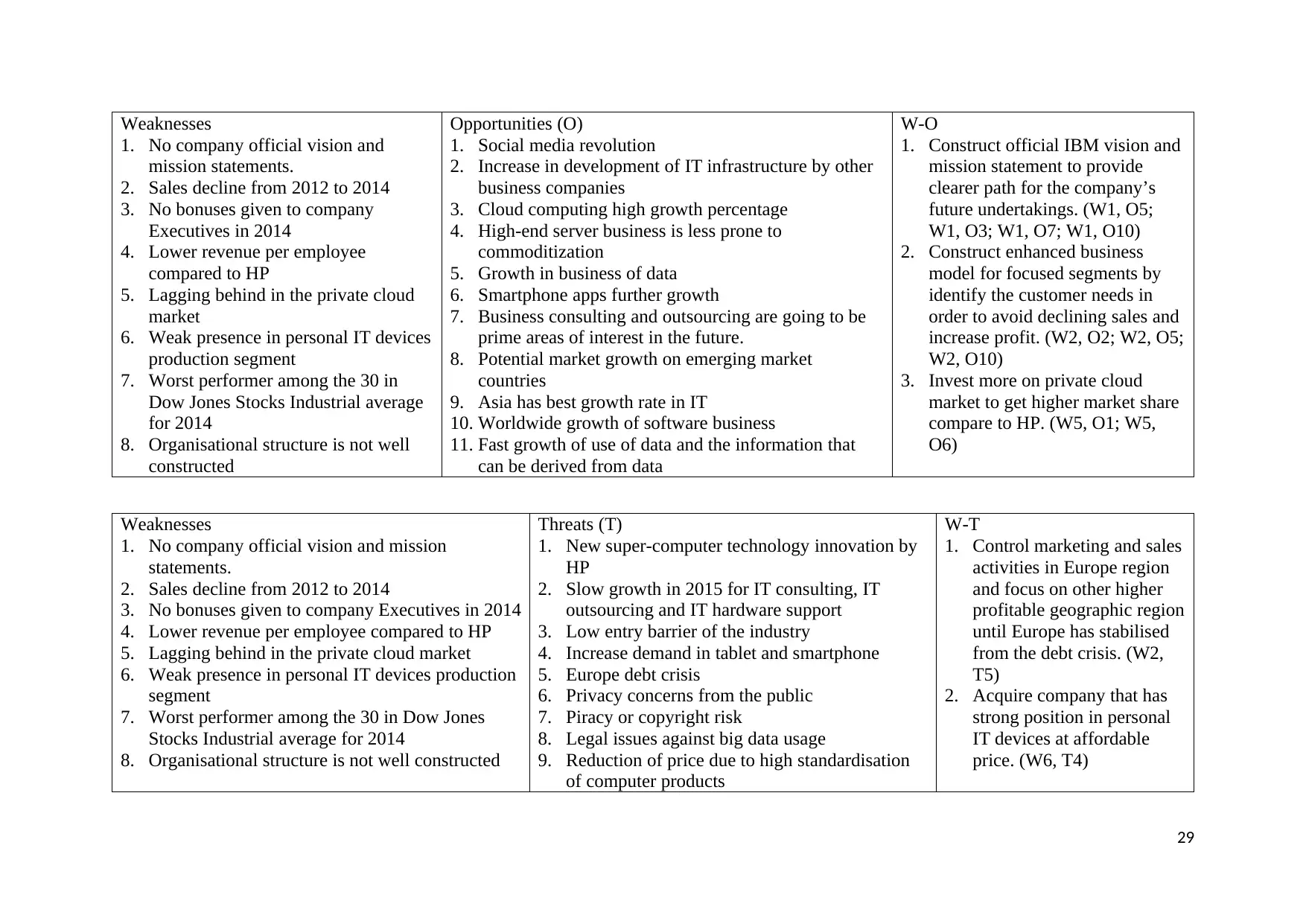
Weaknesses
1. No company official vision and
mission statements.
2. Sales decline from 2012 to 2014
3. No bonuses given to company
Executives in 2014
4. Lower revenue per employee
compared to HP
5. Lagging behind in the private cloud
market
6. Weak presence in personal IT devices
production segment
7. Worst performer among the 30 in
Dow Jones Stocks Industrial average
for 2014
8. Organisational structure is not well
constructed
Opportunities (O)
1. Social media revolution
2. Increase in development of IT infrastructure by other
business companies
3. Cloud computing high growth percentage
4. High-end server business is less prone to
commoditization
5. Growth in business of data
6. Smartphone apps further growth
7. Business consulting and outsourcing are going to be
prime areas of interest in the future.
8. Potential market growth on emerging market
countries
9. Asia has best growth rate in IT
10. Worldwide growth of software business
11. Fast growth of use of data and the information that
can be derived from data
W-O
1. Construct official IBM vision and
mission statement to provide
clearer path for the company’s
future undertakings. (W1, O5;
W1, O3; W1, O7; W1, O10)
2. Construct enhanced business
model for focused segments by
identify the customer needs in
order to avoid declining sales and
increase profit. (W2, O2; W2, O5;
W2, O10)
3. Invest more on private cloud
market to get higher market share
compare to HP. (W5, O1; W5,
O6)
Weaknesses
1. No company official vision and mission
statements.
2. Sales decline from 2012 to 2014
3. No bonuses given to company Executives in 2014
4. Lower revenue per employee compared to HP
5. Lagging behind in the private cloud market
6. Weak presence in personal IT devices production
segment
7. Worst performer among the 30 in Dow Jones
Stocks Industrial average for 2014
8. Organisational structure is not well constructed
Threats (T)
1. New super-computer technology innovation by
HP
2. Slow growth in 2015 for IT consulting, IT
outsourcing and IT hardware support
3. Low entry barrier of the industry
4. Increase demand in tablet and smartphone
5. Europe debt crisis
6. Privacy concerns from the public
7. Piracy or copyright risk
8. Legal issues against big data usage
9. Reduction of price due to high standardisation
of computer products
W-T
1. Control marketing and sales
activities in Europe region
and focus on other higher
profitable geographic region
until Europe has stabilised
from the debt crisis. (W2,
T5)
2. Acquire company that has
strong position in personal
IT devices at affordable
price. (W6, T4)
29
1. No company official vision and
mission statements.
2. Sales decline from 2012 to 2014
3. No bonuses given to company
Executives in 2014
4. Lower revenue per employee
compared to HP
5. Lagging behind in the private cloud
market
6. Weak presence in personal IT devices
production segment
7. Worst performer among the 30 in
Dow Jones Stocks Industrial average
for 2014
8. Organisational structure is not well
constructed
Opportunities (O)
1. Social media revolution
2. Increase in development of IT infrastructure by other
business companies
3. Cloud computing high growth percentage
4. High-end server business is less prone to
commoditization
5. Growth in business of data
6. Smartphone apps further growth
7. Business consulting and outsourcing are going to be
prime areas of interest in the future.
8. Potential market growth on emerging market
countries
9. Asia has best growth rate in IT
10. Worldwide growth of software business
11. Fast growth of use of data and the information that
can be derived from data
W-O
1. Construct official IBM vision and
mission statement to provide
clearer path for the company’s
future undertakings. (W1, O5;
W1, O3; W1, O7; W1, O10)
2. Construct enhanced business
model for focused segments by
identify the customer needs in
order to avoid declining sales and
increase profit. (W2, O2; W2, O5;
W2, O10)
3. Invest more on private cloud
market to get higher market share
compare to HP. (W5, O1; W5,
O6)
Weaknesses
1. No company official vision and mission
statements.
2. Sales decline from 2012 to 2014
3. No bonuses given to company Executives in 2014
4. Lower revenue per employee compared to HP
5. Lagging behind in the private cloud market
6. Weak presence in personal IT devices production
segment
7. Worst performer among the 30 in Dow Jones
Stocks Industrial average for 2014
8. Organisational structure is not well constructed
Threats (T)
1. New super-computer technology innovation by
HP
2. Slow growth in 2015 for IT consulting, IT
outsourcing and IT hardware support
3. Low entry barrier of the industry
4. Increase demand in tablet and smartphone
5. Europe debt crisis
6. Privacy concerns from the public
7. Piracy or copyright risk
8. Legal issues against big data usage
9. Reduction of price due to high standardisation
of computer products
W-T
1. Control marketing and sales
activities in Europe region
and focus on other higher
profitable geographic region
until Europe has stabilised
from the debt crisis. (W2,
T5)
2. Acquire company that has
strong position in personal
IT devices at affordable
price. (W6, T4)
29
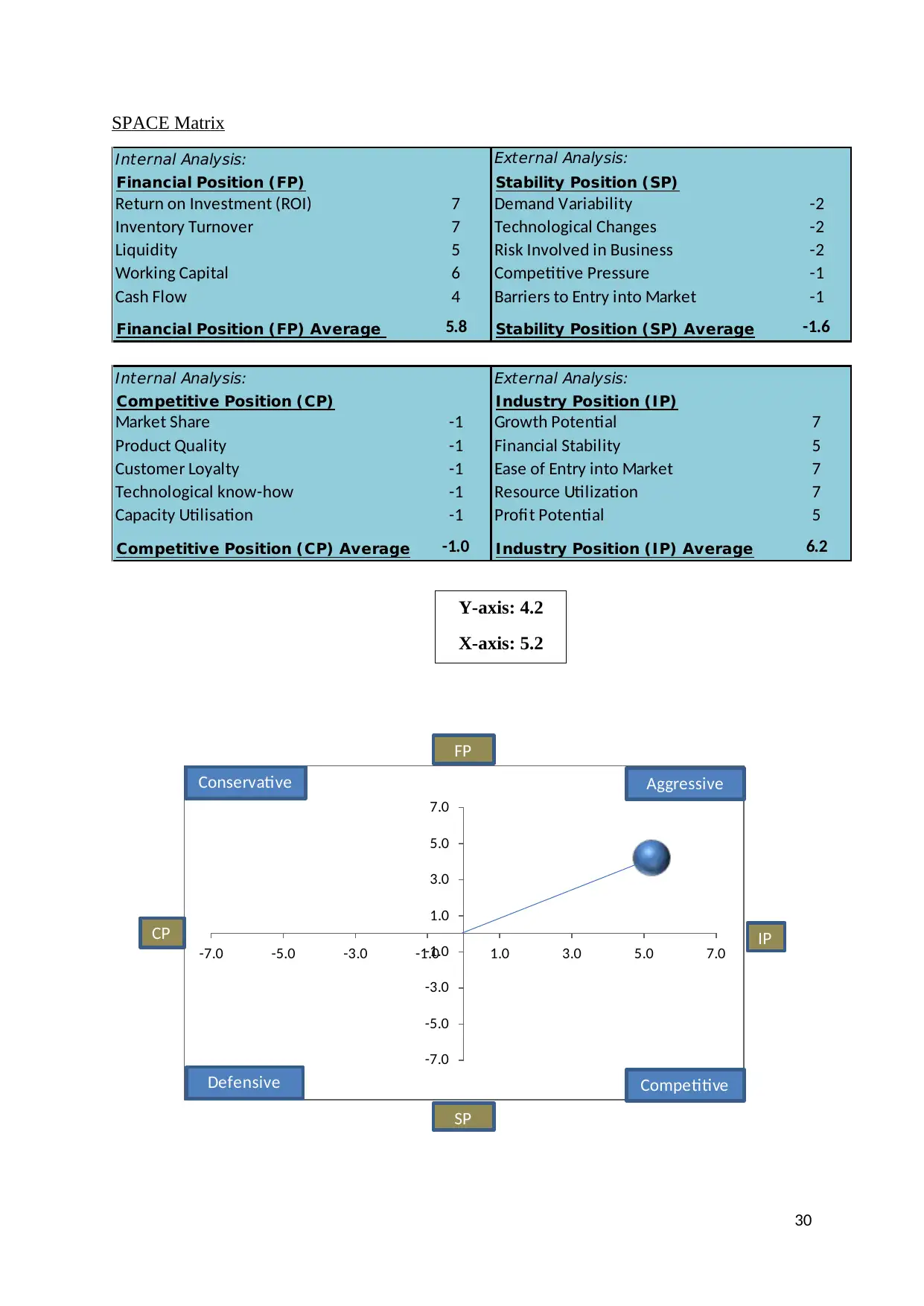
SPACE Matrix
Internal Analysis: External Analysis:
Financial Position (FP) Stability Position (SP)
7 -2
7 -2
5 -2
6 -1
4 -1
Financial Position (FP) Average 5.8 Stability Position (SP) Average -1.6
Internal Analysis: External Analysis:
Competitive Position (CP) Industry Position (IP)
Market Share -1 Growth Potential 7
Product Quality -1 Financial Stability 5
Customer Loyalty -1 Ease of Entry into Market 7
Technological know-how -1 Resource Utilization 7
Capacity Utilisation -1 Profit Potential 5
Competitive Position (CP) Average -1.0 Industry Position (IP) Average 6.2
Liquidity
Working Capital
Cash Flow
Demand Variability
Technological Changes
Risk Involved in Business
Competitive Pressure
Barriers to Entry into Market
Return on Investment (ROI)
Inventory Turnover
-7.0
-5.0
-3.0
-1.0
1.0
3.0
5.0
7.0
-7.0 -5.0 -3.0 -1.0 1.0 3.0 5.0 7.0
FP
SP
CP IP
Defensive
Conservative Aggressive
Competitive
30
Y-axis: 4.2
X-axis: 5.2
Internal Analysis: External Analysis:
Financial Position (FP) Stability Position (SP)
7 -2
7 -2
5 -2
6 -1
4 -1
Financial Position (FP) Average 5.8 Stability Position (SP) Average -1.6
Internal Analysis: External Analysis:
Competitive Position (CP) Industry Position (IP)
Market Share -1 Growth Potential 7
Product Quality -1 Financial Stability 5
Customer Loyalty -1 Ease of Entry into Market 7
Technological know-how -1 Resource Utilization 7
Capacity Utilisation -1 Profit Potential 5
Competitive Position (CP) Average -1.0 Industry Position (IP) Average 6.2
Liquidity
Working Capital
Cash Flow
Demand Variability
Technological Changes
Risk Involved in Business
Competitive Pressure
Barriers to Entry into Market
Return on Investment (ROI)
Inventory Turnover
-7.0
-5.0
-3.0
-1.0
1.0
3.0
5.0
7.0
-7.0 -5.0 -3.0 -1.0 1.0 3.0 5.0 7.0
FP
SP
CP IP
Defensive
Conservative Aggressive
Competitive
30
Y-axis: 4.2
X-axis: 5.2
Paraphrase This Document
Need a fresh take? Get an instant paraphrase of this document with our AI Paraphraser
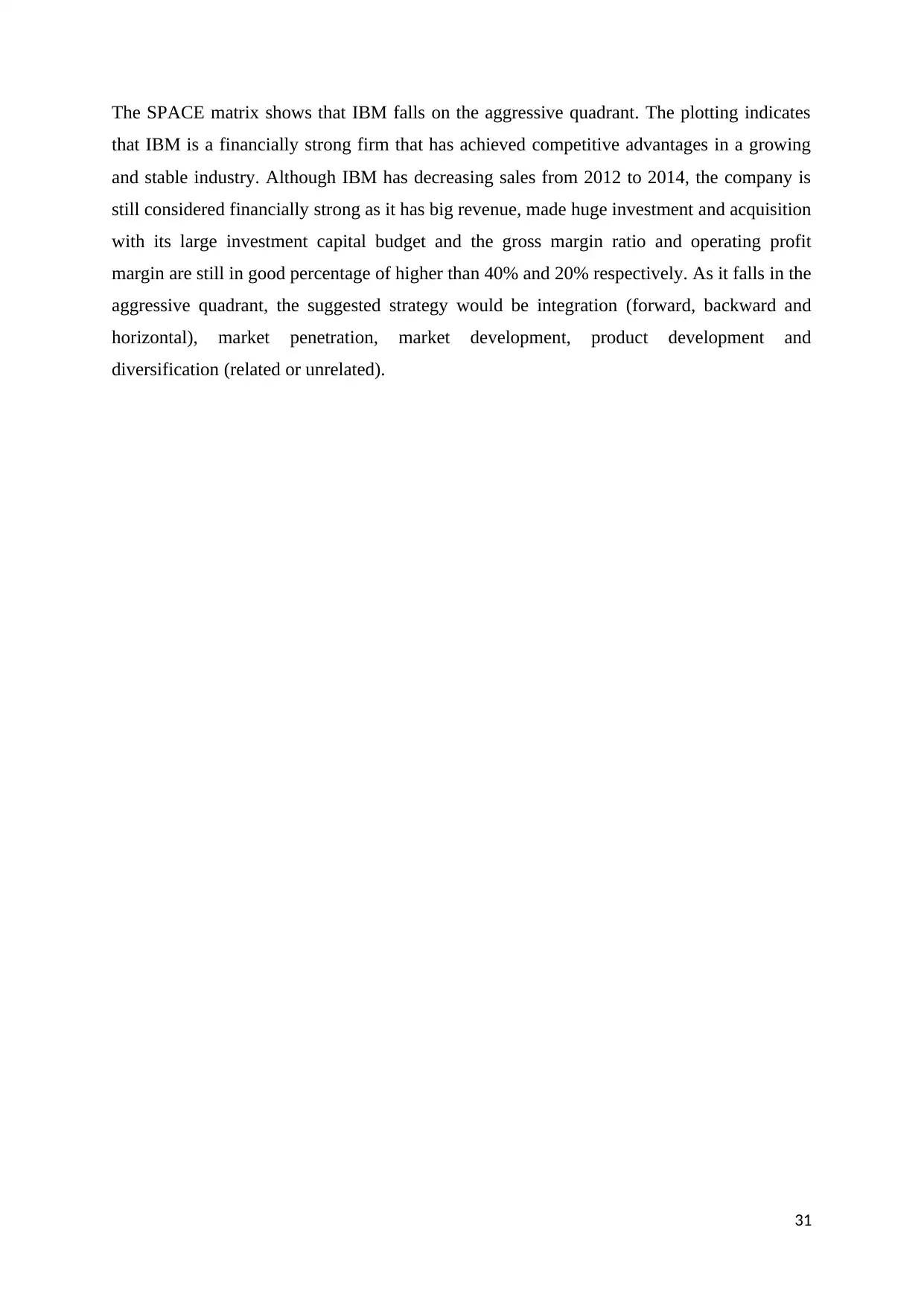
The SPACE matrix shows that IBM falls on the aggressive quadrant. The plotting indicates
that IBM is a financially strong firm that has achieved competitive advantages in a growing
and stable industry. Although IBM has decreasing sales from 2012 to 2014, the company is
still considered financially strong as it has big revenue, made huge investment and acquisition
with its large investment capital budget and the gross margin ratio and operating profit
margin are still in good percentage of higher than 40% and 20% respectively. As it falls in the
aggressive quadrant, the suggested strategy would be integration (forward, backward and
horizontal), market penetration, market development, product development and
diversification (related or unrelated).
31
that IBM is a financially strong firm that has achieved competitive advantages in a growing
and stable industry. Although IBM has decreasing sales from 2012 to 2014, the company is
still considered financially strong as it has big revenue, made huge investment and acquisition
with its large investment capital budget and the gross margin ratio and operating profit
margin are still in good percentage of higher than 40% and 20% respectively. As it falls in the
aggressive quadrant, the suggested strategy would be integration (forward, backward and
horizontal), market penetration, market development, product development and
diversification (related or unrelated).
31
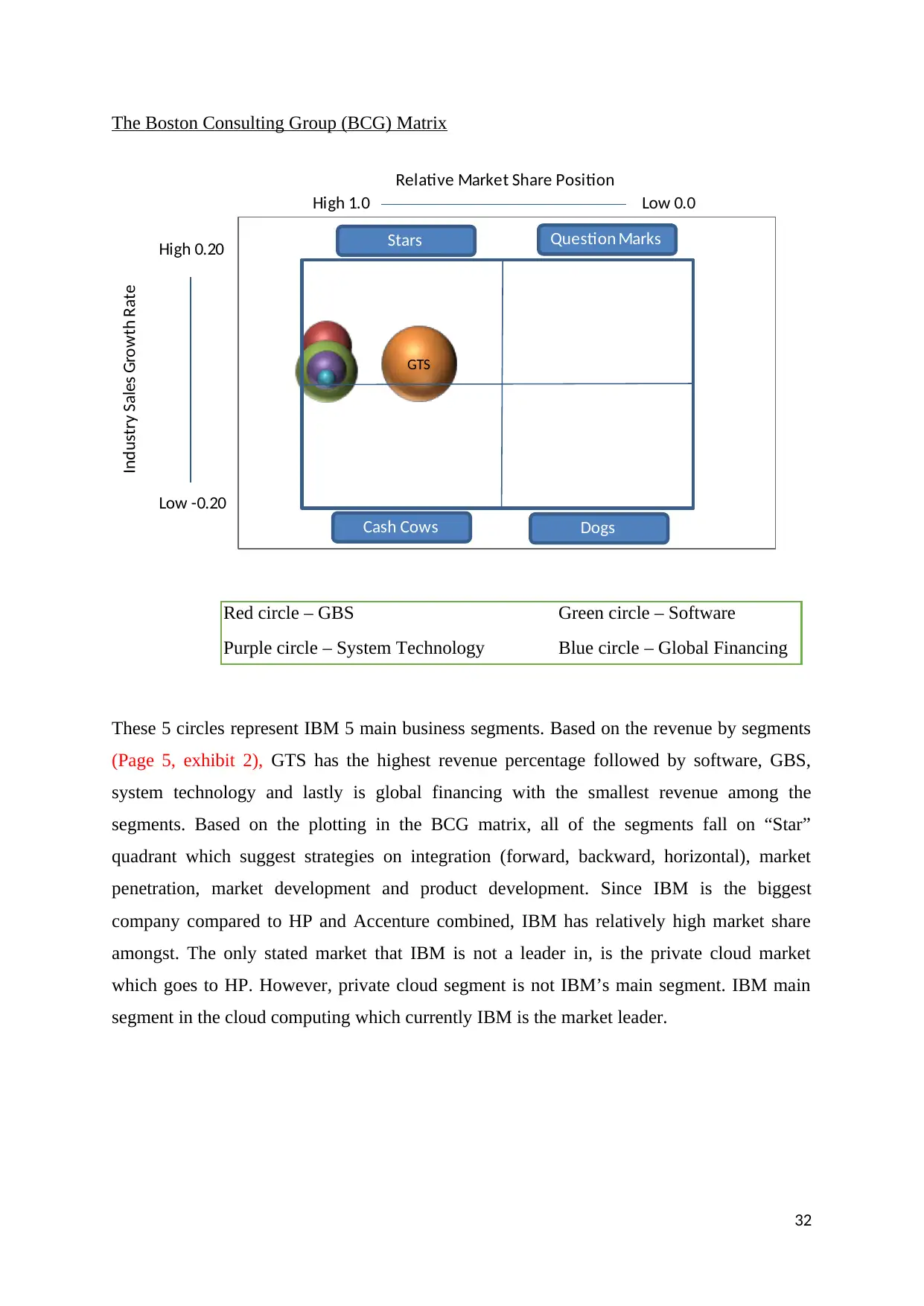
The Boston Consulting Group (BCG) Matrix
High 1.0
High 0.20
Low -0.20
Low 0.0
Industry Sales Growth Rate
Relative Market Share Position
GTS
Question MarksStars
Cash Cows Dogs
Red circle – GBS Green circle – Software
Purple circle – System Technology Blue circle – Global Financing
These 5 circles represent IBM 5 main business segments. Based on the revenue by segments
(Page 5, exhibit 2), GTS has the highest revenue percentage followed by software, GBS,
system technology and lastly is global financing with the smallest revenue among the
segments. Based on the plotting in the BCG matrix, all of the segments fall on “Star”
quadrant which suggest strategies on integration (forward, backward, horizontal), market
penetration, market development and product development. Since IBM is the biggest
company compared to HP and Accenture combined, IBM has relatively high market share
amongst. The only stated market that IBM is not a leader in, is the private cloud market
which goes to HP. However, private cloud segment is not IBM’s main segment. IBM main
segment in the cloud computing which currently IBM is the market leader.
32
High 1.0
High 0.20
Low -0.20
Low 0.0
Industry Sales Growth Rate
Relative Market Share Position
GTS
Question MarksStars
Cash Cows Dogs
Red circle – GBS Green circle – Software
Purple circle – System Technology Blue circle – Global Financing
These 5 circles represent IBM 5 main business segments. Based on the revenue by segments
(Page 5, exhibit 2), GTS has the highest revenue percentage followed by software, GBS,
system technology and lastly is global financing with the smallest revenue among the
segments. Based on the plotting in the BCG matrix, all of the segments fall on “Star”
quadrant which suggest strategies on integration (forward, backward, horizontal), market
penetration, market development and product development. Since IBM is the biggest
company compared to HP and Accenture combined, IBM has relatively high market share
amongst. The only stated market that IBM is not a leader in, is the private cloud market
which goes to HP. However, private cloud segment is not IBM’s main segment. IBM main
segment in the cloud computing which currently IBM is the market leader.
32
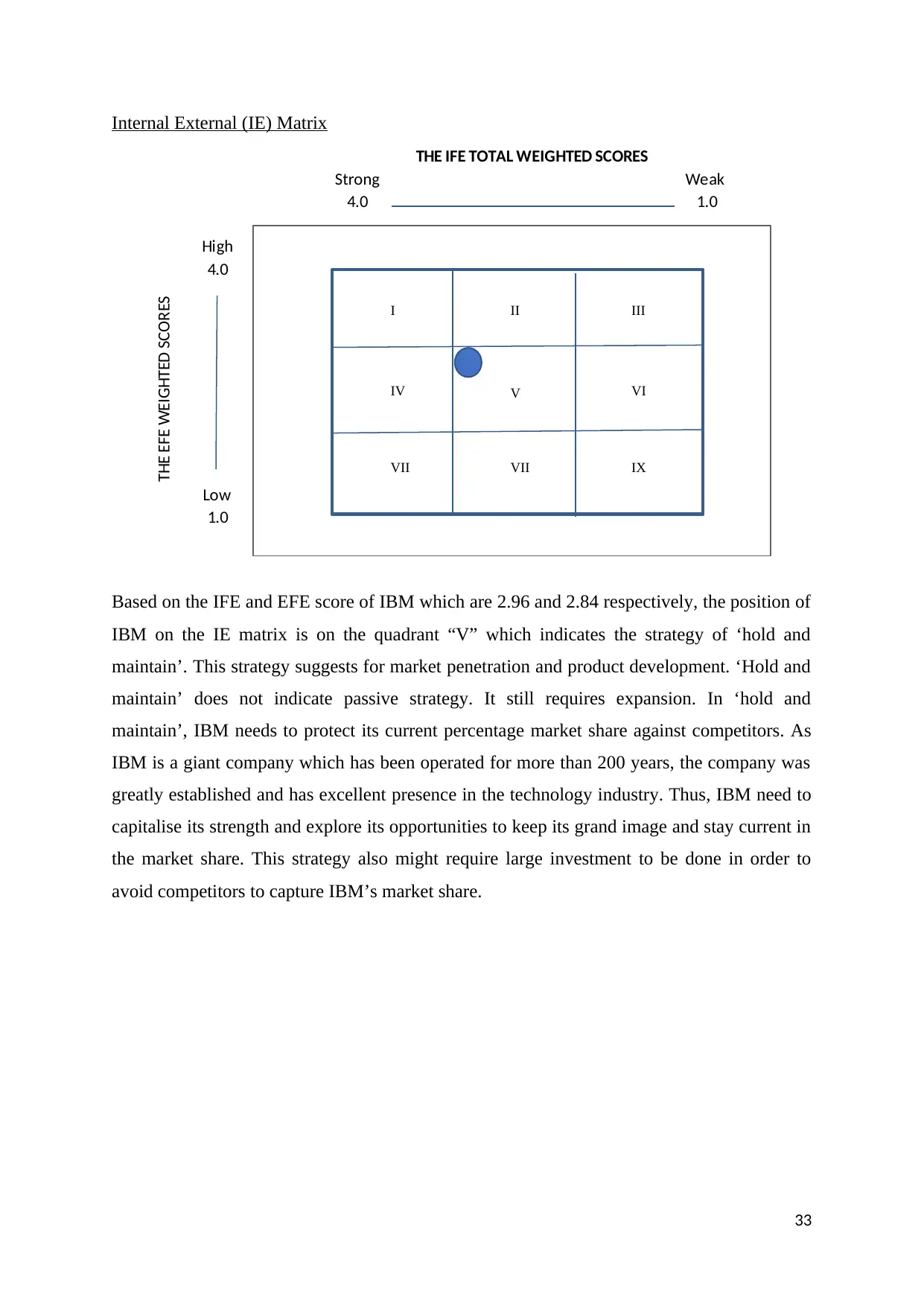
Internal External (IE) Matrix
Strong Weak
4.0 1.0
High
4.0
Low
1.0
THE IFE TOTAL WEIGHTED SCORES
THE EFE WEIGHTED SCORES
Based on the IFE and EFE score of IBM which are 2.96 and 2.84 respectively, the position of
IBM on the IE matrix is on the quadrant “V” which indicates the strategy of ‘hold and
maintain’. This strategy suggests for market penetration and product development. ‘Hold and
maintain’ does not indicate passive strategy. It still requires expansion. In ‘hold and
maintain’, IBM needs to protect its current percentage market share against competitors. As
IBM is a giant company which has been operated for more than 200 years, the company was
greatly established and has excellent presence in the technology industry. Thus, IBM need to
capitalise its strength and explore its opportunities to keep its grand image and stay current in
the market share. This strategy also might require large investment to be done in order to
avoid competitors to capture IBM’s market share.
33
I
IV
VII VII
V
II III
VI
IX
Strong Weak
4.0 1.0
High
4.0
Low
1.0
THE IFE TOTAL WEIGHTED SCORES
THE EFE WEIGHTED SCORES
Based on the IFE and EFE score of IBM which are 2.96 and 2.84 respectively, the position of
IBM on the IE matrix is on the quadrant “V” which indicates the strategy of ‘hold and
maintain’. This strategy suggests for market penetration and product development. ‘Hold and
maintain’ does not indicate passive strategy. It still requires expansion. In ‘hold and
maintain’, IBM needs to protect its current percentage market share against competitors. As
IBM is a giant company which has been operated for more than 200 years, the company was
greatly established and has excellent presence in the technology industry. Thus, IBM need to
capitalise its strength and explore its opportunities to keep its grand image and stay current in
the market share. This strategy also might require large investment to be done in order to
avoid competitors to capture IBM’s market share.
33
I
IV
VII VII
V
II III
VI
IX
Secure Best Marks with AI Grader
Need help grading? Try our AI Grader for instant feedback on your assignments.
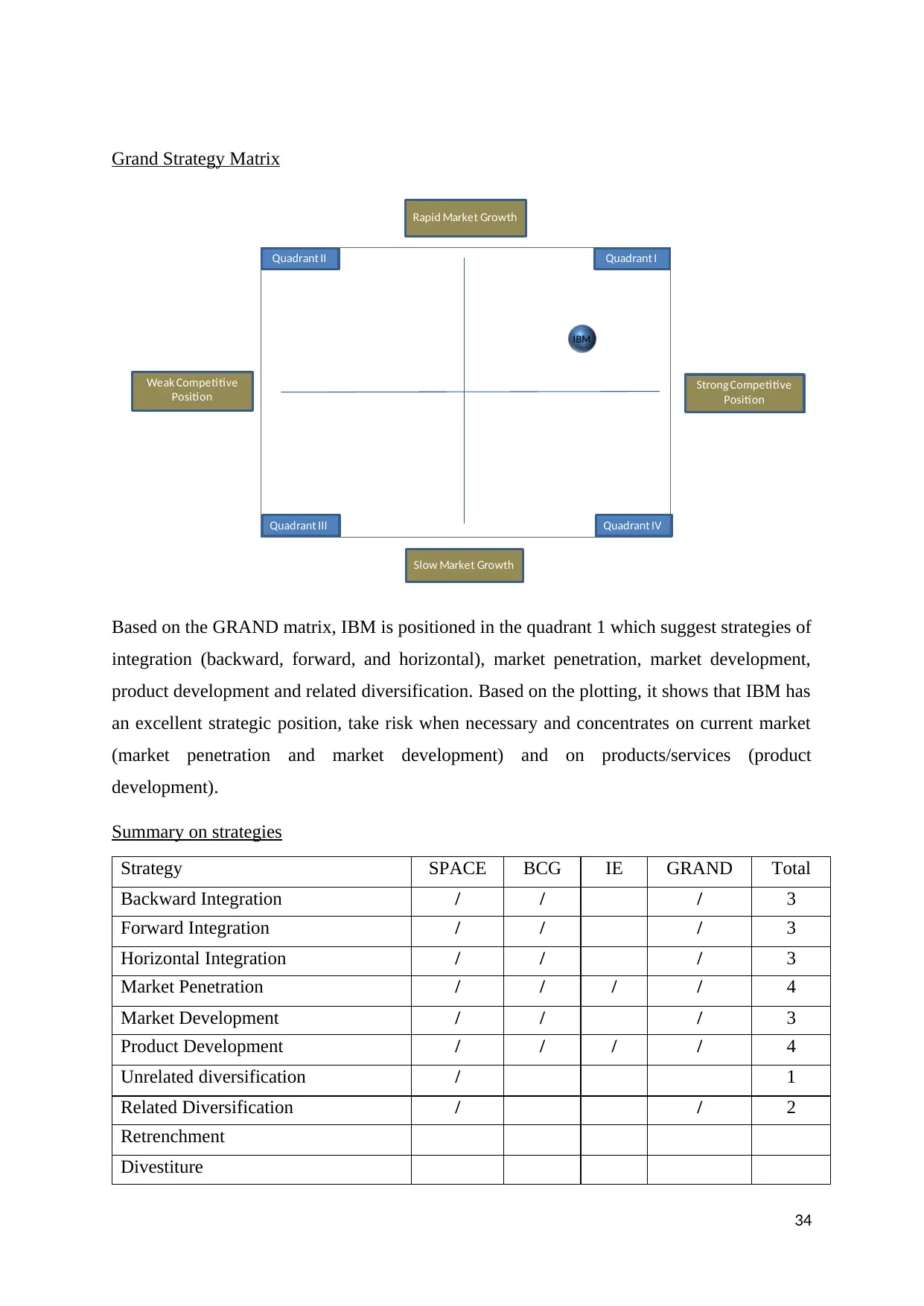
Grand Strategy Matrix
IBM
Quadrant II Quadrant I
Quadrant III Quadrant IV
Rapid Market Growth
Slow Market Growth
Strong Competitive
Position
Weak Competitive
Position
Based on the GRAND matrix, IBM is positioned in the quadrant 1 which suggest strategies of
integration (backward, forward, and horizontal), market penetration, market development,
product development and related diversification. Based on the plotting, it shows that IBM has
an excellent strategic position, take risk when necessary and concentrates on current market
(market penetration and market development) and on products/services (product
development).
Summary on strategies
Strategy SPACE BCG IE GRAND Total
Backward Integration / / / 3
Forward Integration / / / 3
Horizontal Integration / / / 3
Market Penetration / / / / 4
Market Development / / / 3
Product Development / / / / 4
Unrelated diversification / 1
Related Diversification / / 2
Retrenchment
Divestiture
34
IBM
Quadrant II Quadrant I
Quadrant III Quadrant IV
Rapid Market Growth
Slow Market Growth
Strong Competitive
Position
Weak Competitive
Position
Based on the GRAND matrix, IBM is positioned in the quadrant 1 which suggest strategies of
integration (backward, forward, and horizontal), market penetration, market development,
product development and related diversification. Based on the plotting, it shows that IBM has
an excellent strategic position, take risk when necessary and concentrates on current market
(market penetration and market development) and on products/services (product
development).
Summary on strategies
Strategy SPACE BCG IE GRAND Total
Backward Integration / / / 3
Forward Integration / / / 3
Horizontal Integration / / / 3
Market Penetration / / / / 4
Market Development / / / 3
Product Development / / / / 4
Unrelated diversification / 1
Related Diversification / / 2
Retrenchment
Divestiture
34
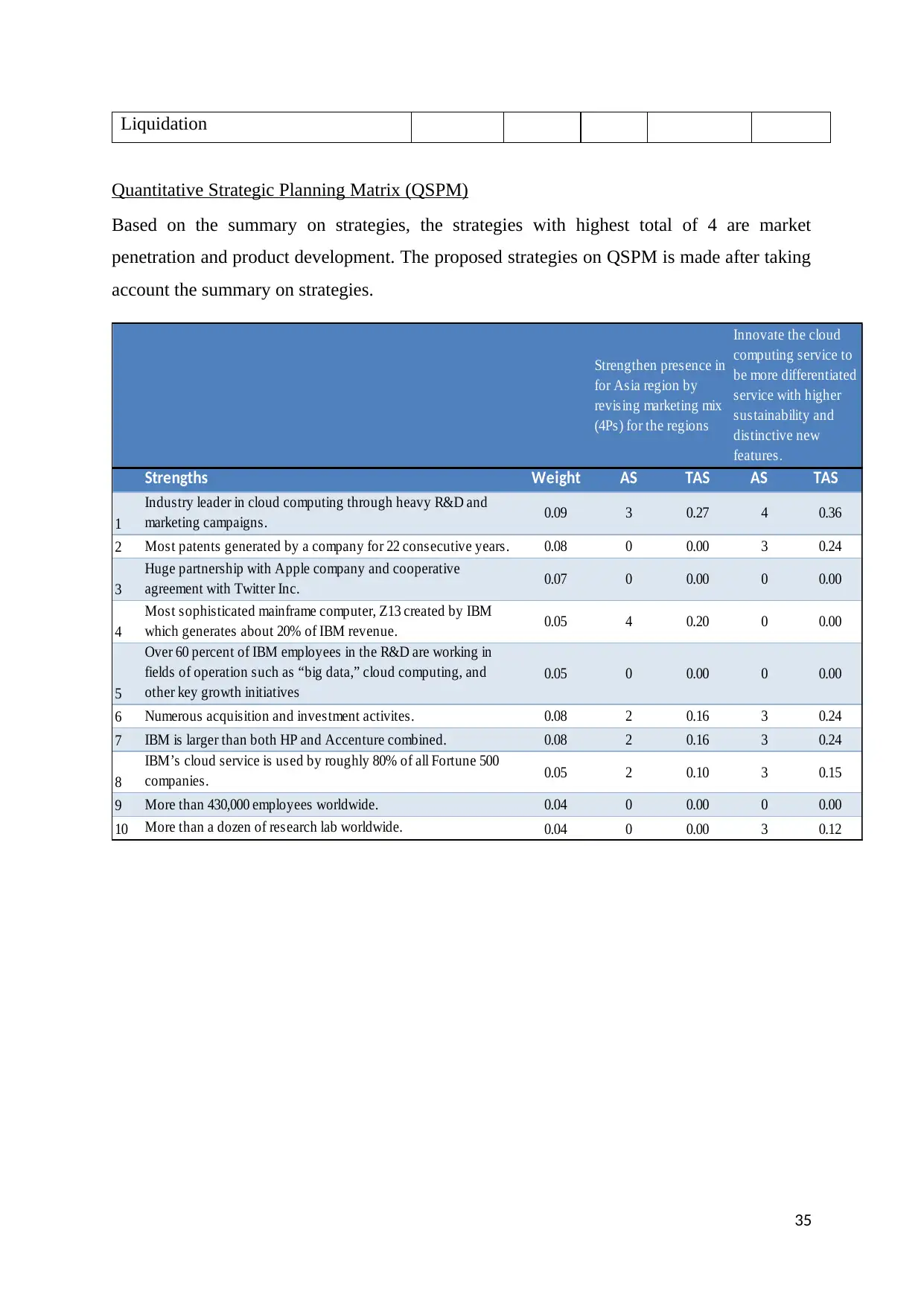
Liquidation
Quantitative Strategic Planning Matrix (QSPM)
Based on the summary on strategies, the strategies with highest total of 4 are market
penetration and product development. The proposed strategies on QSPM is made after taking
account the summary on strategies.
Strengths Weight AS TAS AS TAS
1
Industry leader in cloud computing through heavy R&D and
marketing campaigns. 0.09 3 0.27 4 0.36
2 Most patents generated by a company for 22 consecutive years. 0.08 0 0.00 3 0.24
3
Huge partnership with Apple company and cooperative
agreement with Twitter Inc. 0.07 0 0.00 0 0.00
4
Most sophisticated mainframe computer, Z13 created by IBM
which generates about 20% of IBM revenue. 0.05 4 0.20 0 0.00
5
Over 60 percent of IBM employees in the R&D are working in
fields of operation such as “big data,” cloud computing, and
other key growth initiatives
0.05 0 0.00 0 0.00
6 Numerous acquisition and investment activites. 0.08 2 0.16 3 0.24
7 IBM is larger than both HP and Accenture combined. 0.08 2 0.16 3 0.24
8
IBM’s cloud service is used by roughly 80% of all Fortune 500
companies. 0.05 2 0.10 3 0.15
9 More than 430,000 employees worldwide. 0.04 0 0.00 0 0.00
10 More than a dozen of research lab worldwide. 0.04 0 0.00 3 0.12
Strengthen presence in
for Asia region by
revising marketing mix
(4Ps) for the regions
Innovate the cloud
computing service to
be more differentiated
service with higher
sustainability and
distinctive new
features.
35
Quantitative Strategic Planning Matrix (QSPM)
Based on the summary on strategies, the strategies with highest total of 4 are market
penetration and product development. The proposed strategies on QSPM is made after taking
account the summary on strategies.
Strengths Weight AS TAS AS TAS
1
Industry leader in cloud computing through heavy R&D and
marketing campaigns. 0.09 3 0.27 4 0.36
2 Most patents generated by a company for 22 consecutive years. 0.08 0 0.00 3 0.24
3
Huge partnership with Apple company and cooperative
agreement with Twitter Inc. 0.07 0 0.00 0 0.00
4
Most sophisticated mainframe computer, Z13 created by IBM
which generates about 20% of IBM revenue. 0.05 4 0.20 0 0.00
5
Over 60 percent of IBM employees in the R&D are working in
fields of operation such as “big data,” cloud computing, and
other key growth initiatives
0.05 0 0.00 0 0.00
6 Numerous acquisition and investment activites. 0.08 2 0.16 3 0.24
7 IBM is larger than both HP and Accenture combined. 0.08 2 0.16 3 0.24
8
IBM’s cloud service is used by roughly 80% of all Fortune 500
companies. 0.05 2 0.10 3 0.15
9 More than 430,000 employees worldwide. 0.04 0 0.00 0 0.00
10 More than a dozen of research lab worldwide. 0.04 0 0.00 3 0.12
Strengthen presence in
for Asia region by
revising marketing mix
(4Ps) for the regions
Innovate the cloud
computing service to
be more differentiated
service with higher
sustainability and
distinctive new
features.
35
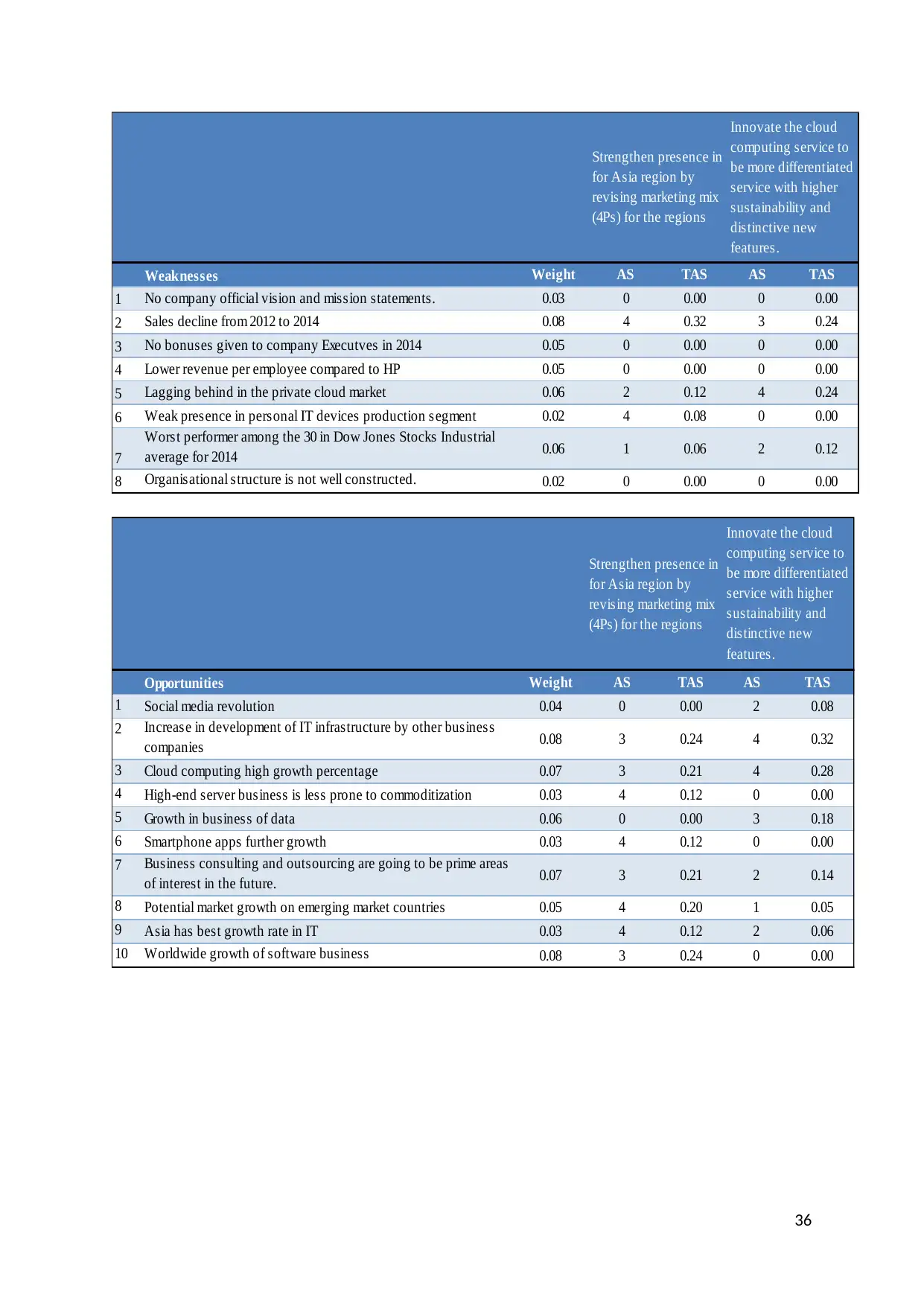
Weaknesses Weight AS TAS AS TAS
1 No company official vision and mission statements. 0.03 0 0.00 0 0.00
2 Sales decline from 2012 to 2014 0.08 4 0.32 3 0.24
3 No bonuses given to company Executves in 2014 0.05 0 0.00 0 0.00
4 Lower revenue per employee compared to HP 0.05 0 0.00 0 0.00
5 Lagging behind in the private cloud market 0.06 2 0.12 4 0.24
6 Weak presence in personal IT devices production segment 0.02 4 0.08 0 0.00
7
Worst performer among the 30 in Dow Jones Stocks Industrial
average for 2014 0.06 1 0.06 2 0.12
8 Organisational structure is not well constructed. 0.02 0 0.00 0 0.00
Innovate the cloud
computing service to
be more differentiated
service with higher
sustainability and
distinctive new
features.
Strengthen presence in
for Asia region by
revising marketing mix
(4Ps) for the regions
Opportunities Weight AS TAS AS TAS
1 Social media revolution 0.04 0 0.00 2 0.08
2 Increase in development of IT infrastructure by other business
companies 0.08 3 0.24 4 0.32
3 Cloud computing high growth percentage 0.07 3 0.21 4 0.28
4 High-end server business is less prone to commoditization 0.03 4 0.12 0 0.00
5 Growth in business of data 0.06 0 0.00 3 0.18
6 Smartphone apps further growth 0.03 4 0.12 0 0.00
7 Business consulting and outsourcing are going to be prime areas
of interest in the future. 0.07 3 0.21 2 0.14
8 Potential market growth on emerging market countries 0.05 4 0.20 1 0.05
9 Asia has best growth rate in IT 0.03 4 0.12 2 0.06
10 Worldwide growth of software business 0.08 3 0.24 0 0.00
Innovate the cloud
computing service to
be more differentiated
service with higher
sustainability and
distinctive new
features.
Strengthen presence in
for Asia region by
revising marketing mix
(4Ps) for the regions
36
1 No company official vision and mission statements. 0.03 0 0.00 0 0.00
2 Sales decline from 2012 to 2014 0.08 4 0.32 3 0.24
3 No bonuses given to company Executves in 2014 0.05 0 0.00 0 0.00
4 Lower revenue per employee compared to HP 0.05 0 0.00 0 0.00
5 Lagging behind in the private cloud market 0.06 2 0.12 4 0.24
6 Weak presence in personal IT devices production segment 0.02 4 0.08 0 0.00
7
Worst performer among the 30 in Dow Jones Stocks Industrial
average for 2014 0.06 1 0.06 2 0.12
8 Organisational structure is not well constructed. 0.02 0 0.00 0 0.00
Innovate the cloud
computing service to
be more differentiated
service with higher
sustainability and
distinctive new
features.
Strengthen presence in
for Asia region by
revising marketing mix
(4Ps) for the regions
Opportunities Weight AS TAS AS TAS
1 Social media revolution 0.04 0 0.00 2 0.08
2 Increase in development of IT infrastructure by other business
companies 0.08 3 0.24 4 0.32
3 Cloud computing high growth percentage 0.07 3 0.21 4 0.28
4 High-end server business is less prone to commoditization 0.03 4 0.12 0 0.00
5 Growth in business of data 0.06 0 0.00 3 0.18
6 Smartphone apps further growth 0.03 4 0.12 0 0.00
7 Business consulting and outsourcing are going to be prime areas
of interest in the future. 0.07 3 0.21 2 0.14
8 Potential market growth on emerging market countries 0.05 4 0.20 1 0.05
9 Asia has best growth rate in IT 0.03 4 0.12 2 0.06
10 Worldwide growth of software business 0.08 3 0.24 0 0.00
Innovate the cloud
computing service to
be more differentiated
service with higher
sustainability and
distinctive new
features.
Strengthen presence in
for Asia region by
revising marketing mix
(4Ps) for the regions
36
Paraphrase This Document
Need a fresh take? Get an instant paraphrase of this document with our AI Paraphraser
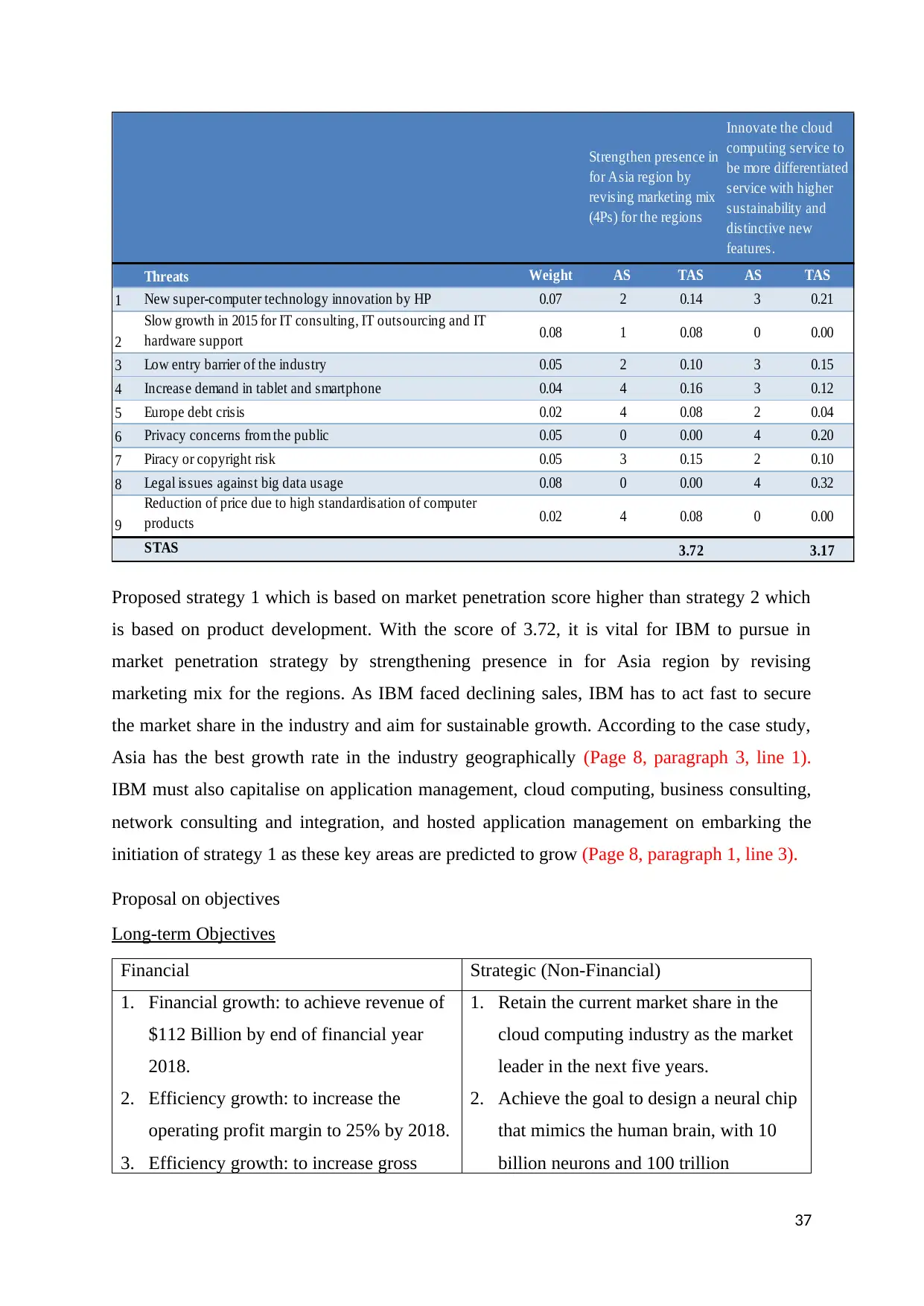
Threats Weight AS TAS AS TAS
1 New super-computer technology innovation by HP 0.07 2 0.14 3 0.21
2
Slow growth in 2015 for IT consulting, IT outsourcing and IT
hardware support 0.08 1 0.08 0 0.00
3 Low entry barrier of the industry 0.05 2 0.10 3 0.15
4 Increase demand in tablet and smartphone 0.04 4 0.16 3 0.12
5 Europe debt crisis 0.02 4 0.08 2 0.04
6 Privacy concerns from the public 0.05 0 0.00 4 0.20
7 Piracy or copyright risk 0.05 3 0.15 2 0.10
8 Legal issues against big data usage 0.08 0 0.00 4 0.32
9
Reduction of price due to high standardisation of computer
products 0.02 4 0.08 0 0.00
STAS 3.72 3.17
Innovate the cloud
computing service to
be more differentiated
service with higher
sustainability and
distinctive new
features.
Strengthen presence in
for Asia region by
revising marketing mix
(4Ps) for the regions
Proposed strategy 1 which is based on market penetration score higher than strategy 2 which
is based on product development. With the score of 3.72, it is vital for IBM to pursue in
market penetration strategy by strengthening presence in for Asia region by revising
marketing mix for the regions. As IBM faced declining sales, IBM has to act fast to secure
the market share in the industry and aim for sustainable growth. According to the case study,
Asia has the best growth rate in the industry geographically (Page 8, paragraph 3, line 1).
IBM must also capitalise on application management, cloud computing, business consulting,
network consulting and integration, and hosted application management on embarking the
initiation of strategy 1 as these key areas are predicted to grow (Page 8, paragraph 1, line 3).
Proposal on objectives
Long-term Objectives
Financial Strategic (Non-Financial)
1. Financial growth: to achieve revenue of
$112 Billion by end of financial year
2018.
2. Efficiency growth: to increase the
operating profit margin to 25% by 2018.
3. Efficiency growth: to increase gross
1. Retain the current market share in the
cloud computing industry as the market
leader in the next five years.
2. Achieve the goal to design a neural chip
that mimics the human brain, with 10
billion neurons and 100 trillion
37
1 New super-computer technology innovation by HP 0.07 2 0.14 3 0.21
2
Slow growth in 2015 for IT consulting, IT outsourcing and IT
hardware support 0.08 1 0.08 0 0.00
3 Low entry barrier of the industry 0.05 2 0.10 3 0.15
4 Increase demand in tablet and smartphone 0.04 4 0.16 3 0.12
5 Europe debt crisis 0.02 4 0.08 2 0.04
6 Privacy concerns from the public 0.05 0 0.00 4 0.20
7 Piracy or copyright risk 0.05 3 0.15 2 0.10
8 Legal issues against big data usage 0.08 0 0.00 4 0.32
9
Reduction of price due to high standardisation of computer
products 0.02 4 0.08 0 0.00
STAS 3.72 3.17
Innovate the cloud
computing service to
be more differentiated
service with higher
sustainability and
distinctive new
features.
Strengthen presence in
for Asia region by
revising marketing mix
(4Ps) for the regions
Proposed strategy 1 which is based on market penetration score higher than strategy 2 which
is based on product development. With the score of 3.72, it is vital for IBM to pursue in
market penetration strategy by strengthening presence in for Asia region by revising
marketing mix for the regions. As IBM faced declining sales, IBM has to act fast to secure
the market share in the industry and aim for sustainable growth. According to the case study,
Asia has the best growth rate in the industry geographically (Page 8, paragraph 3, line 1).
IBM must also capitalise on application management, cloud computing, business consulting,
network consulting and integration, and hosted application management on embarking the
initiation of strategy 1 as these key areas are predicted to grow (Page 8, paragraph 1, line 3).
Proposal on objectives
Long-term Objectives
Financial Strategic (Non-Financial)
1. Financial growth: to achieve revenue of
$112 Billion by end of financial year
2018.
2. Efficiency growth: to increase the
operating profit margin to 25% by 2018.
3. Efficiency growth: to increase gross
1. Retain the current market share in the
cloud computing industry as the market
leader in the next five years.
2. Achieve the goal to design a neural chip
that mimics the human brain, with 10
billion neurons and 100 trillion
37
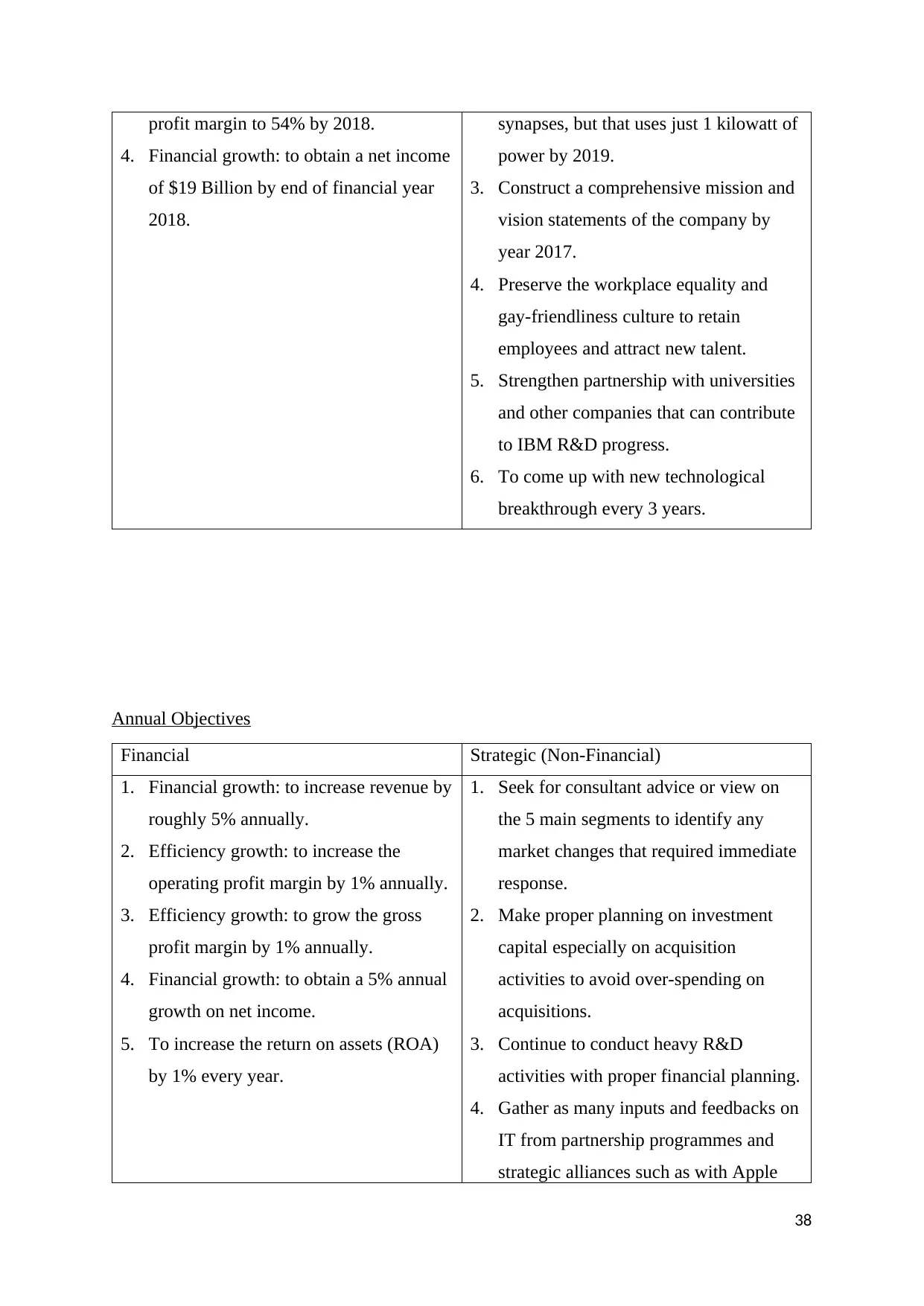
profit margin to 54% by 2018.
4. Financial growth: to obtain a net income
of $19 Billion by end of financial year
2018.
synapses, but that uses just 1 kilowatt of
power by 2019.
3. Construct a comprehensive mission and
vision statements of the company by
year 2017.
4. Preserve the workplace equality and
gay-friendliness culture to retain
employees and attract new talent.
5. Strengthen partnership with universities
and other companies that can contribute
to IBM R&D progress.
6. To come up with new technological
breakthrough every 3 years.
Annual Objectives
Financial Strategic (Non-Financial)
1. Financial growth: to increase revenue by
roughly 5% annually.
2. Efficiency growth: to increase the
operating profit margin by 1% annually.
3. Efficiency growth: to grow the gross
profit margin by 1% annually.
4. Financial growth: to obtain a 5% annual
growth on net income.
5. To increase the return on assets (ROA)
by 1% every year.
1. Seek for consultant advice or view on
the 5 main segments to identify any
market changes that required immediate
response.
2. Make proper planning on investment
capital especially on acquisition
activities to avoid over-spending on
acquisitions.
3. Continue to conduct heavy R&D
activities with proper financial planning.
4. Gather as many inputs and feedbacks on
IT from partnership programmes and
strategic alliances such as with Apple
38
4. Financial growth: to obtain a net income
of $19 Billion by end of financial year
2018.
synapses, but that uses just 1 kilowatt of
power by 2019.
3. Construct a comprehensive mission and
vision statements of the company by
year 2017.
4. Preserve the workplace equality and
gay-friendliness culture to retain
employees and attract new talent.
5. Strengthen partnership with universities
and other companies that can contribute
to IBM R&D progress.
6. To come up with new technological
breakthrough every 3 years.
Annual Objectives
Financial Strategic (Non-Financial)
1. Financial growth: to increase revenue by
roughly 5% annually.
2. Efficiency growth: to increase the
operating profit margin by 1% annually.
3. Efficiency growth: to grow the gross
profit margin by 1% annually.
4. Financial growth: to obtain a 5% annual
growth on net income.
5. To increase the return on assets (ROA)
by 1% every year.
1. Seek for consultant advice or view on
the 5 main segments to identify any
market changes that required immediate
response.
2. Make proper planning on investment
capital especially on acquisition
activities to avoid over-spending on
acquisitions.
3. Continue to conduct heavy R&D
activities with proper financial planning.
4. Gather as many inputs and feedbacks on
IT from partnership programmes and
strategic alliances such as with Apple
38
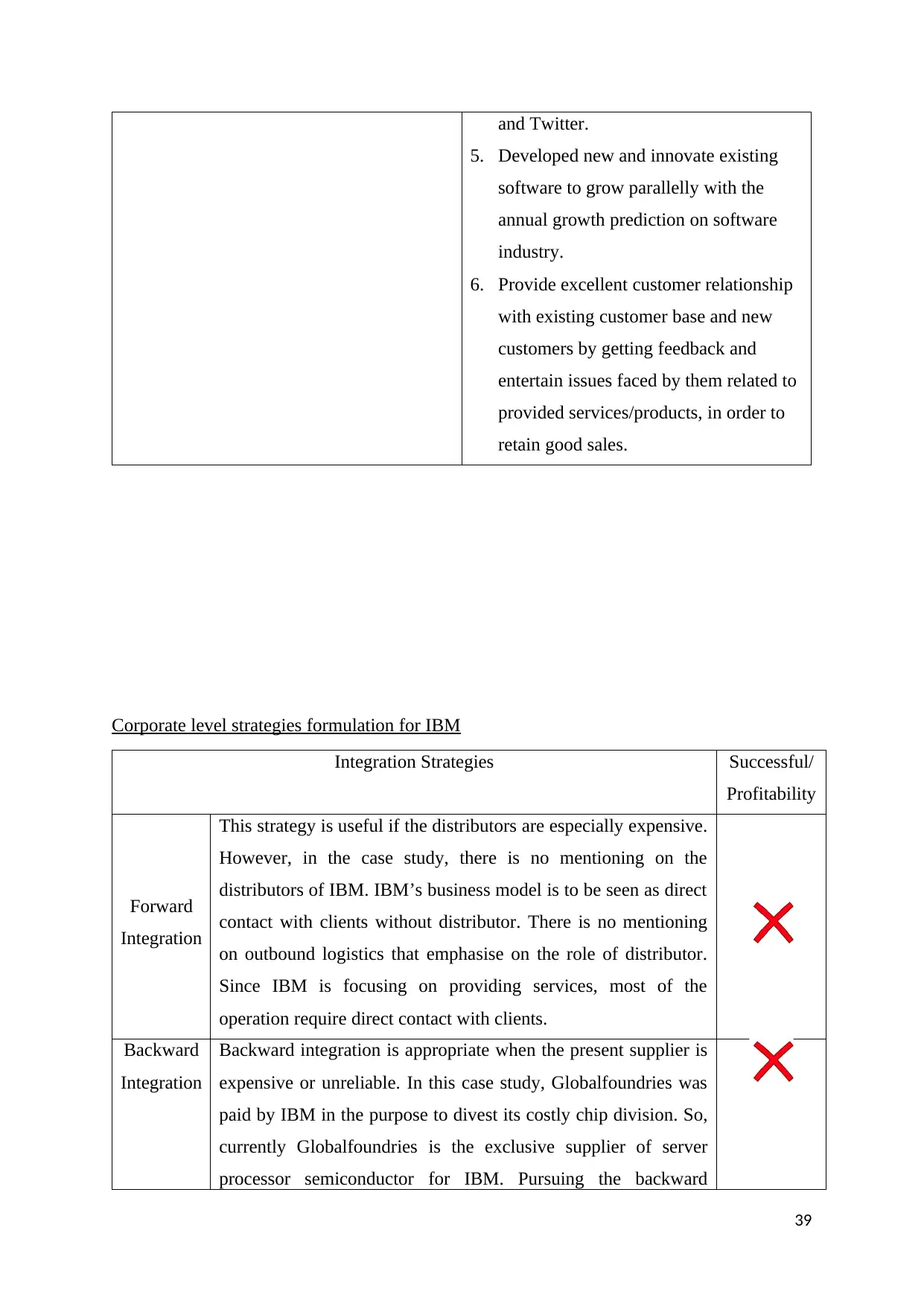
and Twitter.
5. Developed new and innovate existing
software to grow parallelly with the
annual growth prediction on software
industry.
6. Provide excellent customer relationship
with existing customer base and new
customers by getting feedback and
entertain issues faced by them related to
provided services/products, in order to
retain good sales.
Corporate level strategies formulation for IBM
Integration Strategies Successful/
Profitability
Forward
Integration
This strategy is useful if the distributors are especially expensive.
However, in the case study, there is no mentioning on the
distributors of IBM. IBM’s business model is to be seen as direct
contact with clients without distributor. There is no mentioning
on outbound logistics that emphasise on the role of distributor.
Since IBM is focusing on providing services, most of the
operation require direct contact with clients.
Backward
Integration
Backward integration is appropriate when the present supplier is
expensive or unreliable. In this case study, Globalfoundries was
paid by IBM in the purpose to divest its costly chip division. So,
currently Globalfoundries is the exclusive supplier of server
processor semiconductor for IBM. Pursuing the backward
39
5. Developed new and innovate existing
software to grow parallelly with the
annual growth prediction on software
industry.
6. Provide excellent customer relationship
with existing customer base and new
customers by getting feedback and
entertain issues faced by them related to
provided services/products, in order to
retain good sales.
Corporate level strategies formulation for IBM
Integration Strategies Successful/
Profitability
Forward
Integration
This strategy is useful if the distributors are especially expensive.
However, in the case study, there is no mentioning on the
distributors of IBM. IBM’s business model is to be seen as direct
contact with clients without distributor. There is no mentioning
on outbound logistics that emphasise on the role of distributor.
Since IBM is focusing on providing services, most of the
operation require direct contact with clients.
Backward
Integration
Backward integration is appropriate when the present supplier is
expensive or unreliable. In this case study, Globalfoundries was
paid by IBM in the purpose to divest its costly chip division. So,
currently Globalfoundries is the exclusive supplier of server
processor semiconductor for IBM. Pursuing the backward
39
Secure Best Marks with AI Grader
Need help grading? Try our AI Grader for instant feedback on your assignments.
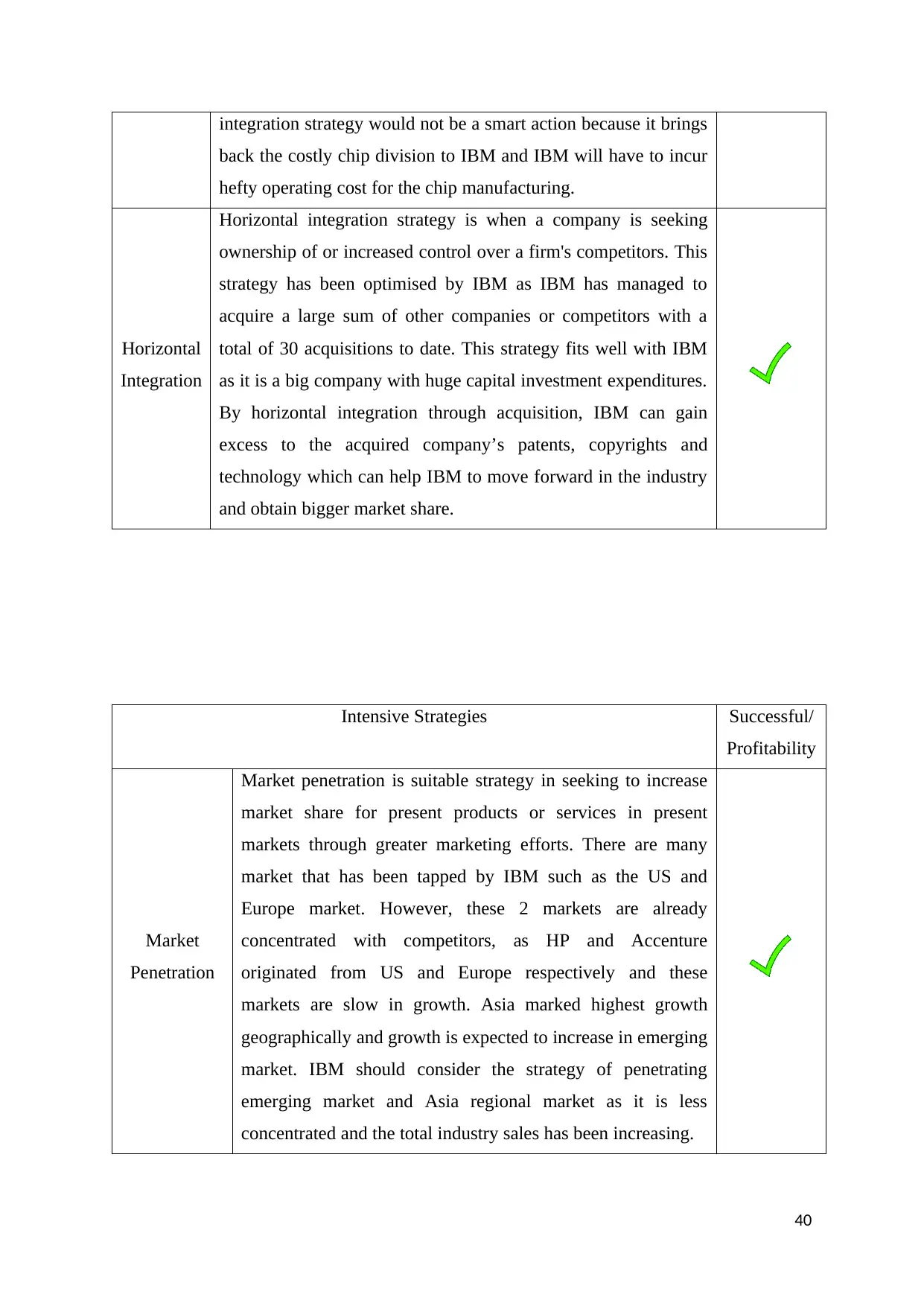
integration strategy would not be a smart action because it brings
back the costly chip division to IBM and IBM will have to incur
hefty operating cost for the chip manufacturing.
Horizontal
Integration
Horizontal integration strategy is when a company is seeking
ownership of or increased control over a firm's competitors. This
strategy has been optimised by IBM as IBM has managed to
acquire a large sum of other companies or competitors with a
total of 30 acquisitions to date. This strategy fits well with IBM
as it is a big company with huge capital investment expenditures.
By horizontal integration through acquisition, IBM can gain
excess to the acquired company’s patents, copyrights and
technology which can help IBM to move forward in the industry
and obtain bigger market share.
Intensive Strategies Successful/
Profitability
Market
Penetration
Market penetration is suitable strategy in seeking to increase
market share for present products or services in present
markets through greater marketing efforts. There are many
market that has been tapped by IBM such as the US and
Europe market. However, these 2 markets are already
concentrated with competitors, as HP and Accenture
originated from US and Europe respectively and these
markets are slow in growth. Asia marked highest growth
geographically and growth is expected to increase in emerging
market. IBM should consider the strategy of penetrating
emerging market and Asia regional market as it is less
concentrated and the total industry sales has been increasing.
40
back the costly chip division to IBM and IBM will have to incur
hefty operating cost for the chip manufacturing.
Horizontal
Integration
Horizontal integration strategy is when a company is seeking
ownership of or increased control over a firm's competitors. This
strategy has been optimised by IBM as IBM has managed to
acquire a large sum of other companies or competitors with a
total of 30 acquisitions to date. This strategy fits well with IBM
as it is a big company with huge capital investment expenditures.
By horizontal integration through acquisition, IBM can gain
excess to the acquired company’s patents, copyrights and
technology which can help IBM to move forward in the industry
and obtain bigger market share.
Intensive Strategies Successful/
Profitability
Market
Penetration
Market penetration is suitable strategy in seeking to increase
market share for present products or services in present
markets through greater marketing efforts. There are many
market that has been tapped by IBM such as the US and
Europe market. However, these 2 markets are already
concentrated with competitors, as HP and Accenture
originated from US and Europe respectively and these
markets are slow in growth. Asia marked highest growth
geographically and growth is expected to increase in emerging
market. IBM should consider the strategy of penetrating
emerging market and Asia regional market as it is less
concentrated and the total industry sales has been increasing.
40
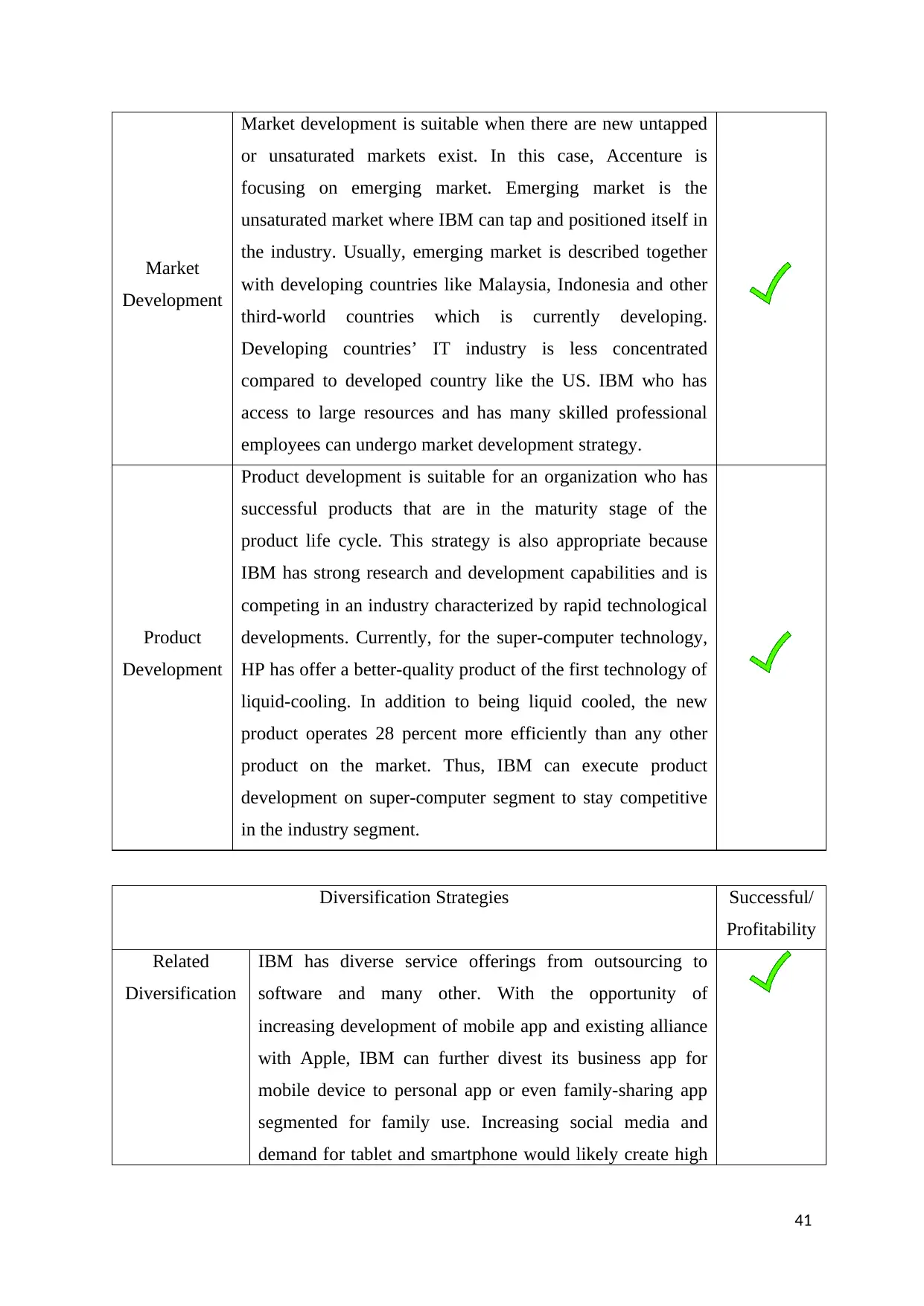
Market
Development
Market development is suitable when there are new untapped
or unsaturated markets exist. In this case, Accenture is
focusing on emerging market. Emerging market is the
unsaturated market where IBM can tap and positioned itself in
the industry. Usually, emerging market is described together
with developing countries like Malaysia, Indonesia and other
third-world countries which is currently developing.
Developing countries’ IT industry is less concentrated
compared to developed country like the US. IBM who has
access to large resources and has many skilled professional
employees can undergo market development strategy.
Product
Development
Product development is suitable for an organization who has
successful products that are in the maturity stage of the
product life cycle. This strategy is also appropriate because
IBM has strong research and development capabilities and is
competing in an industry characterized by rapid technological
developments. Currently, for the super-computer technology,
HP has offer a better-quality product of the first technology of
liquid-cooling. In addition to being liquid cooled, the new
product operates 28 percent more efficiently than any other
product on the market. Thus, IBM can execute product
development on super-computer segment to stay competitive
in the industry segment.
Diversification Strategies Successful/
Profitability
Related
Diversification
IBM has diverse service offerings from outsourcing to
software and many other. With the opportunity of
increasing development of mobile app and existing alliance
with Apple, IBM can further divest its business app for
mobile device to personal app or even family-sharing app
segmented for family use. Increasing social media and
demand for tablet and smartphone would likely create high
41
Development
Market development is suitable when there are new untapped
or unsaturated markets exist. In this case, Accenture is
focusing on emerging market. Emerging market is the
unsaturated market where IBM can tap and positioned itself in
the industry. Usually, emerging market is described together
with developing countries like Malaysia, Indonesia and other
third-world countries which is currently developing.
Developing countries’ IT industry is less concentrated
compared to developed country like the US. IBM who has
access to large resources and has many skilled professional
employees can undergo market development strategy.
Product
Development
Product development is suitable for an organization who has
successful products that are in the maturity stage of the
product life cycle. This strategy is also appropriate because
IBM has strong research and development capabilities and is
competing in an industry characterized by rapid technological
developments. Currently, for the super-computer technology,
HP has offer a better-quality product of the first technology of
liquid-cooling. In addition to being liquid cooled, the new
product operates 28 percent more efficiently than any other
product on the market. Thus, IBM can execute product
development on super-computer segment to stay competitive
in the industry segment.
Diversification Strategies Successful/
Profitability
Related
Diversification
IBM has diverse service offerings from outsourcing to
software and many other. With the opportunity of
increasing development of mobile app and existing alliance
with Apple, IBM can further divest its business app for
mobile device to personal app or even family-sharing app
segmented for family use. Increasing social media and
demand for tablet and smartphone would likely create high
41
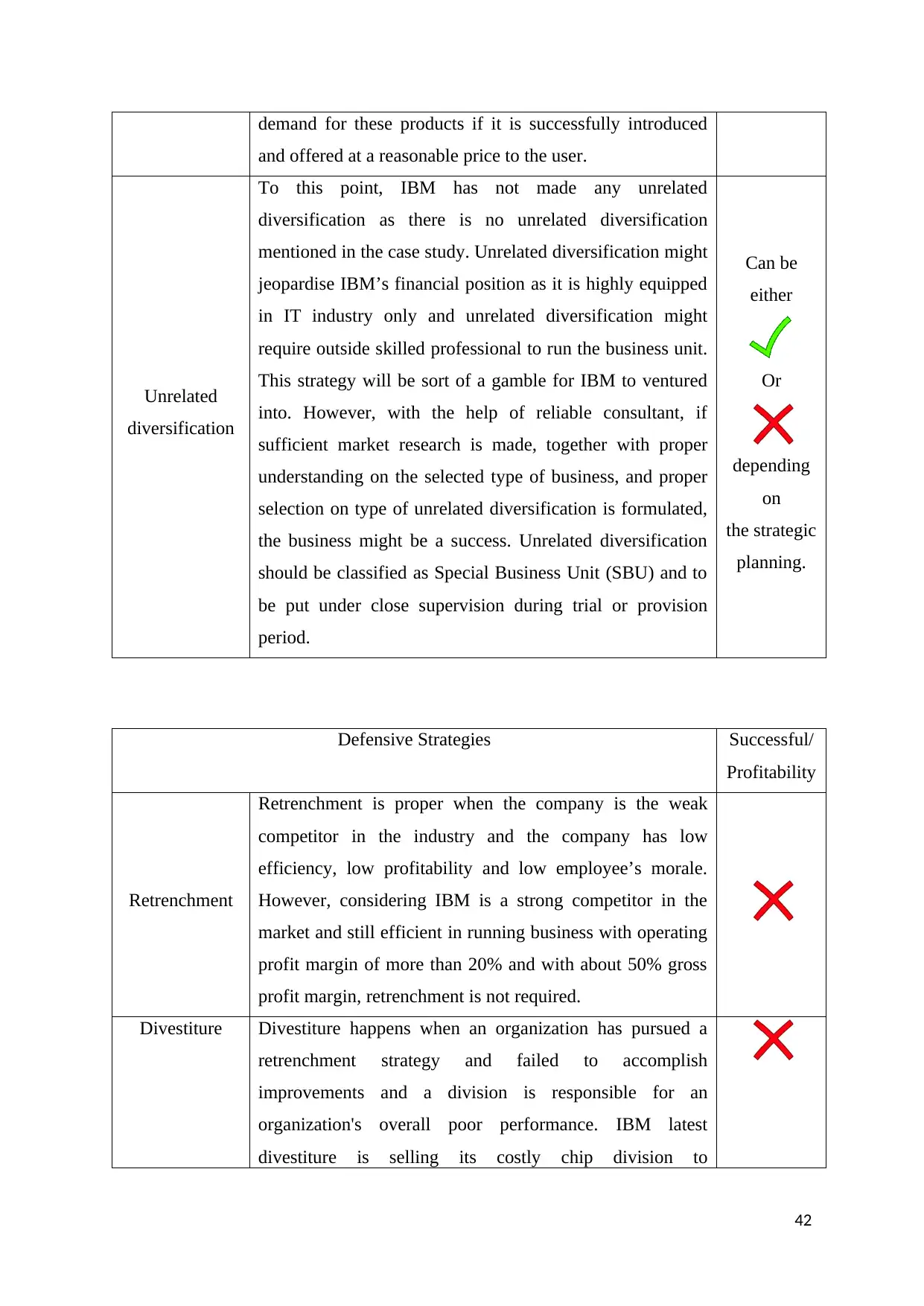
demand for these products if it is successfully introduced
and offered at a reasonable price to the user.
Unrelated
diversification
To this point, IBM has not made any unrelated
diversification as there is no unrelated diversification
mentioned in the case study. Unrelated diversification might
jeopardise IBM’s financial position as it is highly equipped
in IT industry only and unrelated diversification might
require outside skilled professional to run the business unit.
This strategy will be sort of a gamble for IBM to ventured
into. However, with the help of reliable consultant, if
sufficient market research is made, together with proper
understanding on the selected type of business, and proper
selection on type of unrelated diversification is formulated,
the business might be a success. Unrelated diversification
should be classified as Special Business Unit (SBU) and to
be put under close supervision during trial or provision
period.
Can be
either
Or
depending
on
the strategic
planning.
Defensive Strategies Successful/
Profitability
Retrenchment
Retrenchment is proper when the company is the weak
competitor in the industry and the company has low
efficiency, low profitability and low employee’s morale.
However, considering IBM is a strong competitor in the
market and still efficient in running business with operating
profit margin of more than 20% and with about 50% gross
profit margin, retrenchment is not required.
Divestiture Divestiture happens when an organization has pursued a
retrenchment strategy and failed to accomplish
improvements and a division is responsible for an
organization's overall poor performance. IBM latest
divestiture is selling its costly chip division to
42
and offered at a reasonable price to the user.
Unrelated
diversification
To this point, IBM has not made any unrelated
diversification as there is no unrelated diversification
mentioned in the case study. Unrelated diversification might
jeopardise IBM’s financial position as it is highly equipped
in IT industry only and unrelated diversification might
require outside skilled professional to run the business unit.
This strategy will be sort of a gamble for IBM to ventured
into. However, with the help of reliable consultant, if
sufficient market research is made, together with proper
understanding on the selected type of business, and proper
selection on type of unrelated diversification is formulated,
the business might be a success. Unrelated diversification
should be classified as Special Business Unit (SBU) and to
be put under close supervision during trial or provision
period.
Can be
either
Or
depending
on
the strategic
planning.
Defensive Strategies Successful/
Profitability
Retrenchment
Retrenchment is proper when the company is the weak
competitor in the industry and the company has low
efficiency, low profitability and low employee’s morale.
However, considering IBM is a strong competitor in the
market and still efficient in running business with operating
profit margin of more than 20% and with about 50% gross
profit margin, retrenchment is not required.
Divestiture Divestiture happens when an organization has pursued a
retrenchment strategy and failed to accomplish
improvements and a division is responsible for an
organization's overall poor performance. IBM latest
divestiture is selling its costly chip division to
42
Paraphrase This Document
Need a fresh take? Get an instant paraphrase of this document with our AI Paraphraser
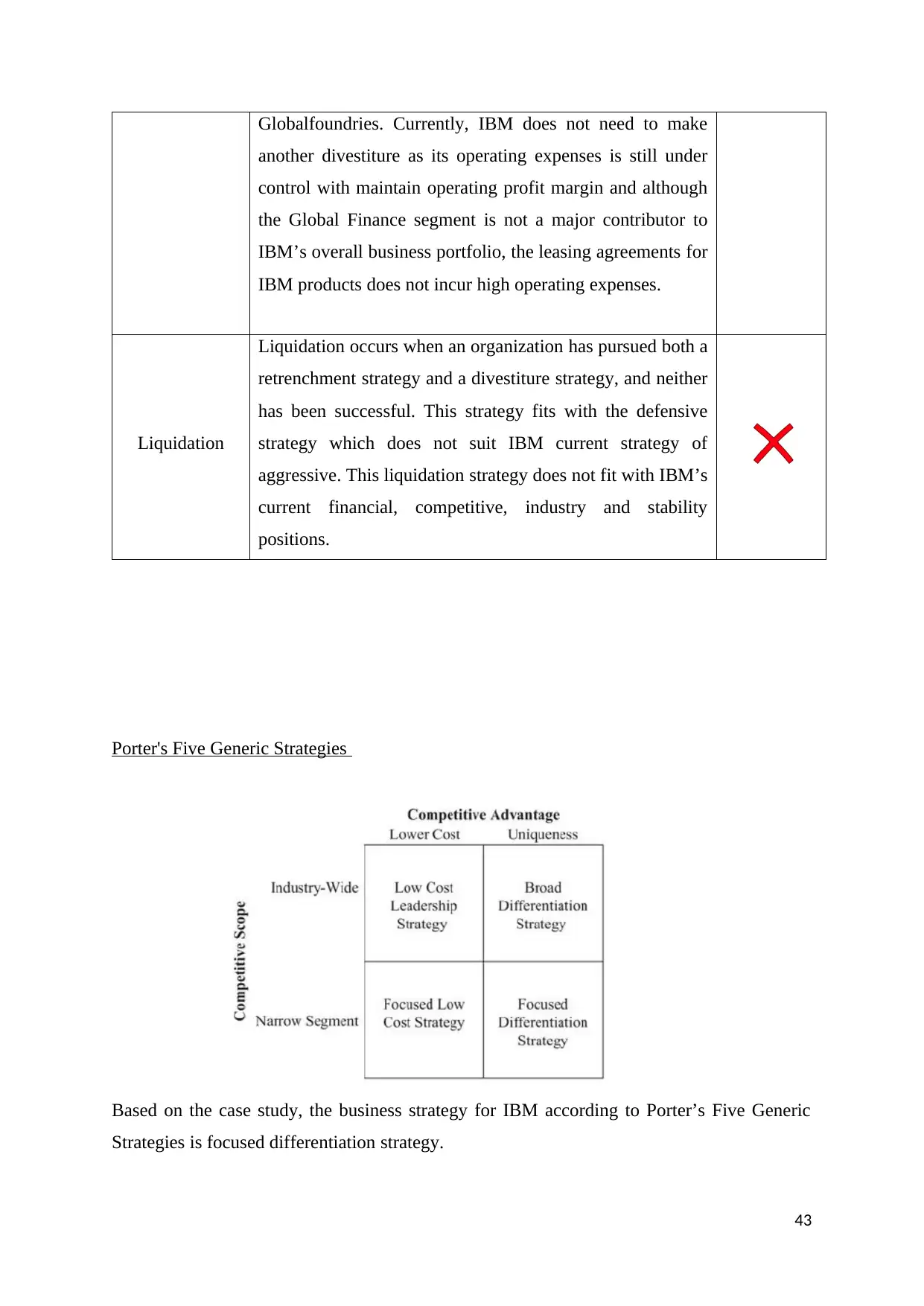
Globalfoundries. Currently, IBM does not need to make
another divestiture as its operating expenses is still under
control with maintain operating profit margin and although
the Global Finance segment is not a major contributor to
IBM’s overall business portfolio, the leasing agreements for
IBM products does not incur high operating expenses.
Liquidation
Liquidation occurs when an organization has pursued both a
retrenchment strategy and a divestiture strategy, and neither
has been successful. This strategy fits with the defensive
strategy which does not suit IBM current strategy of
aggressive. This liquidation strategy does not fit with IBM’s
current financial, competitive, industry and stability
positions.
Porter's Five Generic Strategies
Based on the case study, the business strategy for IBM according to Porter’s Five Generic
Strategies is focused differentiation strategy.
43
another divestiture as its operating expenses is still under
control with maintain operating profit margin and although
the Global Finance segment is not a major contributor to
IBM’s overall business portfolio, the leasing agreements for
IBM products does not incur high operating expenses.
Liquidation
Liquidation occurs when an organization has pursued both a
retrenchment strategy and a divestiture strategy, and neither
has been successful. This strategy fits with the defensive
strategy which does not suit IBM current strategy of
aggressive. This liquidation strategy does not fit with IBM’s
current financial, competitive, industry and stability
positions.
Porter's Five Generic Strategies
Based on the case study, the business strategy for IBM according to Porter’s Five Generic
Strategies is focused differentiation strategy.
43
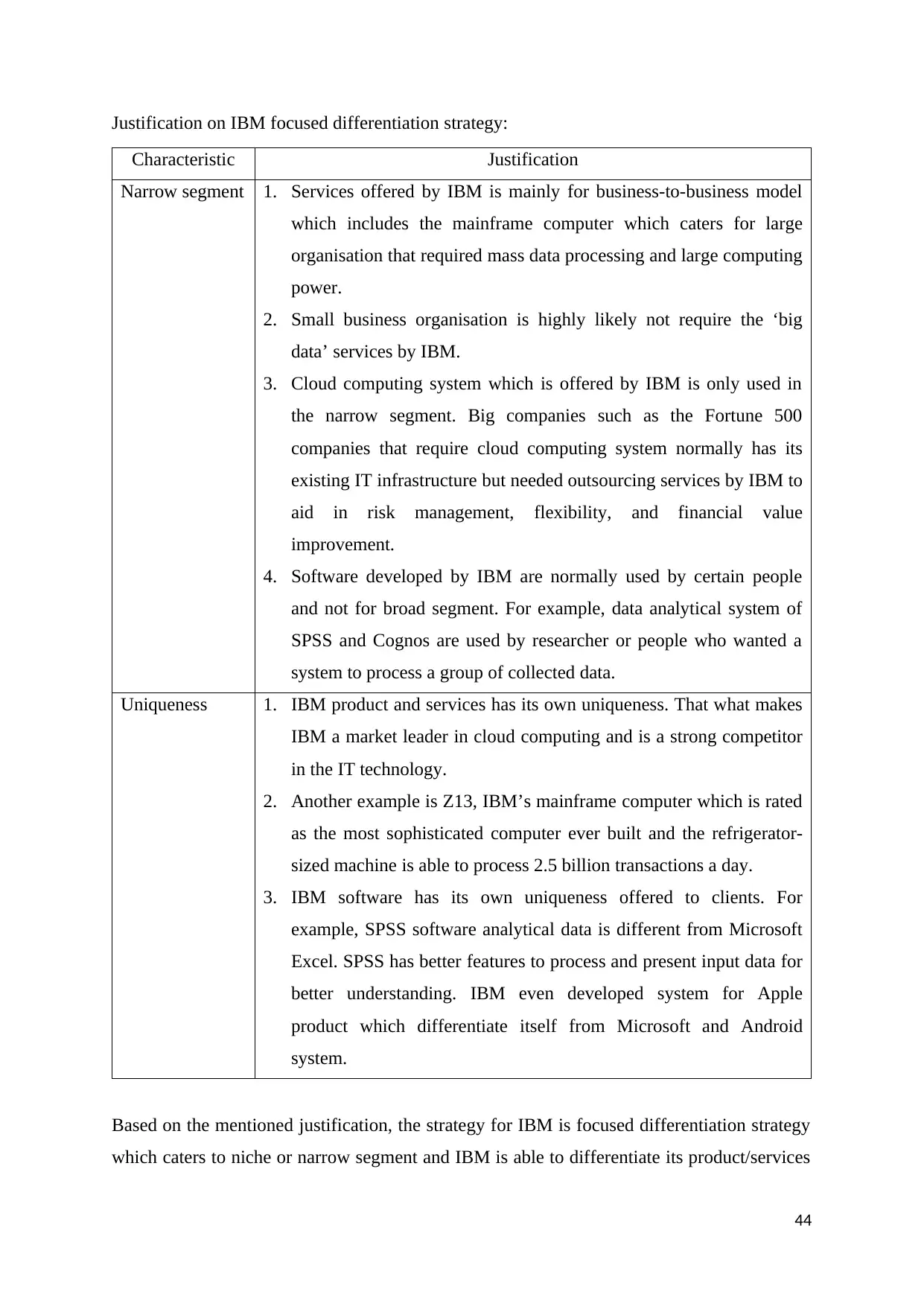
Justification on IBM focused differentiation strategy:
Characteristic Justification
Narrow segment 1. Services offered by IBM is mainly for business-to-business model
which includes the mainframe computer which caters for large
organisation that required mass data processing and large computing
power.
2. Small business organisation is highly likely not require the ‘big
data’ services by IBM.
3. Cloud computing system which is offered by IBM is only used in
the narrow segment. Big companies such as the Fortune 500
companies that require cloud computing system normally has its
existing IT infrastructure but needed outsourcing services by IBM to
aid in risk management, flexibility, and financial value
improvement.
4. Software developed by IBM are normally used by certain people
and not for broad segment. For example, data analytical system of
SPSS and Cognos are used by researcher or people who wanted a
system to process a group of collected data.
Uniqueness 1. IBM product and services has its own uniqueness. That what makes
IBM a market leader in cloud computing and is a strong competitor
in the IT technology.
2. Another example is Z13, IBM’s mainframe computer which is rated
as the most sophisticated computer ever built and the refrigerator-
sized machine is able to process 2.5 billion transactions a day.
3. IBM software has its own uniqueness offered to clients. For
example, SPSS software analytical data is different from Microsoft
Excel. SPSS has better features to process and present input data for
better understanding. IBM even developed system for Apple
product which differentiate itself from Microsoft and Android
system.
Based on the mentioned justification, the strategy for IBM is focused differentiation strategy
which caters to niche or narrow segment and IBM is able to differentiate its product/services
44
Characteristic Justification
Narrow segment 1. Services offered by IBM is mainly for business-to-business model
which includes the mainframe computer which caters for large
organisation that required mass data processing and large computing
power.
2. Small business organisation is highly likely not require the ‘big
data’ services by IBM.
3. Cloud computing system which is offered by IBM is only used in
the narrow segment. Big companies such as the Fortune 500
companies that require cloud computing system normally has its
existing IT infrastructure but needed outsourcing services by IBM to
aid in risk management, flexibility, and financial value
improvement.
4. Software developed by IBM are normally used by certain people
and not for broad segment. For example, data analytical system of
SPSS and Cognos are used by researcher or people who wanted a
system to process a group of collected data.
Uniqueness 1. IBM product and services has its own uniqueness. That what makes
IBM a market leader in cloud computing and is a strong competitor
in the IT technology.
2. Another example is Z13, IBM’s mainframe computer which is rated
as the most sophisticated computer ever built and the refrigerator-
sized machine is able to process 2.5 billion transactions a day.
3. IBM software has its own uniqueness offered to clients. For
example, SPSS software analytical data is different from Microsoft
Excel. SPSS has better features to process and present input data for
better understanding. IBM even developed system for Apple
product which differentiate itself from Microsoft and Android
system.
Based on the mentioned justification, the strategy for IBM is focused differentiation strategy
which caters to niche or narrow segment and IBM is able to differentiate its product/services
44
1 out of 45
Related Documents
Your All-in-One AI-Powered Toolkit for Academic Success.
+13062052269
info@desklib.com
Available 24*7 on WhatsApp / Email
![[object Object]](/_next/static/media/star-bottom.7253800d.svg)
Unlock your academic potential
© 2024 | Zucol Services PVT LTD | All rights reserved.




